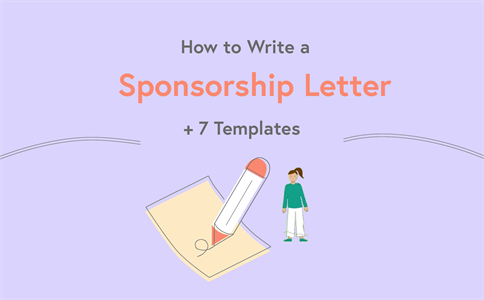

How to Write a Sponsorship Letter (+ 7 Templates)
Sponsorships can take your fundraising efforts to new heights—elevating your events, opening up partnership opportunities and more. They’re all about making lasting relationships with donors.
But how do you kickstart these connections and start bringing in donations that pack an impact? There’s a tried and true tactic: writing sponsorship letters.
Of course, getting sponsorships isn’t as easy as sending out a few letters. But if you’ve already identified some warm leads, had some phone calls and are ready to explore further opportunities with an organization, then that’s where sponsorship letters, and this post, come in handy.
We’ll cover everything you need to know about sponsorship letters: what they are, how to write them, who to send sponsor letters to. Plus, we’ve got samples and templates to get you started!
Read more: Seven Sponsorship Letter Templates For Every Situation
What Is a Sponsorship Letter?
Unlike a standard fundraising letter that asks for donations, grants , contributions, volunteer time, auction items or other gifts, a sponsorship letter has a slightly longer reach.
It focuses on building a relationship with a potential donor and approaches them like a partner, including offering an incentive for their support.
A sponsorship letter typically asks a business or individual to contribute to an event , fundraising initiative or provide long-term support to a non-profit organization. Along with the obligatory tax receipt, the donor will be offered additional benefits for their support, such as priority seating at an event, a speaking slot, or inclusion in event publicity.

What You Give an Organization in Return for Sponsorship
You might be wondering, “But why would a business choose to sponsor us? What can I give them in return?”
But in fact, there are a lot of advantages to charitable giving. In addition to the good feeling that comes with supporting a non-profit organization they believe in, donors have more to gain — especially businesses.
That’s because social responsibility has become increasingly important to consumers, particularly millennials. Research shows that 70 per cent will spend more on brands that support causes.
So, if an organization can demonstrate that they support causes that matter to their customers, they’ll achieve a “halo effect” that will boost goodwill (and potentially sales) for their business.
Other benefits include improving morale among their employees, marketing their brand and strengthening the community in which they do business. Individual donors who are looking to raise their personal or professional profile will also enjoy the perks of being known for their generosity.
Plus, don’t forget that you have a great audience — one that businesses might not be able to reach as easily otherwise. Giving them access to it is something that many businesses don’t mind paying for.
So, what can you offer in exchange for sponsorship? Some ideas are:
- Advertising space in an event program
- Their logo prominently featured in all communications about the event, on social media, etc.
- Public acknowledgement of the donor’s generosity
- Promotional materials included in swag bags or available at event(s)
- An opportunity to speak at an event
- A booth at an event
- Being included on the non-profit’s online ‘Supporters’ list
- A framed “thank you for your support” letter to put up in their office
- Social media shout-outs
- Running a contest at your event or on social media
Want some really out-of-the-box event and sponsorship activation ideas ? Here’s a bonus list that can spark ideas.
Determining Your Sponsorship Letter’s Goals
To reiterate, sponsorship letters shouldn’t be the first point of contact you have with a potential sponsor.
Instead, they should be used to provide more information once you’ve already had an initial contact with the right person at the organization.
Unlike a fundraising letter, the ultimate goal of the sponsorship letter isn’t necessarily to solicit short-term financial support — although that can be part of it. More importantly, you want to sow the seeds for a long-term relationship.
This means you’re appealing to an organization or individual in a way that will demonstrate the value of the work your organization does and outlining how it relates to them and the people they care about. By the end of the letter, you want them to be inspired to be involved in your organization in a way that extends beyond a one-time donation.
In fact, sometimes a potential sponsor can do more for you than make a generous financial contribution. An ongoing sponsorship relationship with your organization will provide a business a steady flow of publicity — and vice versa.
Once you’ve made a connection, there are a few ways you can use a sponsorship letter:
- As a tool for soliciting financial or in-kind support for a specific event or campaign
- As a way to forge a mutually beneficial partnership with an individual or corporate donor
- To request non-financial contributions, such as time, equipment, space or supplies.
Be clear about what you’re asking each donor in a sponsorship letter, why you’re asking and explain what’s in it for them.
In fact, I’ve noticed that some of the most successful sponsorship programs aren’t all about events, even though that’s how many organizations think of them.
By expanding your sponsorship horizons to consider in-kind donations, employee giving, and more, you may find that it’s a lot easier to build a connection with a wider variety of organizations.
Read More: Everything you Need to Know About Virtual Sponsorship for Nonprofits
How to Find Organizations That Are Likely to Support Your Cause Through Sponsorship
The best sponsorship letters I’ve seen are the ones that are highly personalized.
That means before you start writing, you have to do your research.
So, before sending a letter to every business in your town, here are some ways to unearth good potential sponsors:
- Look at organizations that give to nonprofits that are similar in nature to yours . A restaurant sponsors a sports team would be more likely consider your after-school sports program than a business that has never sponsored a team.
- Consider complementary businesses . Look for businesses that operate in the same space you do. If your nonprofit is related to health, look at health practitioners, health-aid suppliers, pharmaceutical companies, etc.
- Check mainstream and social media for people who are passionate about your cause . Some organizations and individuals go all in on certain causes. An Internet search with the right keywords (i.e. those that relate to the purpose of your association and your city or town) can give you plenty of leads.
- Mine the networks of your members, your staff and your board. We know that people are more likely to consider requests of any kind if they come through a person they trust. Ask everyone associated with your organization, plus your family and friends, to help you make a connection with potential donors.
- Shop local. People and businesses generally like to support the organizations and causes that are in their communities.
- Approach businesses that have supported you in the past. This one seems like a no-brainer, but sometimes associations overlook current or past donors for sponsorship opportunities because they already give in a different way. Give them options!
- Look for companies with robust corporate social responsibility programs. Many employers empower their employees to give back in their communities via things like paid volunteer time and donation matching. Throw your organization into the ring!
- Connect with people who benefit from your association. Ask them to provide potential donors in their network. They would be able to do the initial outreach to offer a personal reason for donating. You can follow up with a great sponsorship letter.
- Consider your suppliers or vendors. Anyone your association pays for goods or services may feel a personal connection to your cause and organization. They’re prime candidates for sponsorship.
Read More: How to Solicit Corporate Sponsorships The Right Way
10 Best Practices for Writing Sponsorship Letters
So, you’ve collected your list of recipients. You’ve made a lot of phone calls, and have made a few contacts. Now it’s time to whip out your pen (or laptop) and get to writing!
To keep you from staring at a blank page for too long, here are some best practices.
1. Use the sponsor’s name
Since sponsorship is all about building relationships, writing “To Whom This May Concern” just won’t cut it. Find out the right person within the organization who should receive the letter by calling to ask who makes decisions about corporate donations, or by looking through their website and using an email scraper like Hunter to get their contact information.
2. Get the personalization details right
It should go without saying, but double check that you’ve got the correct spelling of their name. Don’t assume it’s Joseph Smith – it could easily be Josef Smythe. When you’re asking for the proper spelling, ask what name they mostly go by. Maybe Joseph is actually Joey to most people.
3. Tailor your sponsor letter
There are no long-term relationships that began with a form letter. You don’t have to write every word of every letter from scratch, but you should at least write a tailored opening that demonstrates you know something about them. “As a small business that gives back to [XYZ charities], it’s clear that you care about community…”
4. Keep it short
Be respectful of their time by keeping your sponsorship letter to one page and use shorter sentences and smaller paragraphs. Studies show that people will put off what they can’t read in under 1-3 minutes.
5. Put Yourself in your sponsor’s shoes
You know what you want (sponsorship), but a good letter considers the recipient first. Now that you’ve had the chance to speak with them, you should know: what do they want? A way to give back to their community? A simple way to get their brand name out there? To benefit from the halo effect? To give their employees a way to give back? A chance to show their customers that they care about the cause? Write for them.
6. Write the letter from leadership
Make sure the letter is signed by the president or an executive of your non-profit so your recipient can feel assured that it’s professional and legitimate. Include your charitable registration number too.
7. Get someone your sponsor knows to write the letter
Getting someone the recipient of your letter already knows to write the letter will make them more likely to read it than if it comes from a faceless organization. Even if you’ve already made a connection with them, it never hurts to remind them of their personal — and of the impact to someone who’s already in their network.
8. Give sponsors choice
When you get to the part about sponsoring, offer a number of ways to be involved with your organization. Let them know you’re open to all kinds of partnership possibilities.
9. Include the benefits of sponsorship
Don’t forget to list the ways a sponsorship will benefit them. Offer listings on your event or regular communications material, include logos on advertising and swag, give them a table or VIP access to an event or special mentions on all fundraising campaigns. Think about what they would want and create a tailor-made appeal.
10. Include a follow up to your sponsorship letter
You can’t expect every recipient to be immediately inspired to write a check or pick up the phone to make a donation. The sponsorship letter is the first communication on the road to building a relationship. Be sure to include follow-up information, i.e. how they can reach the right person in your association. If it’s appropriate, assure them that you will follow up in another way. (And then make sure you do follow up by phone or email.)
Read More: 4 Ways Small Nonprofits Can Leverage Corporate Philanthropy
Seven Sponsorship Letter Templates For Any Situation
So now that you’ve decided who you’re reaching out to and know what to include, here are examples of several different kinds of letters you might decide to write. Click here to download all of the templates, or keep reading to view our examples.
1. General Sponsorship Letter
Adapt this template for use in any situation where you’re seeking sponsorship.
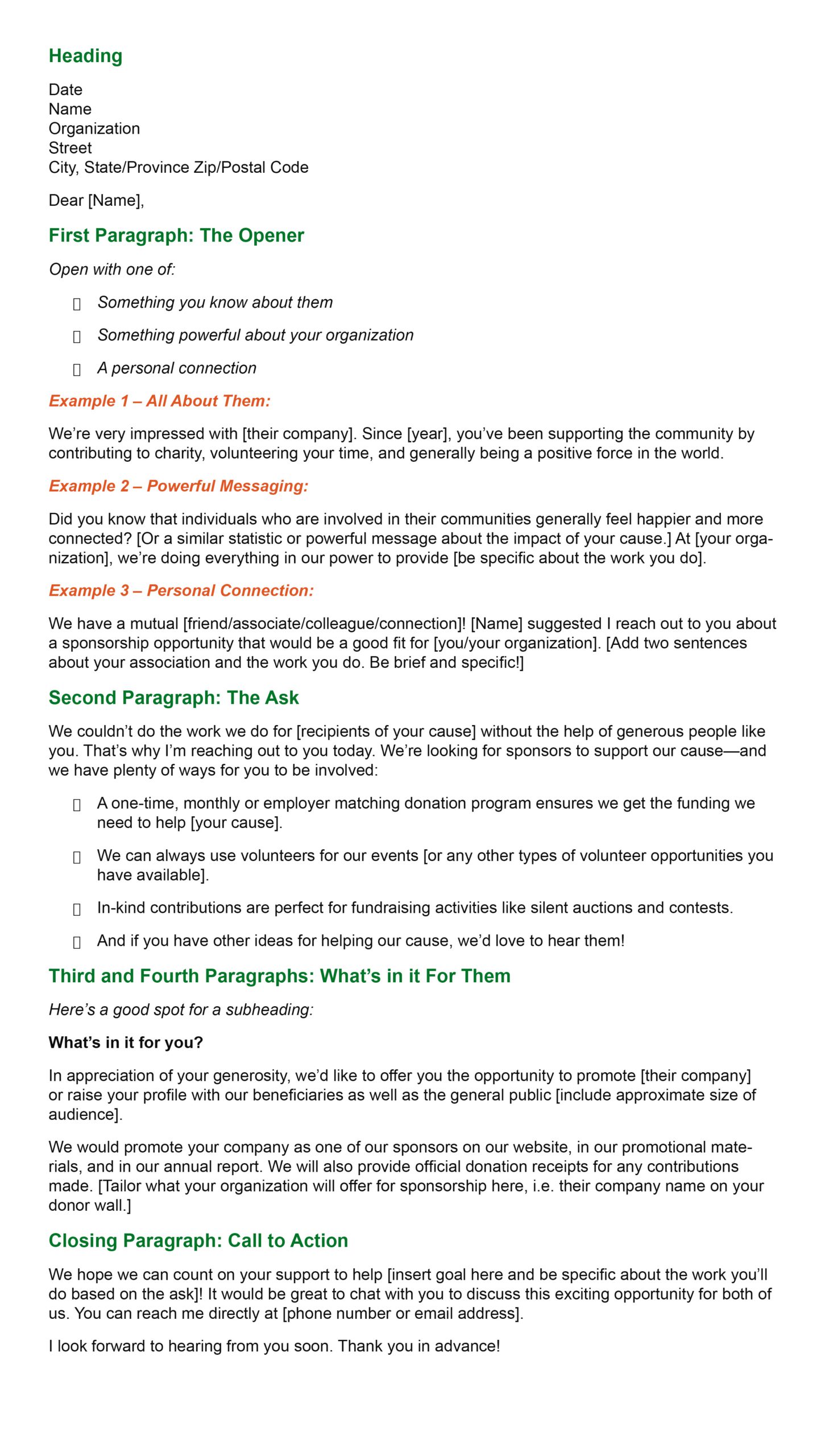
2. Event Sponsorship Letter
Looking for event sponsors? Here’s the template for you!
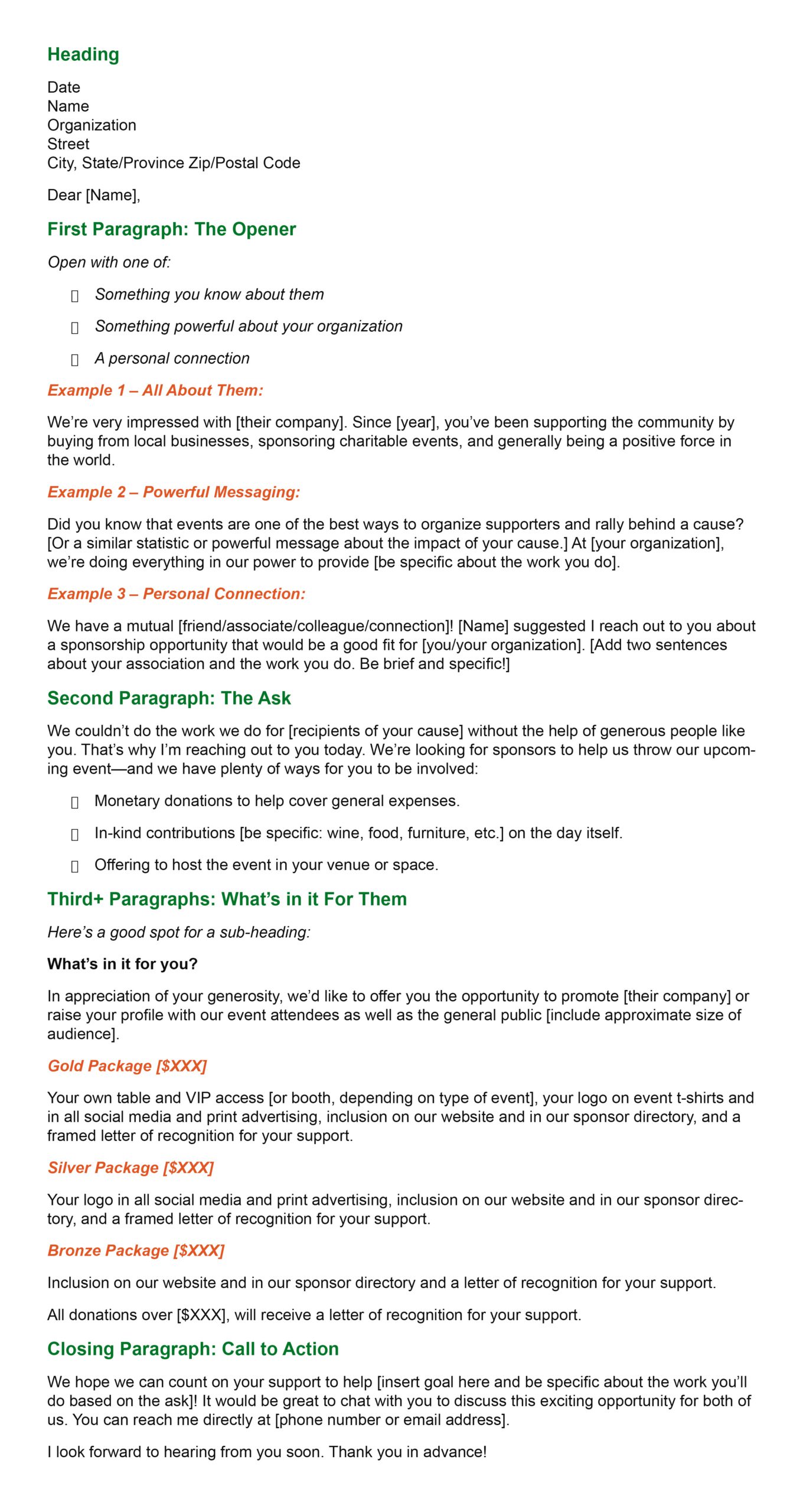
3. In-Kind Donations Sponsorship Letter
If you want in-kind donations , this is the letter to use.
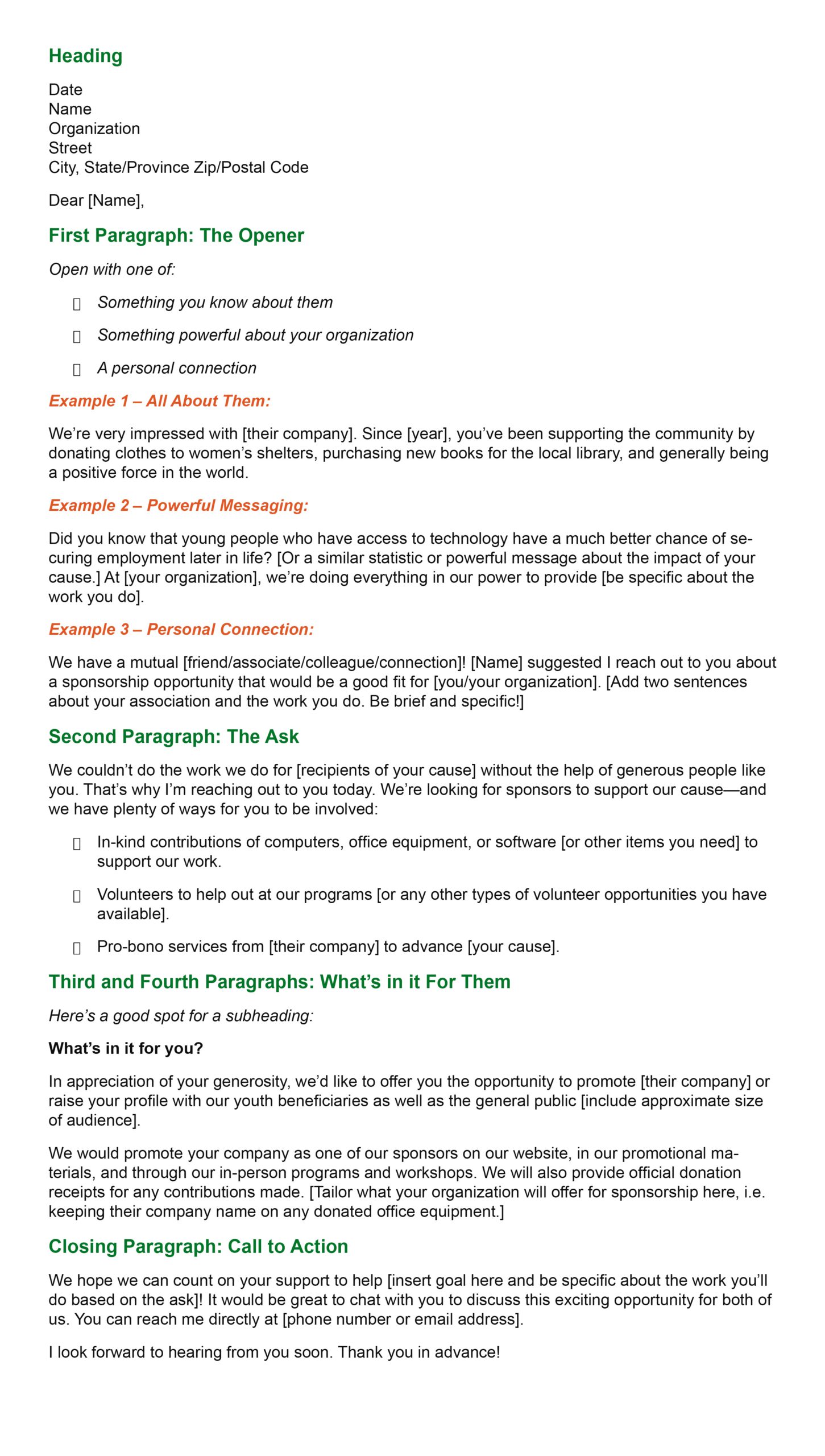
4. Food Donations Sponsorship Letter
Looking for food donations from a cafe or restaurant for your next event or volunteer gathering? Check out this template.
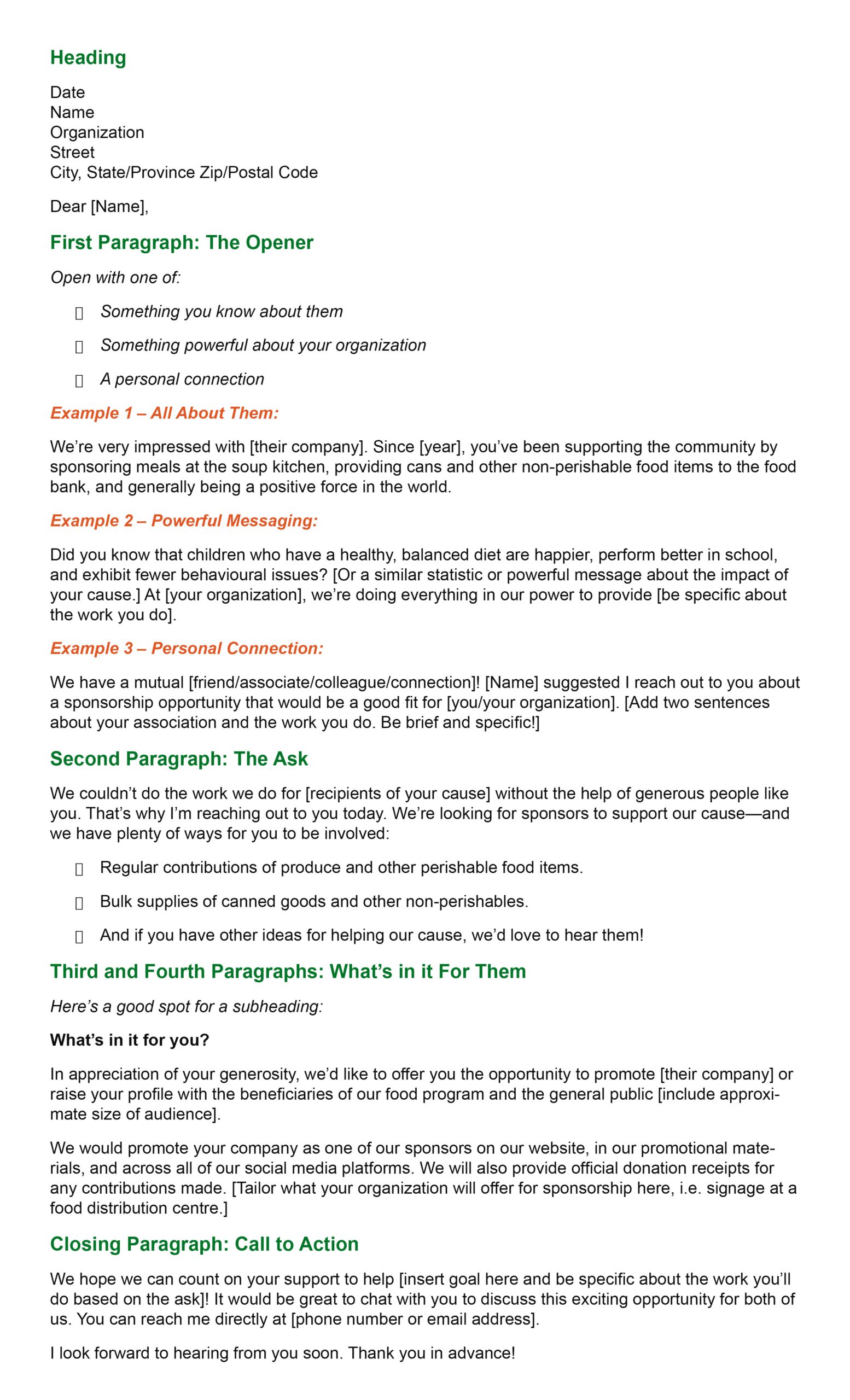
5. Sports Teams Sponsorship Letter
Is your sports team looking for sponsors? Use this letter to reach out.
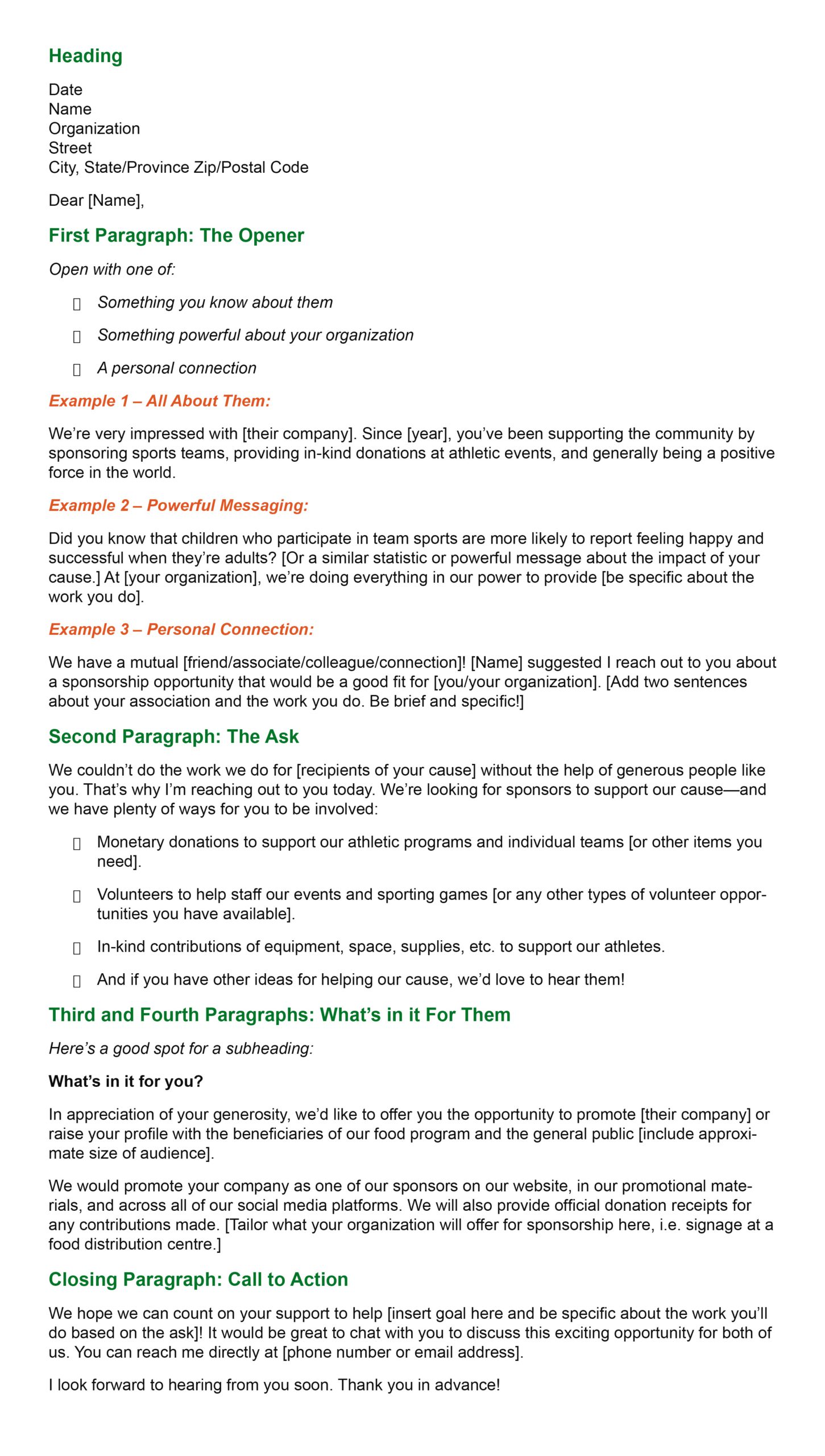
6. Churches Sponsorship Letter
Is your church looking for sponsors? Here’s the letter for you.
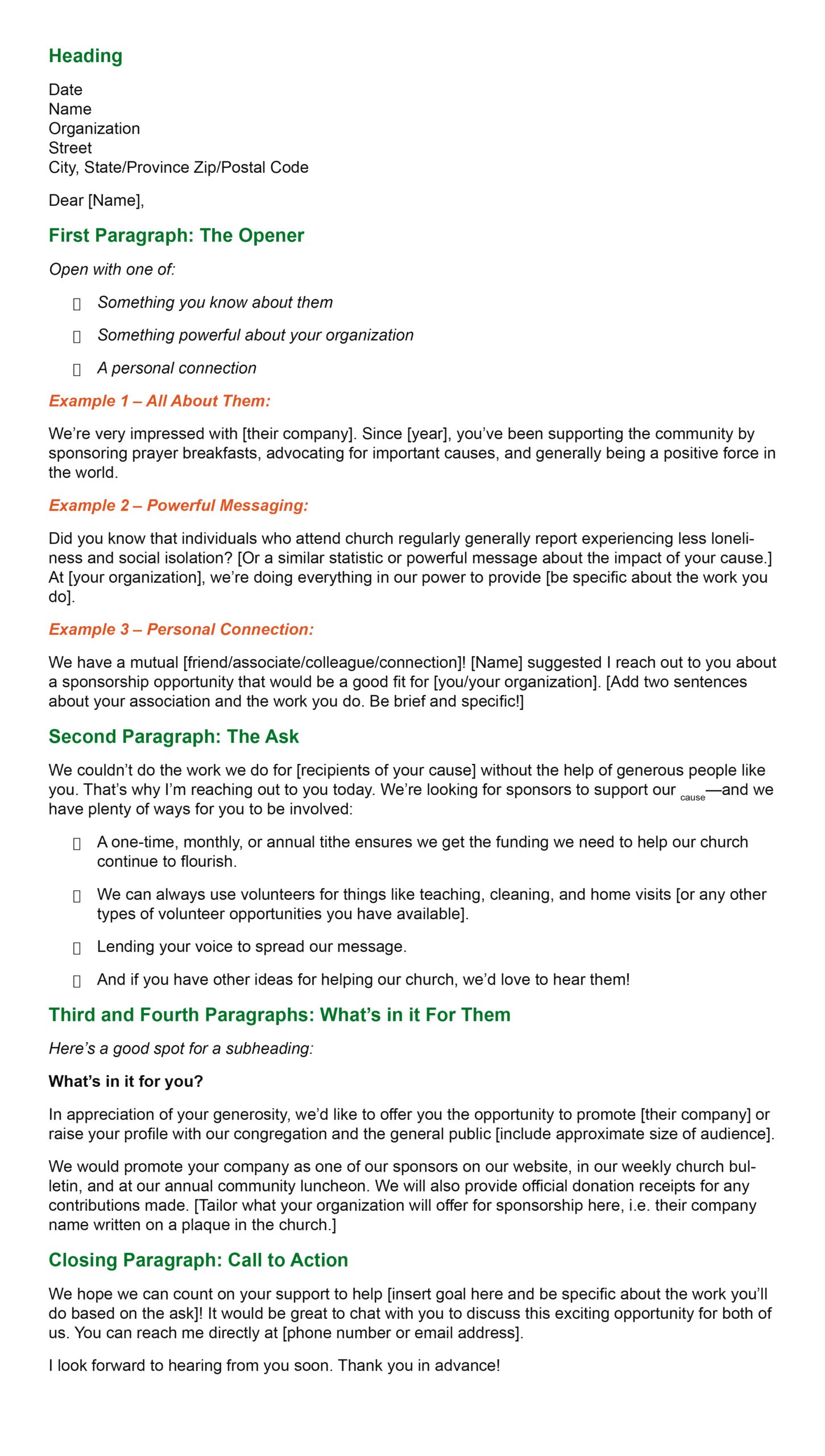
7. General Follow-Up Letter
If you haven’t heard back from your potential sponsor and want to check in, here’s a template you can use.
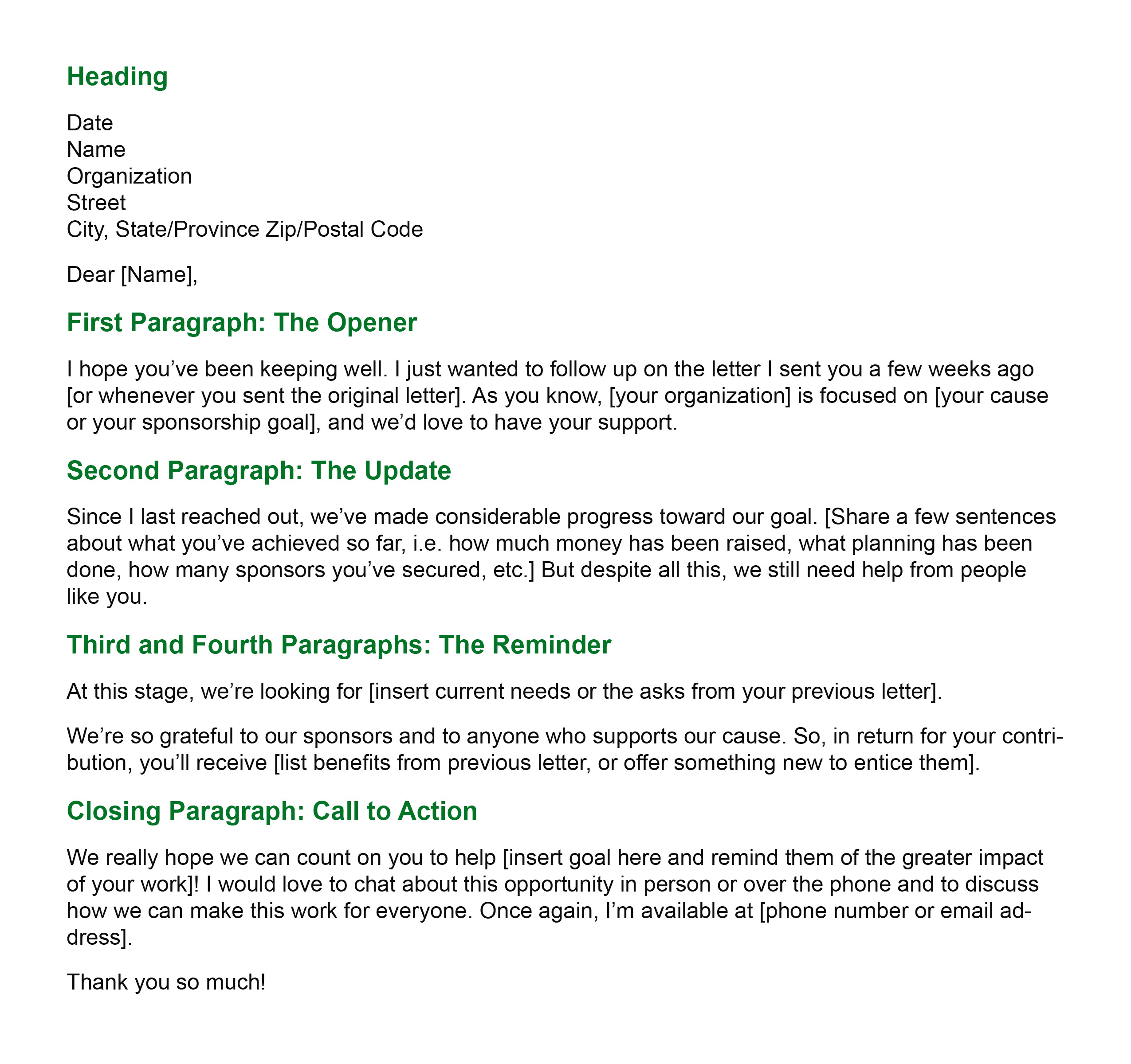
And there you have it: everything you need to know about sponsorship letters.
It may seem like a lot of work, but targeting the right people with the right offer is more likely to result in meaningful support from individuals and corporate sponsors — leading to more donations down the road.

Related Fundraising Articles

Donor Engagement Strategies to Level Up Your Nonprofit + Donor Engagement Plan Checklist!

How to Get Funding for a Nonprofit: Tips on Tapping into 12 Top Funding Sources
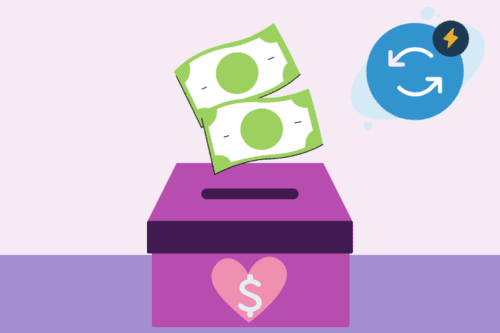
How to Step Up Your Donor Cultivation Strategy: 14 Useful Ideas
The Membership Growth Report:
Benchmarks & insights for growing revenue and constituents.
Repurpose B2B video content with Content Lab.
Write a Sponsorship Request Letter That Works (Free Templates)
Table of contents, what is a sponsorship request letter, sponsorship request - formal letter template, event sponsorship letter - email template, elements of an effective sponsorship request letter, 5 steps for writing an effective sponsorship letter, tips for writing sponsorship requests that get a “yes”, the right sponsorship letter templates are just the beginning, maximize your marketing roi.
Join 10,000 other marketers already getting the best tips on running engaging events that boost pipeline and create raving fans.
Need more sponsors for your next event? It’s time to show them exactly what they’ll get in return.
As the competition for event sponsorship heats up, your sponsorship requests must be specific, need-meeting, and tailored to each potential sponsor on your list.
But with a million other tasks to juggle in the days leading up to your event, that’s easier said than done.
In this article, we’ll share the latest best practices to help you secure more event sponsorships, plus a done-for-you sponsorship request sample letter and email template to help you seal the deal.
A sponsorship request letter is a formal proposal that individuals or organizations create to ask for financial support or in-kind sponsorship for their events. It outlines the benefits, exposure, and recognition potential sponsors can expect in return for their support. It may also include details on available sponsorship tiers, packages, and other incentives.
[Just want the templates? Download now and start customizing. ]
[Your Name] [Your Position] [Your Address] [City, State, Zip Code] [Email Address] [Date] [Sponsor’s Name] [Sponsor’s Position] [Sponsor’s Address] [City, State, Zip Code]
Introduction Dear [Potential Sponsor’s Name],
My name is [Your Name] and as the [Your Position] at [Your Organization’s Name], I am a big believer in your work [reference specific projects or initiatives the recipient is responsible for].
Description
As you may know, our annual [Event Name] brings together over [number and type of attendees/attendee job titles] to tackle all the latest [challenges, best practices, emerging opportunities, or other key focus areas of your event theme].
There’s a reason companies like [Sponsor Name] and [Sponsor Name] call it the [sponsor testimonial referring to the “can’t miss” nature of the event]. Sponsors at [Event Name] regularly see [add insights into ROI or other key outcomes for sponsors, such as revenue generated, contacts made, etc.].
To maintain our incredible momentum this year, we're seeking the support of businesses that share our passion for [reiterate the purpose of the event] and we believe [Sponsor’s Company Name] would be an excellent fit.
Tiers and packages
We offer several networking and promotional opportunities in return for your support. In addition to displaying your logo and company details in our [event brochures, banners, website, etc.], you will also receive [other benefits such as speaking opportunities, complimentary tickets, VIP networking events, etc.] tailored to your unique business needs.
[list sponsorship tiers and packages]
Of course, not all businesses are the same. You may have specific sponsorship needs or ideas and I’d be more than happy to discuss them with you.
In the coming weeks, my team will reach out to you directly to discuss your company goals and brainstorm custom packages to help you meet them. In the meantime, please feel free to email me at [Email Address] or contact me by phone at [Your Phone Number] to discuss further.
We appreciate your consideration and look forward to working together on making [Event Name] a success.
Sincerely,[Your Name]
Subject: Join brands like [Sponsor Name] at [Sponsor Name] at [Event Name]!
Hello [Potential Sponsor’s Name],
Hope you’re having a great week! My name is [Your Name] and as the [Your Position] at [Your Organization’s Name], I am a longtime fan of work to [reference specific projects or initiatives the recipient is responsible for].
As you might already know, the [Event Name] is the “[sponsor testimonial referring to the “can’t miss” nature of the event]” event for brands like [Sponsor Name], [Sponsor Name], and more.
This year, we’re doing it even bigger and better with exclusive [sessions, masterclasses, or other networking opportunities] focused on [briefly describe the purpose and goals of the event].
Obviously, we think [Company Name] would be a great fit. Your support as a sponsor for [Event Name] would mean increased brand visibility, networking opportunities, and a chance to show your commitment to [event goal or mission] to more than [number and type of attendees/attendee job titles].
By sponsoring [Event Name], [Company Name] could gain access to:
- Visibility in all promotional materials and signage
- Recognition in partner and media coverage
- Access to attendees and networking
- Live shout out during the event
- [add any additional benefits included in your sponsorship packages]
We have sponsorship opportunities to fit a variety of budgets and goals. I've attached a detailed packet with more info and would love to set up a quick phone call to chat more about what might work best for you.
When is a good time to connect?
[Your Name]
[Your Title]
[Your Organization]
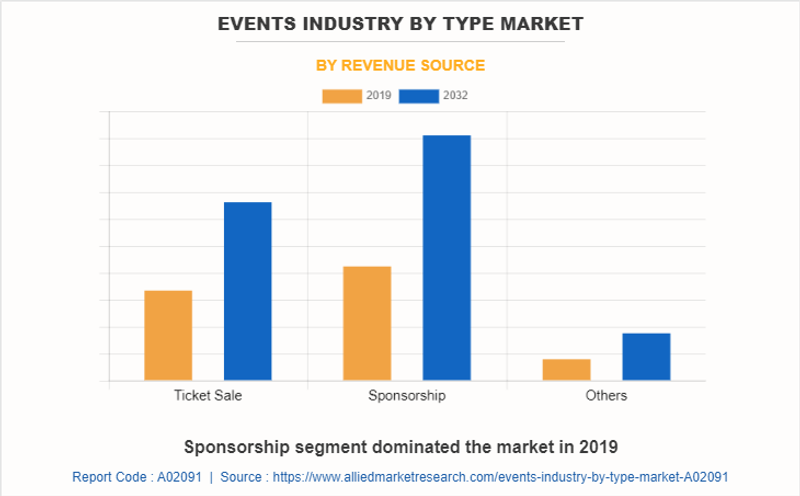
Whether you’re sending your sponsorship letter by post, email, or carrier pigeon, there are a few key elements you’ll want to be sure to include.
Here’s a quick list of everything that goes into an effective sponsorship letter:
- Header and contact information
- Personalized greeting
- Mission-aligned description
- Strong social proof
- Perks and incentives
- Available tiers and packages
- Compelling call-to-action
- Strong closing
Of course, the types of sponsorship letters you send will also depend on the demographics or your audience and the nature of your upcoming event.
For example, if you’re a nonprofit organization making a donation request, your formal fundraising letter will look pretty different from that of a sports team doing outreach for secure corporate sponsorships or a fundraising event featuring a variety of rare auction items.
Whatever the scenario, the ideal sponsorship proposal will quickly communicate what’s in it for your recipient, highlight the key ROI drivers, and inspire complete confidence in your events.

When reaching out to potential corporate sponsors, the primary goal is to make sure the value of your event is crystal clear.
Make sure that every touchpoint in your outreach strategy makes it clear that the event will be well-planned, well-run and well-executed. Potential sponsors should have zero doubt that your event is worth linking their name to.
Ready to draft a corporate sponsorship letter that gets the yes? Let’s break it down, step by step.
1. Start strong
Always start your sponsorship request letter with a personalized greeting that gets your prospective sponsor excited about your event.
Here are a few simple rules to follow:
- Address each potential sponsor by name
- Add details from their LinkedIn profile, social media, or company announcements
- Highlight the event’s mission or “big why” reason for being
- Share a few words on the impact your event has had on your community
The goal is to keep your event description concise and mission-aligned.
It should be clear that your letter has been tailor-made for each potential sponsor, with a clear and unmistakable synergy between their organization’s values and your own.
Remember, a great sponsor is a valued partner—not just another name on a list.
Paint a picture of how their sponsorship will fuel your mission, including the tangible difference they can make for your shared community.
2. Sprinkle in some social proof
Have you hosted successful events in the past? If the answer is yes, save yourself the extra word count and let your existing sponsors do the talking.
You can use past sponsor testimonials to kick off your intro and add credibility to your packages, or even share a longer past sponsor success story to help your recipient visualize the benefits for themself.
No matter how you approach it in your letter, real social proof from real sponsors is always going to be more persuasive than endless paragraphs about all the logo exposure in your promotional materials.
Here are some key ways to add more credibility to your sponsorship request:
- Highlight past success stories : Name drop highly recognizable past sponsors and share examples of times you exceeded sponsor expectations at past events. Include metrics and facts like the number of attendees, social media reach, deals or contacts made, etc., to demonstrate the real-world impact and success of the event.
- Add past sponsor testimonials : Nothing carries more weight than happy sponsors singing your praises. Sprinkle in any glowing testimonials or statements from previous sponsors for an instant boost in credibility.
- Share links to recent press coverage : Include links to any press releases or articles that have covered your events. Address the recognition you received, highlight what’s unique about your event, and cement your case as a trusted event organizer.
- Nod to any awards and recognitions : If your events or company has been honored with awards or special recognition, now’s the time to shout about it.
Remember, your sponsorship request letter is not the place to be humble.
You and your event team have worked hard for your accomplishments. Now is the time to lay it all out on the table so potential sponsors can see that their money will be well spent.
3. Stress the benefits
Depending on the type and format of your event, your sponsors may be financial, meaning they put money towards the event in exchange for certain benefits. Or, they may be providing what’s known as in-kind donations, where they provide products or services for free in exchange for certain benefits.
No matter what kind of sponsors you’re looking for, the answer to the age-old marketing question, “What’s in it for me?” must be clear and irresistible.
Here are some ways to help make sure your potential sponsor understands the tangible benefits they’ll get from your event:
- Share all the ways in which the sponsor will be promoted at the event
- Put actual numbers to the reach and visibility they’ll receive
- Include perks and incentives beyond brand exposure, such as attendee lists, engagement data, and more
By going above and beyond the standard event sponsorship offering to include not only branding opportunities , but also dedicated sponsor booths and data packs including the full registration list and attendee engagement information, you can set your sponsors up to capture more ROI from your event.
This is especially beneficial for digital business events, where sponsors are looking for more opportunities to grow the connections made.
“The analytics part of the events right after it makes it really fast for us to contact the sponsors with this is who attended, who didn't attend, attendance rate, the questions asked, and what people clicked on,” said Eduardo Duarte Ruas , Marketing Manager at Modern Sales Pro. “Goldcast makes it really easy for us to collect the data and create a follow-up to the event that is very seamless and very fast.”
Eduardo and the team at Modern Sales Pro run 176 webinars with 25 sponsors per year. And they go far beyond the cookie-cutter sponsorship package with each and every one.
In addition to deep attendee data packs, he also puts together a “year end wrapped” style email for each sponsor with all the event data, plus eye-catching video snippets pulled from the event .
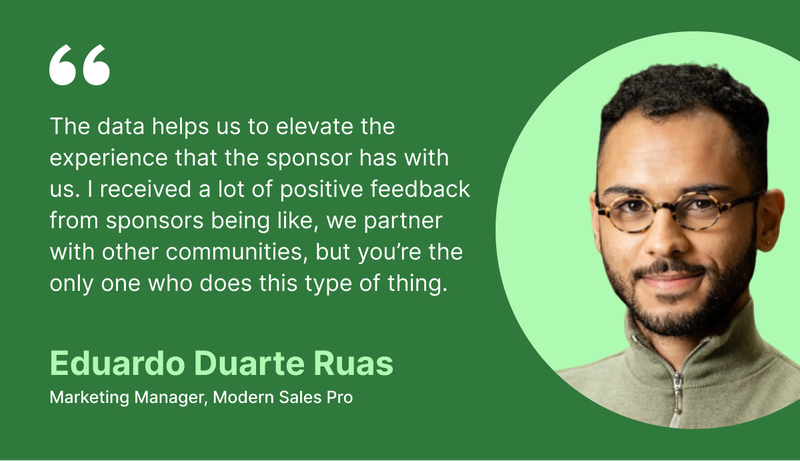
4. List the available sponsorship levels
Gold, Silver, Bronze. Tiers one, two and three. Potential sponsors have seen it all before.
Challenge yourself to think of new ways to name your sponsorship packages to stand out in a sea of other sponsorship requests.
Here are a few tips to communicate your packages effectively:
- Be specific about what’s included in each tier , sponsorship level, or package
- Share details on how payment is made
- Highlight the packages that offer the most valuable opportunities, such as dedicated booths or VIP networking opportunities
Last but not least, don’t make vague requests.
While it’s always great to leave the door open for conversations around custom sponsorship packages, you also need to make sure potential sponsors are empowered to make a decision right there and then via a clear CTA.
5. Finish strong
Wrap it all up with a heartfelt thank you .
At the end of the day, your recipient has taken the time to consider your request for sponsorship—that’s no small thing.
Express gratitude and remind them of the next steps you want them to take:
- Sign off while thanking the recipient for their future support
- Remind them of your shared values to help deepen their commitment to your cause
- Use a compelling call-to-action that lets them know exactly what to do when they finish reading your letter
- Include your contact information and an open invitation to connect and discuss how they can become an active part of your event.
Once you’ve inspired them to get involved, make it easy by providing a clear path forward.
[Goldcast makes it easy for event organizers to manage tiered sponsor booths, including custom logo placement, branding and video. Learn more with a free trial! ]
Once you’re done drafting your sponsorship letter, it’s time to pull out the fine-toothed comb and get ready to proofread.
Here are a few best practices to make sure you’ve nailed it.
1. Research your potential sponsor
Dive into the company's background to understand their target audience and industry positioning so you can establish key points of connection between their business and your event.
2. Align your event with their goals
How can your event advance your prospective sponsor’s goals? Identify the mutual benefits and present a clear answer to the perennial question: “What’s in it for me?”
3. Use a personalized approach
Your letter should never sound generic. Address the recipient by name, reference their specific projects or initiatives, and share a compelling and authentic reason for why their company would be a perfect fit for your event.
4. Be clear and concise
Keep your sponsorship letter easy to read and digest. Use concise language, break up the text with bullet points or small paragraphs, and ensure your each benefit is clearly communicated.
5. Follow-up
You’ve heard it before: the money is in the follow-up. While your initial letter is important, following up can be just as impactful. Be respectful but persistent in maintaining contact, pointing to the clear benefits of what’s in it for them with every touch. This goes for after your event, too. Sending a simple thank you letter to sponsors after the event can be a great way to encourage repeat sponsorship year after year.
It might sound counterintuitive, but a great sponsorship request letter does a whole lot more than ask for money. It gives potential event sponsors a clear understanding of your event—including its purpose, audience, and of course, the biggest benefits for them.
When you’re ready to offer a sponsor experience you can be proud of, Goldcast can help.
Goldcast’s digital event platform makes it easy to offer all the features sponsors want to see at a digital or hybrid event, including next-level branding, one-on-one networking opportunities, and dedicated booths.
After your event, use Goldcast’s Content Lab to generate high-impact videos to fuel your post-event coverage and win more sponsors for your next event.
![how to write letter of sponsorship [object Object]](https://cdn.sanity.io/images/2939l4aj/production/194d75a4fafd3544f47360ec95e245928cf8b375-1200x350.png?w=800)
Stay In Touch
© 2024 Copyright Goldcast, Inc. All rights reserved.
- Asking for Donations
- Fundraising
How To Write a Sponsorship Letter (+ Templates)
By Whit Hunter on March 20, 2024
Want to build an effective fundraising campaign?
Our team is here to give you more details and guides on how to grow your fundraiser.

Writing a sponsorship letter can seem tough, but it's an excellent way to get backing for your event, project, or organization. In this blog, we'll walk you through how to write a clear and effective sponsorship letter.
We've also included templates to make it easier for you. You'll learn how to reach out to businesses or individuals in a way that grabs their attention and helps you get the support you need.
Let's find out how to create a letter that leaves a lasting impression.
What Is a Sponsorship Letter?
When we're talking about how to write a sponsorship letter, it's key to understand what a sponsorship letter actually is.
In short, a sponsorship letter is a type of letter you write to ask someone or a company to support an event, activity, or project . The support can come in different forms, like money, products, or services.
Sponsorship letters are not just about asking for help. They play a big role in creating strong connections between people or groups.
Think of them as bridges. When you reach out with a sponsorship letter, you're not only seeking support but also offering a chance to work together. It can lead to a partnership where both sides benefit.
You get the support you need, and the sponsor gets to be part of something positive, often getting their name out there in a good light.
Preparing to Write Your Letter
Before you start writing your sponsorship letter, you need to do some homework. Let's break it down into two main parts:
1. Researching Potential Sponsors
The first step is to look for businesses or people that make sense for your project or event. You want to find sponsors whose interests and values match up with what you're doing.
For example, if you're organizing a local sports event, companies that sell sports gear or promote healthy living might be a good fit. Or, if your project is all about art, you might look for businesses that have supported art shows or community arts programs in the past.
This research helps you find sponsors who are more likely to be interested in what you're offering because it matches their mission and past activities.
2. Understanding What Sponsors Look For
Now, think about what these potential sponsors want. When a company decides to sponsor something, they're not just giving away their money or products for nothing. They're looking for something beneficial in return.
It could be positive publicity, a chance to reach more customers, or a way to show that they care about certain issues or communities. Your job is to figure out how your event, project, or activity can offer these benefits.
It's also important to understand that sponsors want to see their values and interests reflected in what they sponsor. For instance, a company that's all about environmental sustainability will be more likely to support eco-friendly events or promote green living.
Components of a Successful Sponsorship Letter
Once you've done your research and understand what your potential sponsors are looking for, it's time to start writing your letter. But not just any letter.
To really grab their attention and get them to consider your request, your sponsorship letter needs to have certain key parts. Let's walk through what makes a sponsorship letter successful.
Personalizing the Letter to Focus on the Sponsor
First things first: write a letter about them, not just you. Instead of starting off talking about your needs, begin by mentioning something you admire about their company or a recent achievement of theirs.
Shows that you've done your homework and you're not just sending the same letter to a bunch of different companies. It's like saying, "Hey, I see you and what you're doing, and I think we could do something great together."
Keeping the Letter Concise and to the Point
Your letter should be like a good conversation – engaging but not dragging on forever. Keep it short and sweet, sticking to one page if possible.
You want to make your point without losing their interest. So, focus on the essential information: who you are, what you're asking for, and why they should consider your request.
Highlighting the Mutual Benefits for Both Parties
This part is crucial. Your letter should clearly explain what's in it for them. Remember, sponsorship is a two-way street.
Talk about how sponsoring your event or project can benefit them, whether it's through positive publicity, reaching a new audience, or associating their brand with a good cause.
Make it clear that you're offering them value, not just asking for a favor.
Providing Clear and Specific Details About Your Request
Be clear about what you're asking for. Are you looking for financial support, products, or services? How much or how many? Then, explain exactly what their sponsorship will help to achieve.
Will it fund an event that brings the community together? Will it support a program that helps young people learn new skills? The more specific you are, the easier it is for them to understand the impact of their contribution.
Want to raise more Donations? Try BetterWorld’s Donation Tool for FREE!
Simplify donations with customizable default donation amounts
Streamline your processes and keep online and offline donations in one place
Engage with your donors with automatic updates
Give your donors the ability to donate once, monthly, or annually
Importance of a Clear Call to Action and Expressing Gratitude
Two of the most critical elements in your sponsorship letter are your call to action and your expression of gratitude. Your call to action should be easy, telling the potential sponsor exactly what step you want them to take next.
Just as important is saying thank you. Even if they haven't agreed to anything yet, thanking them for their time and consideration shows that you value their potential support.
It leaves a positive impression, which can make them more inclined to help now or in the future.
Writing Your Sponsorship Letter
Now that we've covered the key components of a successful sponsorship letter, let's explore the step-by-step process of writing it.
- Address the letter to a specific person if you can. Using someone's name, like "Dear Mr. Smith" or "Dear Ms. Johnson," makes your letter feel more personal and shows you've taken the time to research who you should be talking to.
- Quickly tell them who you are and what you're working on. It sets the stage for the rest of the letter.
- Here's where you talk about why you're writing to them specifically. Mention any connection to their company's values, past sponsorships, or interests that make them a good fit for your request.
- Be clear and specific about what kind of support you're looking for.
- Explain how sponsoring your project or event can benefit them.
- Give them the specifics of your event or project. Include dates, locations, and what their sponsorship will help you accomplish.
- Express your gratitude for their consideration and include a clear call to action. Tell them exactly what you want them to do next, whether it's to reply to your letter, call you, or visit your website for more information.
- End your letter with a polite closing, like "Sincerely" or "Best regards," followed by your name and contact information.
Templates and Examples Of a Sponsorship Letter
After learning about the ins and outs of writing a sponsorship letter, you might be ready to start crafting your own. But staring at a blank page can be daunting, right?
That’s where templates and examples come in super handy. To make things easier for you, we've put together 3 editable templates. Each is tailored to a different type of sponsorship or event.
General Nonprofit Event Sponsorship
Subject: Partnership Opportunity: [Event Name]
Dear [Sponsor's Name],
I hope this message finds you well. I am writing to you on behalf of [Your Organization's Name], a nonprofit dedicated to [Brief Description of Your Mission]. We are currently planning an event, [Event Name], which aims to [Briefly Describe Purpose of Event].
We believe that [Sponsor's Company] shares values similar to ours, especially in [Mention a Specific Area of Interest/Value]. We are reaching out to see if you would be interested in sponsoring our event.
Your support would be incredibly valuable to us, and in return, we can offer [Mention Specific Sponsorship Benefits, like Logo Placement, Speaking Opportunities, etc.].
Enclosed, you will find a detailed proposal of the event and the different sponsorship levels. We are excited about the possibility of partnering with you to make a significant impact.
Thank you for considering this opportunity and I look forward to working together.
[Your Name] [Your Position] [Your Organization's Name] [Contact Information]
Charity Fundraiser Sponsorship
Subject: Join Us in Making a Difference: [Fundraiser Name] Sponsorship
Good day! We're reaching out from [Your Organization's Name], where we strive to [Organization's Mission]. We are organizing a fundraiser, [Fundraiser Name], to support [Specific Cause or Project], and we need your help.
Your company, [Sponsor's Company], is known for its commitment to [Related Community Service or Value]. This is a great opportunity for your brand to be seen supporting a noble cause.
In return for your sponsorship, we can offer [Specific Benefits, like Media Exposure, Event Booth, etc.].
Please find attached a proposal outlining the event details and how your sponsorship can make a difference.
Thank you for considering this request. I am here to discuss how we can partner together for a successful fundraiser.
Best regards,
Educational Program Sponsorship
Subject: Support Educational Excellence: Sponsor [Program Name]
I am writing from [Your Organization's Name], where our mission is to [Brief Description of Mission]. We are launching an educational program, [Program Name], designed to [Objective of the Program]. To make this program a success, we are seeking sponsorship from dedicated companies like [Sponsor's Company].
Your support can help us [Briefly Describe the Impact of the Program]. In appreciation of your sponsorship, we offer [List Sponsorship Benefits, like Logo on Materials, Mentions in Press Releases, etc.].
Attached is a proposal with more details about the program and how your company can help. We believe that your support will make a significant difference.
Thank you for considering this opportunity to impact our community positively. I look forward to the possibility of partnering with you.
Warm regards,
Tips for After Sending Your Sponsorship Letter
After you've sent out your sponsorship letter, the work isn't over yet. Here’s what to do next. These tips will help you follow up with potential sponsors and keep the communication going.
- Give your potential sponsors some time to read your letter. If you haven't heard back in 1-2 weeks, send a polite follow-up email or make a phone call.
- When you follow up, keep your tone friendly but professional. Show your appreciation for their time and consideration.
- Sometimes, sponsors want to talk more about your event or cause. Be ready to answer their questions and share more details.
- Even if they haven't said yes yet, keep potential sponsors updated on your progress. It shows them you're active and committed.
- When you get a sponsor, thank them on social media. It shows appreciation and can encourage others to sponsor too.
- Talk about your event or cause on social media. Share pictures, stories, and why it's important. Tag potential sponsors to get their attention.
- Sometimes, the best way to meet sponsors is through people you know. Ask friends, family, or colleagues if they can introduce you to potential sponsors.
- Use social media to host a Q&A session. Talk about your event or cause and answer questions. It can get more people interested, including sponsors.
- Whether it's through emails, social media, or meetings, keep all your sponsors and potential sponsors updated on your plans and progress.
The Power of Sponsorship Letters
Sponsorship letters are a powerful tool. They're not just about asking for help, they're about creating partnerships. These letters can open doors to new possibilities for your event, cause, or project.
They bring together organizations and individuals who share common goals. And, when done right, they can have a huge impact.
Remember, each letter is a chance to tell your story, to share your passion, and to invite someone to join you in making a difference. So, take what you've learned, use these strategies, and start reaching out.

Join 85,000+ amazing nonprofits, organizations, and fundraisers on BetterWorld
Let our FREE fundraising tools help you raise more funds with less effort
Get started on your next campaign
Related posts.

What Is a Nonprofit Brand Ambassador Program?
Discover how a nonprofit brand ambassador program can boost your mission, engage your most passionate supporters, and extend your reach across new audiences.

8 Fundraising Flyer Tactics That Drive Donations
Discover 8 game-changing fundraising flyer tactics that'll supercharge your donation efforts in no time! From uncovering hidden strengths to mastering killer promotion tactics, this guide has everything you need to create flyers that'll have people opening their wallets faster than you can say "donate now."

What Is a Donor Centered Fundraising?
Discover the basics of donor centered fundraising, learn how it can transform your nonprofit's approach, and explore strategies for building stronger donor relationships.
Start a Fundraiser
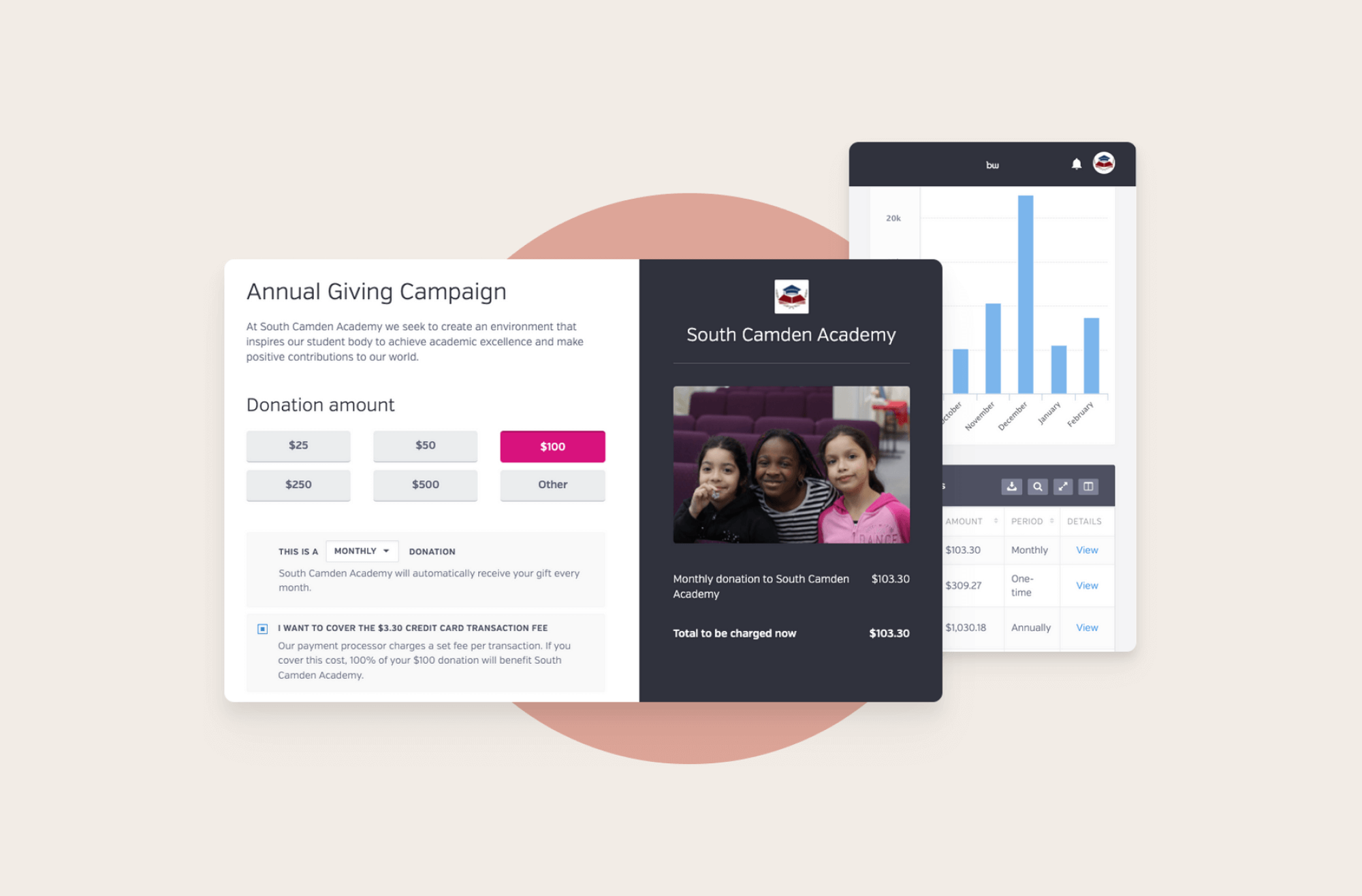
Raise more funds with less effort with BetterWorld's free, easy-to-use online donation tools.

Crowdfunding
Create engaging crowdfunding pages that receive donations quickly & securely

Peer to Peer
Our free platform will help you easily organize and host a successful peer-to-peer campaign

Sponsorship Letters: What You Need To Say & 17 Templates
If your team is considering requesting sponsorship from a local business, a sponsorship letter is a good way to explain your cause while also proposing how this partnership will benefit both parties.
Sponsorship Letters: The Basics
It can be difficult for nonprofits to come up with new fundraising ideas, especially if you’ve been in the nonprofit world for a while. Walk-a-thons and fundraising galas are great options, but some organizations may be looking to switch it up. That’s where sponsorships come in.
Sponsorships allow you to build relationships with people in your community and receive their support in return. While it can be nerve-wracking to ask for sponsorship, these letter templates will simplify your asks and empower you to raise more for your cause.
What Is a Sponsorship?
A sponsorship is a mutually beneficial partnership where one entity receives financial support while the sponsor organization earns the opportunity to earn some sort of incentive or recognition.
For instance, a nonprofit organization can request sponsorship from a corporation for an upcoming fundraising event. The corporation will agree to help fund the event in exchange for favorable publicity as well as a positive association with a charitable organization.
Sponsorship proposals can provide a huge chunk of the funds for fundraising events like walks, runs, galas, and more. But you don’t have to be a nonprofit charity to request one. Many sports teams, schools, and other organizations also depend on sponsorships to help them reach their goal!
Regardless of what your organization is, your sponsorship letters should always include a description of your cause, the budget for your project or event, and some sort of incentive. It’s helpful to offer your proposals early in the planning process and to be very direct in them, so that sponsors know immediately what you need and how their support will help.
Remember to outline exactly why this partnership will benefit the sponsoring party as well. If you’re requesting sponsorship from individuals, try to reach them emotionally and let them know how their contribution will truly make an impact.
Whether you help run a nonprofit and need funds to launch an event, or you coach a sports team and want new uniforms for your kids, or you’re the principal of a school and are planning a big dance, sponsorships can provide a steady source of revenue—as long as you meet your end of the partnership as well.
These templates provide guidance if you’re feeling lost as to where to start, or just want to make sure you’ve included all the pertinent information. We have templates for any type of sponsorship letter you might need to write, no matter what type of organization you’re involved with.
What Are Sponsorship Letters?
Sponsorship letters are letters nonprofits send to people or companies to request their sponsorship. While you may send a general sponsorship ask, many nonprofits seek sponsorship for specific events, programs, or initiatives.
For example, sponsorship proposals can provide a huge chunk of the funds for fundraising events like walks, runs, galas, and more. However, you don’t have to be a nonprofit charity to request one. Many sports teams, schools, and other organizations also depend on sponsorships to help them reach their goals!
What Elements Should A Sponsorship Letter Include?
Regardless of what type of organization you’re a part of, your sponsorship letters should always include:
- A greeting. Start off by greeting your potential sponsor like you would for any other type of letter. Remember to address each recipient by name to personalize your ask.
- A description of your cause. Make it clear what your organization does and how sponsorship will help you fulfill your mission. That way, potential sponsors can decide if their values align with your nonprofit’s cause.
- The budget or goal for your project or event. Be specific about how much money you’re looking for from your sponsorship. Having a concrete amount will make it easier for potential sponsors to consider your ask.
- An incentive. It’s best to let potential sponsors know right off the bat what they’ll get in return for their support. For example, you may choose to add their name or company on signage and promotional materials for your next event.
- Call-to-action. After reading your letter, potential sponsors should know exactly what you’d like them to do and how they can take that next step. Provide them with your contact information so they can get back in touch.
- A closing. To complete your letter, have someone on your fundraising or leadership team sign off. Express your gratitude for the recipient’s future support.
It’s helpful to offer your proposals early in the planning process and to be very direct in them so that sponsors know immediately what you need and how their support will help.
These templates provide guidance if you’re feeling lost as to where to start or just want to make sure you’ve included all the pertinent information. We have templates for any type of sponsorship letter you might need to write, no matter what type of organization you’re involved with.
Nonprofit Sponsorship Letter
International nonprofit sponsorship letter, small nonprofit sponsorship letter, sponsorship letter for charity event, church sponsorship letter, sponsorship letter for event, sponsorship letter for k-12 schools, sponsorship letters for colleges and universities, sponsorship letters for sports team, sponsorship letters for animal shelters, sponsorship letters for museums.
Sponsorship Letters for Theatres
Corporate Sponsorship Letter
Thank you letter to sponsors for donations, event sponsorship thank you letter.
Subject: [nonprofit’s name] need your help!
Dear [sponsor’s name],
We at [nonprofit’s name] work hard each year to provide [positive impact of nonprofit] and improve the lives of [relate this to your nonprofit’s mission].
Currently, we are working hard to raise [fundraising goal] in order to [specific nonprofit goal, for example: host this next event, bring food to this many homeless people]. That’s why we are currently looking for sponsors to help us reach our goal.
Would you be willing to help us by sponsoring our project with [a specific donation amount or a percentage of the total expenses]? We can offer you [incentive, for example: recognition in our project’s printed materials and signage].
Your generosity means the world to us. The support from our sponsors helped us host our most successful event yet, [past event and description], where we [achievement of event, for example: a record-breaking amount of money] for our mission. If we raise that same amount this year, we can accomplish [physical impact of nonprofit mission]. Imagine what we can do with your help!
We would love to discuss a relationship for the future, so please contact us if you’d like to get involved or have any questions about our organization.
Thank you so much!
[nonprofit’s name]
[phone number]
Key Takeaway from This Sponsorship Letter
When nonprofits ask for sponsorships, it’s important that the rules and specifications for the sponsorship are clearly laid out so the other parties understand exactly what they’re asking for. Clearly state how exactly a sponsorship with your nonprofit will impact your mission. Give concrete examples of how past sponsorships have generated considerable amounts of support for your projects or events.
Make sure to also include a compelling incentive and reason for prospective sponsors to commit to you. State out exactly how your nonprofit will help grow their brand, and they’ll be sure to want to sponsor you.
Subject: [nonprofit’s name] needs your help from overseas!
My name is [name] and I work with [nonprofit’s name] in [international location]. Though you may not have heard of our organization, we have over [amount of staff] and raise [yearly fundraising revenue in dollars] each year to help bring awareness to and support [nonprofit mission].
Currently, we are working hard to [nonprofit goal or upcoming project] and are in the process of raising money to support it. If we raise [fundraising goal], we will be able to provide [physical impact coming from donations]. So far, we are [amount of money] away from our goal and hope to reach it with the help of people like you.
Even though you are far away, we know that you can make a difference if you decide to sponsor our organization. With [specific amount], you can help [nonprofit’s name] continue to [specific action nonprofit does].
To thank you for your generous contribution and support, [nonprofit’s name] would like to offer you [incentive] in exchange for your sponsorship.
If you help run an international nonprofit and you’re looking for sponsorships from supporters abroad, you need to clearly explain what your nonprofit is and the goals your team is working for. Because your organization is based in a different country, your mission may not be as well known. Make sure to emphasize the good your organization is doing with specific examples to show potential sponsors.
Give them a reason to sponsor your nonprofit instead of a similar one where they live— mention what makes your organization different from others or provide incentives that’ll attract sponsors to you.
Subject: Are you interested in helping out [nonprofit mission]?
We are [nonprofit’s name] and we work hard every year to help fight [nonprofit cause example] and provide resources for [nonprofit cause example]. This cause is so important to us, and the strides we have made so far wouldn’t have been possible without supporters in our community like you.
This year, we are asking for sponsors to help our team in making even more of a difference. Would you be willing to help our project with [a specific donation amount or a percentage of the total expenses]? We can offer you [incentive, for example: branding on promotional material or in our online communications and speeches at an event].
Your support of [specific dollar amount] may not seem like a lot, but it would directly enable us to [project, event, or goal], with the ultimate impact of [impact of your mission].
This year we need to raise [fundraising goal] in order for our team to launch [new campaign, initiative, or fundraising event]. As a thank you for your support, we at [nonprofit’s name] would like to offer you [incentive]. Can we count on you?
Please contact us at [email/phone number] if you’d like to discuss our project or mission.
Since you are a smaller nonprofit, not many individuals or businesses might be seeking out your organization to sponsor. Make sure to emphasize who your nonprofit is and reiterate the cause you are trying to help. Providing specific details about how your team works and what you do with the funds you receive will inform possible sponsors of how their money will be spent. Make them feel like they know your nonprofit just from the details you included in your letter.
Being associated with your mission and getting attention from your community of supporters might not be quite enough to generate large sponsorships if your organization is on the smaller side. Think of a clever and genuine incentive or consider hosting an exclusive event for your sponsors!
Subject: Help us with [organization’s mission] with this year’s [event name]
My name is [name] and I am the [position] for [organization]. Each year, [organization’s name] team works extremely hard to bring awareness and raise money for [cause]. This [month], we’re excited to host a very exciting event: [event name].
This is our most important annual event, with last year’s event raising [amount of money] in total. This year, we want to go even further and host our most impactful event yet!
[organization’s name] has been hosting this event for over [time period] and last year we had [amount of people] attend. This year, we’re expecting an even bigger crowd, so we have to consider a number of increased expenses. A successful event will ensure that we [specific examples of how this charity event will actually help and impact the cause].
Please consider sponsoring our event. A gift of [dollar amount] will make a huge difference in our ability to plan and execute this event.
We’d also like to offer you something in return for your generosity. [organization’s name] will [incentive, for example: give free tickets, give discounts on future events, offer invitations to a gala that will recognize sponsors].
If you’d like to support our event or discuss our plans, please contact me at [email/phone number].
What Does This Letter Do Well?
This sponsorship letter gets straight to the point and explains your organization and what kind of charity event you’re hosting. When you’re asking others to sponsor an event, don’t waste any time with irrelevant information. Describe your event very specifically so that your prospective sponsor is able to immediately gauge whether they’re interested.
It helps to choose a sponsor whose goals or values also line up with yours. Lastly, listing out the various incentives you offer will end the sponsorship request on a positive note. This way they know that their generosity doesn’t go unnoticed. It is always smart to offer free admission to your event if they do decide to sponsor you, after all, they did help your team launch it!
Subject: Keep our congregation empowered!
My name is [name] and I am a [member/leader/pastor] of [church’s name]. I am writing to let you know that we are working on a new project and hope to complete it by [date]. [Describe the project, for example: a new youth program or an event hosted by the church]
Our church has been working to accomplish [project’s goals] with this new project and hope to bring [potential benefits] to our community. However, to reach our goal and have [project] come to life, we need to call on the help of supporters like you.
Would you consider sponsoring our church and help us work towards our mission? A sponsorship of [specific donation amount] can help bring us so much closer to achieving our goals. Together, we’re sure to [project’s major goal].
If you cannot help us financially, please consider becoming a sponsor by providing in-kind support like [resources, for example: food, clothing].
If you’d like to support our project, please feel free to contact us at [phone/email]. If you want to stop by as well, we would love to talk in person. Visit us at [address].
Thanks again for supporting our mission,
If you are a church , a sponsorship from a local business or generous individual can help provide a source of funding for programs and other church events. This sponsorship letter works well at explaining what specifically your church is looking for and how a sponsorship can help. Make sure to have a specific project or event which you are collecting funds for so that sponsors know where their money is going.
Since you’re a church, not everyone might be able to make monetary contributions, but they may still want to be a sponsor. Give them an option to help in other ways, like donating supplies.
Sponsorships and Cause-based Organizations
Cause-based organizations like nonprofits or even churches know how vital sponsorships can be in helping fund their mission or a specific event. Whether you’re asking corporations to sponsor your nonprofit all year round for a more consistent source of support or you’re seeking sponsorship for a specific fundraising event, don’t be afraid to make that ask. It could be the beginning of a mutually beneficial partnership!
However, be mindful of the rules and guidelines behind corporate sponsorship programs. They usually have an application process, and depending on how large the corporation is, it can be quite competitive. If you want a sponsorship for a specific event, make sure to submit your application with enough time for the corporation to properly review it.
What are some examples of corporations with sponsorship programs?
- Dick’s Sporting Goods – If you’re a sports team or league, Dick’s Sporting Goods offers a sponsorship program to give young athletes the opportunity to play. Having a corporate sponsor that relates to your organization can be extremely beneficial, especially to the sponsored party. It’s a great way to start a relationship with a corporation who can actually help your cause and make an impactful difference.
- Publix – If you are an organization that focuses on youth, education, reducing hunger, or alleviating homelessness, Publix might sponsor you based on your request. Publix is a huge grocery retailer with stores in Florida, Georgia, Alabama, Tennessee, South Carolina, North Carolina, and Virginia. With a variety of robust resources to help your cause, Publix can be a great ally to have when your organization wants to conduct a fundraising event or needs some type of consistent support.
- Delta – One of the most well known airlines in the world, Delta also has a great sponsorship program for various types of organizations and events. Delta accepts partnership opportunities that help increase their brand awareness, generate revenue, and support positive community involvement! However, they have specific guidelines in place as well, so keep your eyes open for the list of causes and events that Delta will not provide support for.
Subject: [event name] coming soon… with your help!
My name is [name] and I work with [organization’s name]. As you might know, our team here works hard each [time span] to bring [event name] to supporters and community members like you.
Last [time span], we had [number of attendees] guests come to our [event], where we offered [a special part of your last event, for example: if you are a music festival mention your headliner].
This time, we’re making [event name] more special than ever. We’re expecting over [amount of people] to attend, and we’re so excited to have [a special part of your event this year, be specific and explain why it is so cool].
But events like this can be expensive, and to make sure our operations run smoothly and our guests receive the best experience possible, we need your help. With venue rental, catering, permits, licensing, parking, and more, a sponsorship from your organization will bring us closer to having the perfect event.
If you choose to sponsor our event, we can offer you perks like packages of free tickets, event t-shirts, and VIP access in exchange for your contribution. Depending on your specific donation amount, we can offer you different levels of perks.
Please contact us at [email/phone number] to discuss our event or if you’d like to learn more about our available sponsorship packages.
When you’re writing to others about sponsoring your event, make sure you clearly describe what your event is and how it is unique. Emphasize the different things that happen at your event and what you will be offering this year. You need to get people excited, because if people are excited, they’re going to want to see your event come to life, no matter what.
Make sure you let them know exactly what their sponsorship is paying for. They will appreciate your transparency and feel better knowing exactly what kind of impact they’re making. What this letter does really well is emphasize the incentives sponsors could receive. After you get them excited for your event, bring up what you can give in exchange, like discounted tickets or free admission!
Subject: The students of [school’s name] are counting on you!
My name is [name] and I work at [school’s name] as [job position]. Our staff works hard each year to make sure our students are provided with opportunities which help them develop important skills like communication, teamwork, patience, and dedication.
This year we’re establishing a new program that [program details and what it will provide for the students]. In the past, programs like this have [benefits and impact].
But we need your help. It costs [total budget amount to run this program, and we can’t raise this money alone. With your sponsorship of [donation amount], we will be able to provide [impact of donation, for example: school supplies, snacks, uniforms etc.] to our kids.
Our school frequently relies on the generosity of community supporters just like you. If you decide to donate, we’d like to offer you a [incentive] as a thank you for helping our kids.
Please contact us at [email/phone number] if you have any questions or would like to arrange a sponsorship with our school.
If you’re a school, you are probably sending your sponsorship local businesses who are familiar with your school or maybe even have kids who go to your school Try to emphasize how this specific program is benefitting the kids and give clear examples. People don’t want to donate when they don’t know exactly where their money is going!
Suggest a specific amount of money so they don’t feel pressured to give too much and that they know specifically what program they’re funding.
Subject: Help sponsor our future leaders and the class of [year]!
My name is [name] and I work for the [department] department at [university’s name]. We work hard each year to make sure that our students are receiving the highest-quality learning experiences in an unforgettable environment.
This year, we’re [project, for example: developing a new program, building a new building, improving food quality, making new study spaces etc.] that we know is going to bring our students [positive impact, for example: amazing experiences, better quality of life, the materials to succeed, etc.].
This has historically caused recurring issues for our university, as students [provide additional context on the purpose of your project]. Addressing it this year will allow our college to focus on growing and our students to focus on learning.
The cost for this [program] is hefty, and that is why we’re asking for your help. As a business [reason why this sponsor is best, for example: is local and witnessed class after class graduate] you know how much of a difference our students can make at [university name] with the right tools and resources. [With a structured sponsorship from your organization, we will be extremely grateful for the opportunity to accomplish our project’s goals and lay stronger foundations for our school’s growth.
If you’d like to donate or discuss our project, please contact me at [email/phone number]. I’d be happy to talk through this partnership with you and to discuss the special perks and incentives our university can offer in exchange for your support.
This letter goes straight to the point and describes why the university is looking for sponsorship. It is important to be clear and transparent about this, as it is letting sponsors know exactly what they are helping the school with.
Try to emotionally appeal to your potential sponsors, and let them know why their business is best for your college. Whether it’s because they’re a local business and serve a lot of your students or the owners are alumni of your school themselves, remind them why they’re business is the best to sponsor you.
Subject: Help us reach our winning goal and take home the trophy!
My name is [name] and I’m the [position] of [name of team/club].
[Talk about your team/club/group and its members. For instance, if you’re the head of a little league soccer team, you should mention that your team is for girls under 15 years old. Don’t forget to mention your accomplishments!]
Each year, there are many expenses that come with running our team. From [expenses, for example: uniforms, travel fees, food] to [expenses], our players are calling out to you for help.
Would you be willing to sponsor [name of sports team] so that we can cover the costs of [expenses: new uniforms, equipment, travel fees]? With a one-time sponsorship of [donation amount], we can provide [physical impact, for example: buy safer helmets] for the whole season and beyond.
To thank you, we’d like to offer you [incentive] and proudly feature your business’s logo on our uniforms. Spread awareness of [donor’s business] while also helping this incredible group of kids follow their dreams!
Contact us at [email/phone number] if you have any questions about our team or how you can get involved. We’d love to start this conversation with you.
[photo of the team]
When you’re asking for a sponsorship for your sports team, make sure to emphasize the incentives. Usually local businesses or corporations will sponsor a team just so their name appears on their jerseys. Having that type of publicity will spread the word of their business while also making them look like a helpful community member.
Remember to outline exactly what you need help paying for so that you can work out a fair deal. Let them know who you and your team are. You never know, if your team is sponsored by a restaurant you could be eating there every week! Also, it doesn’t hurt to include a photo of your team. It’ll humanize your sponsorship request, and who can say no to a group of cute kids?
Subject: Save the furry friends of [animal shelter]!
Here at [animal shelter’s name] we work hard to find homes, provide shelter, and care for [pets] in our community. Every year we try to give [amount of pets] animals new families and homes, but that is still not enough. That’s why we are asking for your help.
Last year, with the help of our sponsor, we were able to [positive impact on animals because of sponsors, for example: invest in new facilities, stock up on food, etc.]. This year, we want to do even more.
With your sponsorship, [animal shelter’s name] can make sure more animals are loved this year. With a consistent source of support from your business, we can make sure no dog or cat gets left behind. If you decide to begin this partnership, [animal shelter’s name] can provide [incentive].
Learn more about our shelter and animals at [url]. If you have any questions, or want to visit, please don’t hesitate to contact us! Our phone number is [phone number] and we are at [address]. Let’s begin the conversation.
[animal shelter’s name]
[picture of animals]
If you help run an animal shelter , you know that every donation is making a huge impact for the animals. It’s hard to keep track of so many lives and make sure that each one is able to find a loving home. That’s why you need to emphasize that in your sponsorship letter.
Let people know that their sponsorship is helping so many animals by explaining the concrete impact that sponsorships had on your mission last year. Clearly state what exactly that sponsorship did for your animal shelter. Also, it doesn’t hurt to include a photo of your animals!
Subject: Help us bring [exhibit name] to life at [museum’s name]!
My name is [name] and I am the [position] of [museum’s name]. [Give a brief description of your museum, especially if it is not as well known.]
We at [museum’s name] work hard to bring beautiful exhibits like [past successful exhibit] to life and curate programs like [past museum program] for unique and memorable experiences.
We are planning a [program, event, exhibit] and are so excited to launch it. Last year, our programs brought in [amount of people], and we hope to pass those numbers this time around. We hope to bring [give a brief description of your program/event/exhibit and something special and unique about it] for our supporters and other [type of museum, art, science] lovers like you!
However, we need your help. There are many expenses that come with bringing [program/event/exhibit] to our patrons. With [name a number of expenses], we need [amount of money].
Would you consider helping to sponsor our [program/event/exhibit]? With your support of amount of [ amount], we’d be so much closer to our goal.
If you’d like to discuss our plans and sponsorship options, please contact me at [phone number]. If you decide to become a sponsor, [museum’s name] would like to offer you [incentive, for example: discounted tickets, a plaque, etc].
Thank you so much for any help you may be able to provide, we greatly appreciate it!
[museum’s name]
This letter does a great job at introducing your museum and what your position is. If your museum is not as well known as others, make sure to emphasize what makes your museum unique. Showcase why a sponsorship with your museum is important for you and valuable for them.
When you ask for the sponsorship, be very clear on which program or exhibit needs support. Explain to your potential sponsors how their support can do so much for your team by outlining clearly what your expenses are— whether it’s to support specific programming or more general operational expenses for setting up your new exhibit.
Sponsorship Letters for Theatre
Subject: The show must go on! [theatre’s name] needs you.
For the past [amount of years], [theatre’s name] has been producing shows and helping actors make their dreams come true. Just last year, we were able to put on [past show name], and it was a huge success. This year, we hope to do the same.
Our cast and crew have been working hard day and night to help bring [show name] to life! Get lost in the world of [details from the show] with our talented actors and actresses. We so desperately want to show you the product of our hard work, but we need your help. The costs are adding up, and with [expenses, for example: stage materials, costumes] adding up, it’s getting harder and harder.
Would you like to sponsor [theatre’s name] show? With your support and donation amount of [dollar amount], we’d be able to [what that money would do for your show, for example: help the actors get their costumes, help your stage crew get better lights]. If you choose to support this production, [theatre’s name] would love to offer you [incentive, for example: free tickets and special acknowledgement in the show’s printed programs].
If you’re interested in arranging a sponsorship, or if you’d like to help out in other ways, please don’t hesitate to reach out to us. You can contact [specific point of contact] at [email address] to get started.
Thank you, and we hope to talk to you soon!
[theatre’s name]
If you help manage a theatre, you know that often donations and sponsorships end up being the bulk of your revenue. It’s not enough to depend on ticket and concession stand sales, especially when your organization is based on the arts. Asking for a sponsorship is a great way to garner a wave of continued support. This can provide sustainable support, relieving some of your season-to-season fundraising pressures.
Clearly state what this sponsorship will do for the production, whether it’s to provide costumes or help with building the set. Let your donors feel like they’re genuinely involved— they are helping you a lot! Make sure your show sounds fantastical enough that people are inspired to become sponsors. It helps to target individuals who are known supporters of the arts as well.
Sponsorship and Corporate Philanthropy
While the most direct benefits from a sponsorship go to the party requesting the support, corporations are still very attracted to this type of partnership, especially if it’s with a nonprofit or another cause-based organization.
When corporations give back to organizations in their communities, it is an opportunity for them to build stronger connections while also improving their brand’s public image. They do this through the broader concept of corporate philanthropy .
These days, businesses know that being philanthropically minded is important, not only to benefit the community around them but to attract younger waves of socially conscious employees and talent. In fact, 93% of employees want their companies to lead with purpose, proving they’re looking for more out of their employers than just compensation.
Employers who show that they also care about what’s going on around them, whether it’s through matching gift programs , volunteer grants , or structured sponsorships, have a better chance at bringing in young, fresh-minded workers!
Through corporate sponsorships, businesses will offer their financial support in exchange for some sort of public recognition and association with the sponsored organization. While corporate sponsorships are often financial, some companies may choose to show their support through in-kind or media sponsorships.
Sponsorship recognition can range from thanking the corporate sponsor on social media to displaying a sponsor’s logo on different parts of a nonprofit’s website, to featuring the sponsor’s branding on printed materials at a fundraising event.
To find corporate sponsors to work with, nonprofits can:
- Contact local businesses
- Look for companies with similar values
- Search for potential corporate sponsors online
- Leverage existing connections
- Contact company human resources departments
Once a nonprofit finds a potential corporate sponsor, they can send a corporate sponsorship letter asking for the company’s support.
Subject: [nonprofit’s name] needs a hero like [name of business].
My name is [name], and I am the [position] of [nonprofit’s name].
[Short description of nonprofit, especially if you are not well known.] We work hard to raise money and help bring awareness to [cause]. As a leader at [company], you understand the pressing need for [solutions to the challenges in your community].
In an effort to solve some of these challenges, we’re organizing [event, project, or campaign] to raise funds. Our last similar initiative raised a total of [amount of money] and helped [physical impact of last campaign]. We are so proud of what we’ve already achieved, but we want to make this one even better. With the costs of [various costs], we need the support of generous businesses like you to get our project off the ground
I’m writing to ask you to sponsor [part of your event that needs sponsorship]. With [dollar amount], we’ll be able to [insert goal or achievement]. As a thank you, [nonprofit’s name] would also like to offer [incentive] and publically announce your partnership with our charitable organization.
To discuss our project and how you can get involved, please give us a call at [phone number].
I hope to hear from you soon. Thank you in advance for your generosity.
When you’re asking a corporation for a sponsorship , it’s important to emphasize how the partnership will benefit both parties.
As you can see in this letter, you start out by introducing yourself and your nonprofit. Use that space to talk about the positive impact of your nonprofit and how you are doing a lot of good in the world and your community.
Next, it’s important to remind the corporation that they also want to do good. Corporate philanthropy is a huge part of conducting business today because companies want to demonstrate that they’re socially conscious. Don’t forget to include some sort of incentive, whether that is an official partnership between your nonprofit and the corporation or something else. Associating their name with a nonprofit’s is a very attractive part of the deal, so make sure this is mentioned.
Subject: [organization’s name] wants to thank our favorite sponsor!
We at [organization’s name] cannot thank you enough for your recent donation of [donation amount] and your choice to begin this partnership with us. Without supporters like you, our [event, fundraiser, production, program, etc] wouldn’t be able to flourish.
We’re so excited to get started! With your sponsorship, we have already started to [initial use of money], and it’s only just the beginning. We hope to launch our [event, fundraiser, production, program, etc] on [date, time frame], and thanks to you it seems like we’re on track. We hope to see you there so you can see what you helped bring to life!
As we mentioned before, we’d like to offer you [incentive] to really show our true appreciation. To accept it, please [come to our offices, go to this website, call this number]. We just want you to know how much your sponsorship means to [organization’s name]. Supporters like you help us in ways you can’t even imagine.
If you have any questions about your sponsorship, or want to make some changes, please don’t hesitate to contact us at [email/phone number/website].
Thank you and see you soon,
[organization’s name]
When you’re asking another organization or individual to sponsor your event, you have to know that they’re going out of their way to help your team out. It’s important that you thank your sponsors after that initial donation is made in order to start the conversation between sponsor and sponsee. This relationship should be positive and engaging, so make sure to start off on the right foot.
Remind your sponsors exactly why their donation helped your cause with some physical examples of progress so far. Updating your sponsors on the status of your organization’s event is a great way to continue this relationship, as well.
Don’t forget to provide information on how they can receive the incentive that you originally offered. You don’t want them to think your organization gives out empty promises!
Subject: We couldn’t have done it without you.
Did you hear the news? Our last [event, fundraiser, production, program, etc] was a huge success, and we’d like to take the time and properly thank you. Your sponsorship not only gave the financial support [organization’s name] needed to see our idea come to life, but your unwavering support gave us the motivation to keep going.
With your help, our [event, fundraiser, production, program, etc] was able to [physical accomplishment]. It’s amazing what can happen when we all start to work together. We hope you are enjoying [incentive that you previously offered], and let us know if there are any concerns.
Thank you again for everything. Visit our website, [URL], to learn about future events and more ways for you to get involved. You can also email us at [email] or even give us a call at [phone number]. You’re now a part of our [organization’s name] family, so don’t be shy!
Best wishes and hope to see you soon,
This letter goes straight to the point and lets your sponsors know that your event was a success! This is extremely important as it lets them know that their donations made a significant difference in how the event turned out. Let them know what exactly went well, whether you surpassed your fundraising goal or had an unprecedented large amount of people show up.
Along with a clear description of your outcome, feel free to thank them as much as possible without being overbearing. What this letter does well is truly let your sponsors know just how much you appreciate them.
As you’re wrapping up the letter, remind them that this doesn’t have to be the end to your relationship. You should provide them with channels to further engage with your organization. They have already sponsored one event, so it’s likely that they’d enjoy being a volunteer or donate again for the next one.
About FundraisingLetters.org

FundraisingLetters.org is a project put together by Nexus Marketing and ECardWidget as a way to help individuals and organizations across the world effectively communicate with supporters. Feel free to use our fundraising letter templates for your organization.
Most Popular Resources
The Basics of Fundraising Letters
Donation eCards
Matching Gift Letters
Sponsorship Letters
Donation Request Letters
Digital Greeting Cards
Work with Us / Contribute
Do you have deep expertise in nonprofit marketing, fundraising, or communications? Let's see if there's an opportunity to work together!
- Work with Nexus Marketing
- Apply to contribute to FundraisingLetters.com and our team will be in touch.
- Sponsor an Upcoming Event or Email Series

How to Write a Sponsorship Letter That Actually Works (With Samples and Templates)
by Chris Baylis | November 28, 2023
Why you can trust Sponsorship Collective
- The Sponsorship Collective has worked with over 1000 clients from every property type all over North America and Europe, working with properties at the $50,000 level to multi-million dollar campaigns , events and multi-year naming rights deals
- We have published over 300 YouTube videos , written over 500,000 words on the topic and published dozens of research reports covering every topic in the world of sponsorship
- All of our coaches and consultants have real world experience in sponsorship sales
Table of Contents
I have been getting tons of questions from readers, clients, and workshop attendees about writing sponsorship request letters to secure sponsorship dollars. Before you can send out a solicitation letter, it is important that you fully understand sponsorship as a marketing discipline.
To that end, I have listed some articles that will give you a full picture of the sponsorship landscape and how to increase your chances of success. Check out the following articles and resources:
- How To Get Sponsorship For Anything: A Complete Step By Step Guide
- The Essential Guide To Sponsorship Valuation
- The Definitive Guide To The Sponsorship Proposal
- How To Get Event Sponsorship: Absolutely Everything You Need To Know
- The Complete Guide To Title Sponsorship: Title, Naming And Presenting Rights Defined
I see a lot of the same mistakes being made when sponsorship seekers write a request letter to sponsors, so this post will focus on a structure and a process that will guide your sponsorship efforts. I have also included several sponsorship request letter templates as well as an infographic to guide your efforts going forward.
Scroll down to see the infographic and templates.
What Is a Sponsorship Letter? And When to Use One!
Before diving deeper into what to do and what not to do when writing your very first sponsorship letter, let’s get on the same page with a definition.
A sponsorship letter, which also sometimes goes by the name sponsorship proposal, is your effort to secure funding from your sponsor of choice. You’re not just asking for money, of course, but also detailing what the cash would be used for while incentivizing the sponsor to consider giving.
One situation in which you might opt to send a sponsorship letter is if you were hosting an event but needed fundraising. Through donations from one sponsor or several, you could afford to put on an event of the caliber that can drive your business forward. By promoting the sponsor throughout the event, such as with branding, booths, or even an interactive event, the sponsor gets to reap some benefits as well.
The Sponsorship Request Letter Doesn’t Make the Sale! You Do!
If your first point of contact with a sponsor is writing them a sponsorship request letter, your chances of success are very low. It is incredibly important to involve your sponsors in the process of building a request letter or a sponsorship proposal.
You can use the sponsorship letter to grab their attention, warm up a call or, better yet, to summarize the results of a recent meeting before moving to a full proposal. I think a letter makes more sense as a starting point than a full proposal, but nothing beats a quick phone call or short email to a sponsor to understand their needs before writing anything.
As a last resort, a sponsorship request letter can help open doors…but you have to do it properly!
The Give and Take – What Organizations Expect in a Sponsorship Deal
Now that I’ve made it clear that a sponsorship letter is not a cash voucher, let’s discuss a little more about what to expect when communicating with sponsors.
A sponsorship arrangement is a mutually beneficial partnership. It’s not just, “hey, here’s money because we feel like it.” In no world does that make sense from a business perspective except for donations, which sponsorship is not.
Sponsorship is a transaction, in that your sponsors purchase assets and activations from you. It’s also marketing.
So, what does an organization anticipate they’ll get in a sponsorship deal from you? ROI, mostly. If they pay you $20,000, they want to get at least that much recouped for their efforts and make a profit on top of that.
You can only provide sponsorship ROI by understanding your audience and presenting the right segments to the sponsor. You also need to have a discovery session, where you discuss the sponsor’s goals and challenges.
The sponsorship letter is the first step toward those processes, but it doesn’t replace any of them. To reiterate, it’s certainly not a sales tool!
Sponsorship Letter Goal Planning
Before sitting down and putting pen to paper (or finger to keyboard), I like to plan out what I want to say. I recommend you do the same.
You don’t need a full script, but it helps to know what goals you want to achieve with your sponsorship letter to ensure you touch on all the necessary points.
Here are some ducks to get in a row as you soon move into the writing stage.
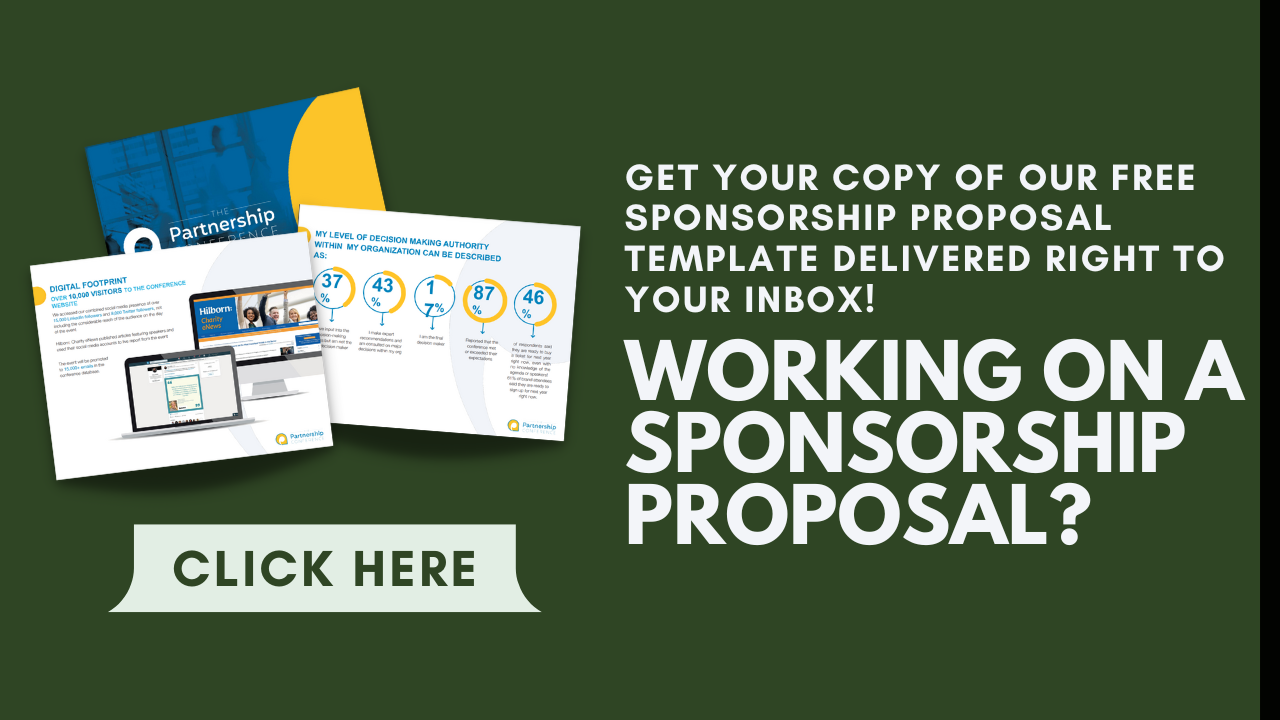
Who You’ll Contact
I only recommend communicating via sponsorship letter with a contact you already know or have a connection with. Even if you’ve never personally met or interacted with the person before, but your close colleague has, that’s fine.
You should have the contact’s information in front of you, including a full name, business address, email address, and business phone line.
If you don’t have this info, now is not the right time for a sponsorship letter.
How You’ll Reach Out
Although the term “sponsorship letter” might conjure a physical letter you send via the post office, that’s not quite accurate. A sponsorship letter can be an email, a direct message, a smoke signal (okay, maybe not that last one).
It’s not a phone call, as it’s written communication, but that’s the only qualifier.
You can choose how you send your letter based on what’s most convenient and accessible. For example, direct messages might seem handy, but if you and the contact don’t follow each other, your message might get sent to a folder the contact doesn’t check.
How Long You’ll Wait to Hear Back
I’ll discuss this more coming up, but you can’t wait forever for a response to your sponsorship letter. Many sponsorship seekers I work with think they’ll get a yes or no reply, but it’s not always so cut and dried.
In many cases, a lack of response is a response, and it’s still a no.
What You’re Asking For
You know you’re not asking for cash straight-up in your sponsorship letter, so what should you request instead?
A discovery session. This meeting with potential sponsors uncovers their challenges, helping you decide where your solutions slot in.
This is why audience alignment is so important in a sponsorship opportunity. If your audience has nothing in common with the sponsor’s target market, you can’t sell the sponsor assets and activations that will solve their problems.
What’s Next
However, even if the stars align and you have a perfect audience for the sponsor’s target market, that doesn’t mean sponsorship is guaranteed. You might not hear back from the contact, or you could get a response and learn they’re unavailable.
You need a Plan B for if your Plan A doesn’t work out. I recommend a healthy prospect list so you can move on to the next contact.
It’s especially prudent during event sponsorship to keep your timeline moving forward so your search for sponsorship doesn’t impact your event-planning duties.
Asking for Sponsorship Through Email – The Art of the Communication Cadence
Writing a subject line.
This might be the most nerve-wracking part of putting together a sponsorship letter, and rightfully so.
A subject line is a make-or-break moment. If you write it well, it can inspire your sponsorship prospect to open your message. If you write it ineffectively, it will lead to your message being ignored, or–worse yet–your email address blocked or sent to spam.
Here are some pointers for writing a great email subject line.
- Tap into the sponsor’s emotions. The best emotion to inspire when sending a sponsorship letter is curiosity. A subject line like “[Name] recommended I ask you about this” is going to make the sponsor want to read your email.
- Skip the emojis. I know businesses use them all the time, but they detract from your professionalism.
- Keep punctuation to a minimum. A subject line doesn’t have to be expressed as a full sentence, so don’t use more than three types of punctuation per email.
- Use the sponsor’s name in it. That might get them interested enough to open your message.
- Don’t write an ultra-long subject line. It will get cut off mid-word and look spammy. Stick to 70 characters, max.
- Don’t be dishonest. You might get the sponsor to open your email, but as soon as they realize your subject line and body content don’t align, you’re getting blocked.
- Avoid using all caps. One capitalized word is okay if absolutely needed, but even that can be perceived as pushy.
- Don’t overthink it. I know, this is much easier said than done, but it’s just a subject line. You can only dedicate so much time to it before you have to do other tasks related to your sponsorship opportunity.
Sending the Email and Waiting – How and When to Follow Up
While you can sit and refresh your inbox all day, that’s not the best use of your time.
Give your contact at least a day to reply. If you don’t hear anything, send a follow-up email. Keep the language light and breezy.
For example, you might write:
It’s [your name] again. I know you got a lot on your plate, but I’m just checking to see if you saw my email. I would still love to pick your brain about [topic of your event]. Is the meeting time I proposed still good? If not, how about Friday at 2:30? Let me know, thanks!
[Your name]
If your follow-up gets no response, I recommend a phone call, then another email, and a phone call. Alternate your forms of communication for seven days.
If you still don’t hear anything after reaching out daily and giving the sponsor more than ample time to respond, you’re never going to. There’s no sense in sending emails or making phone calls for another week.
Instead, connect with another contact within the company. If you don’t have one, then write off that prospect for this event and check in with them during your next one. Continue on to the next prospect in the meantime.
Best Practices and Tips for Writing Sponsorship Letters
Adding to existing section
Write an Introduction
This isn’t a formal introduction, but a short lead-in. Keep it to a sentence or two at best.
Your intro might not be in the first paragraph, especially if you’re asking a prospective sponsor for an opinion, but you don’t want it to be too far into your letter.
This part of your sponsorship letter should include your name, who you are (like your title), and what you’re about. Provide a bit of information about your event, program, or opportunity (no more than one sentence).
This information saves the sponsor from having to Google you. Your sponsors are busy people, just like you are, so whatever you can to do save them time or make their lives easier, prioritize those tasks.
Use an Email Signature
Turn on an email signature in your email client of choice if you don’t already have one. Creating an email signature is free, fast, and easy, so you should use one. You can include your company name, logo, website link, and social links.
That’s why I recommend you send your sponsorship email with a signature. This will also simplify the sponsor’s life. They won’t even have to open a Google search to look into your brand.
They can click your website from within the email and review your social accounts, including how active they are, how much engagement your posts attract, and how many followers you have.
Oh, and a signature makes your email look more professional. That will win you brownie points. As I always say, sponsors have no desire in working with amateurs, so crafting a professional email will help you stand out.
Consider the Sponsor’s Perspective
By all means, write the sponsorship letter your way, including as much information as you want about your cause or event.
Then, I want you to step away for a bit and come back to the letter. This time, don’t think of yourself as an event host. You’re a sponsor.
Imagine your email is coming to you as a sponsor. You don’t know the recipient very well (if at all). You have a lot going on, so you’re only checking emails for a couple of minutes.
What would get you to read through to the end of the message?
Flattery is okay, to an extent. That’s part of why I recommend asking the sponsor for their thoughts or opinions, as you’re making them feel important by requesting their input.
However, you don’t want to lay it on too thick, as that comes across as inauthentic and condescending. That’s the way to get your email sent straight to the trash.
Use a Grammar Checker
Recalling that sponsors don’t want to work with amateurs, you don’t want to make any careless spelling and grammar mistakes in your message, especially when they’re so preventable.
You can install a grammar-checking extension in your internet browser, so whether you’re writing a social media post, an email, or a message elsewhere online, you can ensure your spelling and grammar are on point.
I also recommend a grammar checker because many will detect your tone. You don’t want to come across the wrong way in your sponsor letter, so knowing whether you’re using a friendly or formal tone will benefit you.
How Do You Start a Sponsorship Letter?
A simple “Hello, my name is…” suffices. Remember, you should begin with a short introduction, where you state your name, where you’re from, and briefly mention what you do. Then, get into the crux of your letter, asking the sponsor for a time to chat.
Who Should a Sponsorship Letter Be Addressed To?
Target the decision-makers when you reach out, especially for event sponsorship. You only have so much time between now and your event, and the lower on the totem pole you go, the more parties they must involve to get clearance.
When you go straight to the decision-maker, you usually get answers faster.
What If My Sponsor Agreed to Meet But Didn’t Agree to a Time?
There is no meeting happening if you don’t have a date or time set. You should call or send a follow-up email confirming the original date and time, asking the sponsor if they have it available.
If not, let them tell you when a better time is.
How to Write a Letter Requesting Sponsorship
What should be included in a sponsorship letter.
The basic components of a sponsorship letter are as follows:
An Introduction to Yourself and Your Opportunity
The reason you got in touch, information about your audience.
- Your Activation and Sponsorship Opportunities
A Mention of When You Will Follow Up
Keep reading to learn more about each section and how to use a sponsorship letter to get meetings with your prospects.
If the goal of the sponsorship request letter is not to make the sale, then what is the goal? Simply put, it’s to get the attention of your prospect and to get them to take your call or agree to a meeting. How do you do that? By being crystal clear on your opportunity and your audience. Here is a guideline to follow when creating your own sponsorship letter.
This is not the time to include a long-winded, multi-paragraph description of your mission, vision, history, and how much money you need to make budget or accomplish your goals. Instead, briefly describe who you are with a sentence or two about your organization. Less is more here.
Why did you reach out to this sponsor in particular? For money, right? Wrong! Tell them why you got in touch with them!
The key word here is “them.” Why did you choose their company in particular? Do you know someone who suggested that you connect? This is the place to mention your mutual contact’s name and why they thought the two of you should meet.
What is it about the potential sponsor’s corporate goals that line up with yours? Do they have a history of sponsoring opportunities like yours? Do you offer access to an audience they’ve indicated is important to them? Is the main contact involved in organizations like yours?
This is where you show them you’ve done your homework and that they are not just one of thousands of letters you are firing out the door.
This is your opportunity to stand out! Sponsorship is all about marketing and sales, and both require a target customer to work. Do you know your prospect’s target customer? Here is where you prove it.
I’m not talking about basic demographic information here or sweeping generalizations like “middle-class families.” I’m referring to data that describes who your audience is, why they are involved with your organization, the types of purchases they plan to make, and data related specifically to your prospect.
Do they buy your prospect’s product already? Can you help your prospect sell more product or keep current customers?
Most sponsorship seekers leave audience data out completely, hoping their prospects will be impressed by their cause or by the prestige of their brand alone. Yet without audience data, you look just like every other proposal that lands on their desk.
Not sure who your audience is? Check out this blog post all about audience data and sponsorship.
Your Activation Opportunities
Need a refresher on activation? Check out this blog post on building activation ideas that work. Craving some inspiration to build up some cool activation ideas? Here are eight activation ideas to get those creative juices flowing!
Instead of focusing on how much money you want from your sponsor, use your sponsorship letter to show your prospect that you understand how sponsorship works. Give them three examples of activation ideas that your sponsors and your audience love.
Show them the types of outcomes you can offer them, like branding, sampling, product placements, or contests. Be specific and clear about the way you work with sponsors and how sponsors can add value to your audience (who is also their target customer).
Let your prospect know you plan to follow up and be specific on when. Tell them you are going to call them on a certain date and time or that you plan to stop by their office on a specific date to say hi. At that time, you can clue them in that you would love to learn more about their goals and how you can work together.
When you tell your prospect you plan to follow up, you are showing them you’re serious about working together. Then add your contact information and invite them to get in touch if the above times don’t suit them.
Faced with an impending meeting with a sponsorship seeker, more often than not, your sponsors will follow up with you first. It may be to tell you “no thanks,” or it could be to learn more about your audience and the cool activation ideas you featured in your letter. Either way, a yes or no is better than silence, requiring you to follow up forever.
When Not to Send a Sponsorship Letter
Your sponsorship letter is all written and polished using the information presented so far in this guide. Before you slap that stamp on, hold up! There are some instances where a sponsorship letter might not even be warranted.
Here’s an overview.
You Have No Prior Connection with the Sponsor
If you think your business or nonprofit is the only one to seek sponsorship, think again. Thousands upon thousands of your competitors will do the same. Maybe they won’t target the same sponsor, but the story doesn’t change all that much.
Any company known for its sponsorship will be bombarded constantly with a pile of letters and endless emails. You have to set yourself apart immediately or your letter will end up in the trash, be that the physical can or the digital one.
That’s why it’s good to have a connection, as I talked about in the last section. By at least wedging your foot in the door through someone who knows the sponsor, your potential sponsor may be more willing to communicate with you. Without that, you’re just another in that endless pile, ignored or trashed completely.
You Forgot Audience Data
It’s best to choose a sponsor to work with in which there’s some overlap, be that similar goals or a like audience. You may know your audience exceptionally well, but the sponsor has no way of gleaning the same info if you leave out audience data.
I seriously can’t stress the importance of this enough. Please take the time to compile your audience data and include it as part of your letter, even if there’s only a brief mention. Otherwise, your letter is not likely to get a second look from the sponsor.
The Timeline Is Too Tight
If your event is next week, then you might as well forget trying to get sponsorship at that point. By the time your letter even reaches the sponsor, it’ll be too late. They could want to help but would be unable.
Sure, the sponsor could want to work with you if you can plan better next time, but your lack of organization can also leave a bad taste in their mouth. You may then miss out on a potentially good opportunity just for your poor planning.
7 Best Practices for Writing Sponsorship Letters
As you comb through your draft sponsorship letter for the dozenth time (or maybe the fiftieth), make sure you follow these best practices for the greatest success.
Lead in with Your Connection
In journalism, there’s a term known as burying the lede (or lead). The lede is the single most important sentence in the article. It should be one of the first sentences and certainly in the first paragraph.
When you bury a lede, the crux of the story doesn’t start until the third or fourth paragraph. The reader might not necessarily get that far, so the whole point of the story is missed.
You can also easily bury the lede in your sponsorship letter if you can’t identify the most crucial components. Believe it or not, that’s not your request for money. Instead, it’s all about who you know.
This separates you from the rest of the pack, taking you from a complete unknown to someone the sponsor may be familiar with. Also, as I said before, it could be the difference between the sponsor reading your letter or skipping it altogether.
If you were at an event and met the sponsor or someone connected you, start with that. The money request can come later, trust me.
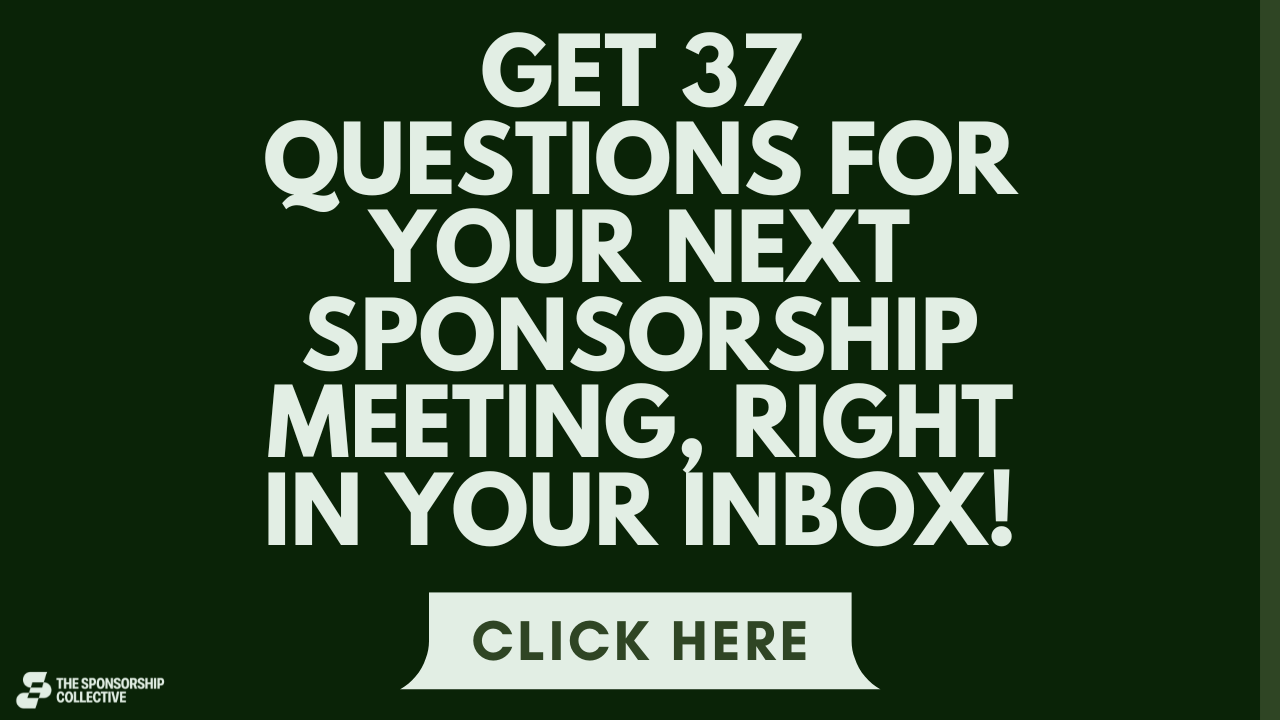
Personalize, Personalize, Personalize
Will this one letter be the only sponsorship request you send? Probably not. You likely have a huge list of potential sponsors to connect with, but the one doesn’t have to know the others exist.
Personalizing each of your letters is a good way to make your sponsor none the wiser that you’re courting others. Never address your letter to sir, madam, or the dreaded “to whom it may concern.” Find a contact at the sponsorship company and write to them specifically. Talk about the company’s virtues that you like, too.
While yes, it takes more time and effort crafting personalized letters than it does inserting some names into a generic template, it’s worth it.
Remember Who the Letter’s About
Another reason to personalize is that you keep the focus of the letter where it’s supposed to be: on the sponsor themselves. Now is not the time to write an in-depth synopsis on your cause or what you hope to achieve in the fiscal year.
A sentence or two about yourself is necessary, but for the most part, it’s all about the sponsor. Sure, this is kind of like buttering them up, but that’s not a bad thing in this case.
Keep It Short
If your sponsorship letter doesn’t fit on a single page of printed paper, then you need to go back and shorten it.
Sponsors are busy people, just like yourself. They can’t read through pages and pages in an attempt to reel them in and convince them to donate. While there’s no hard and fast word count rule, a few paragraphs should suffice.
Ask for an Opinion or Help
Here’s another trick for piquing the sponsor’s interest: ask for something from them. No, not money (not yet), but maybe their assistance or even their thoughts on something. In doing this, you’re conceding that they’re an expert. You’re also showing that you value what they have to say, something else that could set you on the road to a working relationship.
Set a Time for a Meeting or Phone Call
You may not feel like the most confident person if you’re approaching a sponsor via letter for the first time, but you’ve got to fake it ‘til you make it. Don’t leave it up to the sponsor to determine when you two can next talk.
Again, they’re busy people, so they may not have time for you for weeks or months. Also, if you happen to never hear back from the sponsor–which does happen–then the ball is in their court and that’s it.
Whereas, when you’re the one to propose a day or time for a phone call, like I wrote before, the sponsor has to say something , be it a negative or positive response. Something is always better than nothing, after all!
Avoid Boring Pleasantries
Besides skipping “to whom it may concern,” cut all the rest of the small talk and pleasantries out of your letter. These include things like “hope you’re well” or “how are you?” or even “how’s the weather in [city]?”
These icebreakers don’t come across as very confident. Plus, starting off this way buries the lede, which you don’t want to do.
Four Sample Sponsorship Letter Templates That Work
If you need some extra help perfecting your sponsorship letter, that’s okay. I’ve updated this post with four new templates you can use. These include sponsorship opportunities for events, athletics, golf tournaments, and in-kind contra.
First Template: Sample Sponsorship Letter for an Event
Arguably the most common sponsorship letter is one to obtain funding for an event . From conferences, expos, and everything in between, if you want financial backing from a sponsor for your event, follow this template.
Hi there [name of person at sponsor company],
I was recently in touch with [contact] about an upcoming event for my company/organization [name], and they mentioned you would be good to reach out to.
My company/organization was thinking of [theme] or [budget] for event and would love to know what you think. We’re currently planning to host the event on [date] [time] at [location]. Our company…[short description of what you do].
We believe we could attract [audience data] through this event, but we’re looking for the right financial backing, such as from [name of sponsor company]. If you help our company/organization, your funding would [list all the perks of the sponsorship opportunity].
Do you have time on [date] [time] to discuss this opportunity further? Please let me know.
Sincerely,
[your name]
Second Template: Sample Sponsorship Letter for Athletes
If you have an athletic team or sports pursuit on the agenda, then the above letter template won’t really work. You need one better-suited to your goals, such as this.
Dear [name of person at sponsor company],
We met a few weeks ago at [sport event]. I remember talking to you then about your interest in sporting opportunities, hence why I thought I’d reach out to you now.
Our company/organization [name] is organizing a [sporting event/team] and would love to have sponsorship from [sponsor company]. The team we’ve built is really talented and excited to play [talk more about virtues], but we need the backing of a company like yours because [talk about what aligns you to sponsor].
By assisting our athletic pursuits, our team would be able to [talk about what the sponsor’s money would provide, such as access to bigger arenas, sports gear and equipment, etc.].
I’d love to speak to you further about this on [day] [time] or whenever you’re available. Please let me know what works for you. Thank you very much for your time.
With regards,
Third Template: Sample Sponsorship Letter for a Golf Tournament
If you’re focusing more on a specific sport, such as a golf tournament , then your sponsorship letter won’t be identical to the one above. Here are some tweaks to make.
Hello [name of person at sponsorship company],
I was referred to you by [name of whoever connected you] and thought you’d be a fantastic fit as an avid golf fan and supporter.
Our company/organization [name] is hosting a golf tournament on [date] [time] at [location]. As one of the leading companies/organizations in [your neighborhood], [your organization name] has…[small mention about what you do.]
This [golf tournament name] will attract [audience data], which we noticed overlapped with some of your own company goals. Thus, we thought a sponsored partnership would be well-suited to us both.
In accepting the sponsorship, [name all benefits]. I’d be happy to answer any questions or discuss this opportunity with you further. What about [date] [time]? I can also gladly work your schedule. Just let me know.
I’m looking forward to hearing from you.
Fourth Template: Sample Sponsorship Letter for Contra or In-Kind Sponsorships
What if you’re not necessarily looking for funds or a donation, but rather goods and services? That’s known as an in-kind sponsorship , and it requires a whole different type of sponsorship letter.
Here’s a template to spark your creativity.
Good morning/afternoon [name of person at sponsorship company],
Your name has come up through a few of our [name of organization/company’s] connections, and I thought I’d take the time to formally introduce myself. I’m [name] and my organization/company[name] does [talk briefly about your services].
My [connection name] mentioned your company because [whatever reasons you want to work with sponsor]. Currently, our organization/company [name] is seeking in-kind donations, and we’d like to ask if you’d consider giving.
Our company/organization [name] would need [however many donations] to [whatever goal you’re reaching towards], and we believe you could be an integral help with that. If you donate [talk about where in-kind donation would be used for].
I’d love to discuss this more with you, maybe at [date] [time] if that works for you. If not, please let me know a more appropriate time.
Thank you very much,
Things to Avoid in Your Sponsorship Letter
There are several things you want to not do in your initial outreach. In no particular order, they are:
- Specific financial requests
- Sponsorship grids and levels
- Requests for free products for in-kind sponsorship
- Leaflets, pamphlets, samples or proposals
- Pictures of your stakeholders or program users
- Focusing on need
- Words like “to whom it may concern” (Be sure to address the letter to a specific person)
- Assumptions about their target audience or key demographic
- Sponsorship agreements asking for a signature or contract the first time you reach out to them
Stay focused on the core goal of the sponsorship letter: to present your opportunity in a respectful way and ask for a meeting.
Follow-Up Time!
If you sent your letter to a cold prospect, the first thing to do is implement all of the techniques suggested in the blog posts listed in this article. In other words, try to warm up the contact and connect with them directly.
If you can’t make a direct connection to your prospect, then get ready to follow up. A lot. Remember that these folks get hundreds of these types of requests every week (or every day in some cases!). Start by following up on the date and time that you told them you would, then follow up some more.
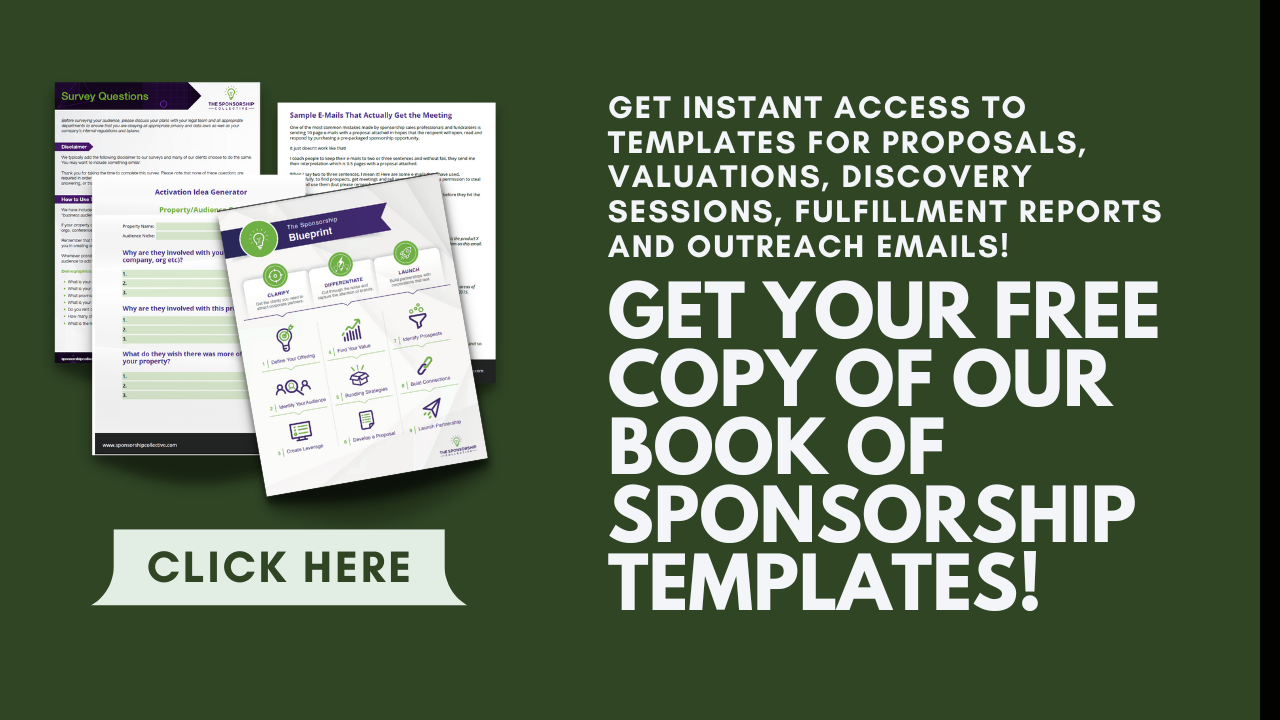
How to Write a Thank You Letter for Sponsorship
The thank-you letter you send your sponsors is actually called a fulfillment report . In a fulfillment report, you outline all of the things you promised your sponsors, how much they paid for those benefits, both tangible and intangible sponsorship benefits, and then you report on how well you delivered those assets along with the revised value of what you actually delivered.
You want to make sure you thank you sponsors within one week of the end of your event or campaign (or quarterly if you have a yearlong relationship with your sponsors).
Remember, if your first point of contact with a sponsor is writing them a sponsorship request letter, your chances of success are very low! You can use the sponsorship letter to grab their attention, warm up a call or, better yet, to summarize the results of a recent meeting before moving on to a full sponsorship proposal.
As a last resort, after attempting all the techniques listed above, a sponsorship request letter can help open doors…but you have to do it properly! A letter or proposal, no matter how well written, is never a replacement for good old-fashioned sponsor-centric sales.
While a sponsorship letter can be a valuable tool to getting an in with a potential sponsor, you can’t just ask for money right off the bat. There’s an art to writing one of these letters. With the templates, infographic, and best practices highlighted in this article, you’re well on your way to nailing your next sponsorship letter. Best of luck!
After several years as a sponsor (that’s right, the one investing the money!) Chris decided to cross over to the sponsorship sales side where he has personally closed tens of millions of dollars in sponsorship deals. Chris has been on the front lines of multi-million-dollar sponsorship agreements and has built and coached teams to do the same.
- About the Author
- Latest Posts

Chris Baylis is the Founder and Editor-in-Chief of The Sponsorship Collective . After spending several years in the field as a sponsorship professional and consultant, Chris now spends his time working with clients to help them understand their audiences, build activations that sponsors want, apply market values to their assets and build strategies that drive sales.
Read More about Chris Baylis
- 27 Things You Can Do to Bring in More Sponsorship Dollars Right Now (Without a Sponsorship Package)
- April 2024’s Awesome Sponsorship Activations
- How to Price Sponsorship Packages
- PRO Courses Guides New Tech Help Pro Expert Videos About wikiHow Pro Upgrade Sign In
- EDIT Edit this Article
- EXPLORE Tech Help Pro About Us Random Article Quizzes Request a New Article Community Dashboard This Or That Game Popular Categories Arts and Entertainment Artwork Books Movies Computers and Electronics Computers Phone Skills Technology Hacks Health Men's Health Mental Health Women's Health Relationships Dating Love Relationship Issues Hobbies and Crafts Crafts Drawing Games Education & Communication Communication Skills Personal Development Studying Personal Care and Style Fashion Hair Care Personal Hygiene Youth Personal Care School Stuff Dating All Categories Arts and Entertainment Finance and Business Home and Garden Relationship Quizzes Cars & Other Vehicles Food and Entertaining Personal Care and Style Sports and Fitness Computers and Electronics Health Pets and Animals Travel Education & Communication Hobbies and Crafts Philosophy and Religion Work World Family Life Holidays and Traditions Relationships Youth
- Browse Articles
- Learn Something New
- Quizzes Hot
- This Or That Game
- Train Your Brain
- Explore More
- Support wikiHow
- About wikiHow
- Log in / Sign up
- Education and Communications
- Letter Writing
- Request Letters
How to Write a Letter Requesting Sponsorship
Last Updated: February 21, 2024 Fact Checked
This article was co-authored by Ernest Sturm . Ernest Sturm is a Marketing Expert and the Owner of Runway Influence and Runway Waiters, as well as the President of Runway Collective. With over 10 years of experience as an entrepreneur, he specializes in producing social media campaigns and social brand activations. Runway Influence has a 5-star rating and partners with luxury brands and top influencers. This article has been fact-checked, ensuring the accuracy of any cited facts and confirming the authority of its sources. This article has been viewed 6,608,609 times.
If you're hoping to get someone to sponsor your event or something else you're doing, you should write a sponsorship letter. Your letter must convince the sponsor that it's worth contributing and clearly outline the benefits the sponsor gets, presenting an executive summary that details your event or mission. Writing a proper sponsorship letter can make all of the difference between securing the sponsorship or being ignored.
Things You Should Know
- Research the exact kind of sponsorship you're seeking. Reflect on what skills and experience you can offer a business.
- Write your letter in formal business format. Read through sample sponsorship letters to get an idea of the gold standard.
- Be sure to include details on what the business can earn from offering you sponsorship and proofread before you wrap things up.
- Your pitch should always be tailored to the specific sponsor you're meeting, depending on their size and probable budget.

Preparing to ask for Sponsorship

- Sponsorship letters should be specific and focused. If they are too vague or you don't know what you're seeking or why, they won't be very effective.
- Understand why you want to meet the goals. Sponsorship requests are more successful if they are accompanied with a sense of purpose or passion. Convince people why it's worth giving time or money to this cause, perhaps by telling them a story about how the cause has helped someone or the community

- Make sure to include businesses or people on the list with whom you or others who work with you have a personal connection. Never underestimate the value of personal connections. [1] X Research source
- Don't overlook small businesses or those that don't have storefronts. They might be willing to give, too. Remember that you can play up the "local" angle. Hometown businesses often see an advantage in remaining connected to their communities.
- If you are working on a team, divvy up the businesses on the list and give each team member the task of contacting some of them, so each gets personal outreach.

- Cash or in-kind donations are both possibilities. In-kind donations mean the business donates materials or products that can be used at the event instead of just giving money. Sometimes these take the form of services not tangible goods.
- Perhaps you are willing to take volunteer work instead of a product. Either way, you need to be very clear in what you're seeking - specifically.

- Decide sponsorship levels. You should clearly outline the different benefits achieved by different levels of sponsorship. People who give more should get more.
- An advertising banner, a public announcement about the company or sponsorship, and the company's logo appearing on a website or in promotional materials or programs are all examples of benefits you could offer.

- Often, the proper person will be the person who runs the company's Human Resources Department or its CEO. You should call the company or look on its website and determine who handles sponsorships. Don't guess at this. To be effective, the sponsorship letter absolutely must be addressed to the right person. Get the spelling of their name and their title right.
- You should also figure out if the organization has a charitable giving policy so you don't waste your time and can align your request with the policy. [2] X Research source
Understanding the format

- Don't copy a sample letter too closely, though. You need to tailor your letter to the organization you're writing to so it sounds personal and not too formulaic. [3] X Research source
- For example, if you know a CEO has a personal background that relates to your cause, you can personalize the letter to that person. You should know the background of the people or companies you're soliciting, and you should tailor the letters so they feel personal.

- Put the letter on formal letterhead that has the logo and name of your organization. This will make your request look more professional. If you're asking for a sponsorship for yourself, you could still create professional letterhead that has your name at the top in a nice font.
- If you're writing to a business or other organization, more formal is best. If you're writing to a family member or friend, you could be less formal, but you still shouldn't be so casual you sound disrespectful. Whipping off an informal email is unlikely to get good results in either case.

- Start the letter with the date, and then the sponsor's name and address.
- Then, after a space, put the salutation: Dear (Name of the person) and a comma.
- Keep it short. Keep the sponsorship letter on one page. People are unlikely to have time to read more. Most people being solicited will give about a minute to your sponsorship letter. So in addition to keeping it on one page, make sure the language is concise and clear. [4] X Trustworthy Source Purdue Online Writing Lab Trusted resource for writing and citation guidelines Go to source
- Send it snail mail. Email requests make it seem like you didn't take much care when sending it.

- End with a respectful, professional salutation, such as: Respectfully, and then your name and title. Sign it personally.
- Include other materials. You might want to provide a printed flyer with your sponsorship letter to provide background on your event or company. This will provide additional credibility and may make the business feel more comfortable in supporting you.
- Similarly, if your organization has received news coverage, you could include a sample news article to back up what you've done.
Perfecting the Content

- Don't assume people know who you are or what your organization does. Explain those things, clearly. Begin with a description of the company (if it's a corporate letter) or yourself (if it's for personal sponsorship). For example, such-and-such firm is a nonprofit organization committed to rehabilitation... etc.
- Highlighting a few accomplishments right away will make it clear why it's not a risk to give you sponsorship. Make it very clear how the money will be specifically used.
- In the second paragraph or first, you need to make the direct request for sponsorship and explain why you are seeking it.

- If the sponsors will get good publicity out of the sponsorship, for example, explain how. Be very specific: Will the event be televised? How many people will be attending? Will there be VIPS? If other prominent companies or their competitors are sponsoring your event, you might want to mention that.
- Give the sponsors options. They will like the fact they have different choices to match their individual needs or budgets.

- Also don't forget to thread in an element of emotional appeal - a personal story of someone who will be helped, for example, if said briefly (in a sentence or two) can be very moving.
- Explain how you will give the sponsors recognition for their sponsorship. Perhaps they can have free booth space at your event in exchange for sponsorship.
- Provide the essential details of the sponsorship deal that they will need to make their decision. Don't forget to include contact information. You might want to also include a self-addressed, stamped envelope to make it easier for them to respond. Don't forget to include the date you need a response by.
- Ask the sponsors how they prefer to be recognized. For example, how do they want their name to appear and do they want to be recognized? Offer possibilities but never assume. Ask.

- For example, if you're writing a letter for a charity, you should explain the background of the charity, such as when it was founded, who runs it, who it serves, and any awards or accomplishments it's received.
- Show don't tell. Don't just tell us the group or event are good or worthy. Convince us through showing details – evidence that backs up why or how the event or group are good or worthy. Evidence is more persuasive than superlatives, generally.

- You could call or stop by if you don't get a response in 10 days. Remember though that many CEOS especially will be very busy and could be annoyed. So you might want to schedule an appointment or call first.
- Make sure that you convey excitement about your project. Avoid anything negative. You don't want to sound like you're begging or trying to put a guilt trip on them about donating..
- If the answer is “maybe,” don't feel bad about following up. Just don't do it immediately or too much or you might become annoying.
- Never be presumptuous. Don't assume they will give you a meeting or sponsorship. Simply thank them for their consideration.
- Don't forget to send a thank you note if you get a sponsorship.

- Check punctuation . Many people don't know how to use commas or apostrophes properly. The little things matter here.
- Print out a copy of your letter, set it down, and read the hard copy in a few hours. Sometimes the eye gets so wedded to online content that it can be easier to miss typos if you're reading it online.
- Make sure you send it with proper postage in a professional business looking envelope.
- 7 Here is an example: Your Letterhead (if applicable) Date:____ Address: _________ _________________ _________________ Dear Mr. / Ms. / Mrs. _______ Recently, I was invited to compete in Miss USA State Preliminary Competition. While at the State Preliminary Pageant, I will have the opportunity to be chosen as the state's representative to the Miss USA National Pageants. I would be grateful if you helped in sponsoring me in Miss Colorado USA for my chance to win. More than 20-50 women will be competing with me. This event will be televised regionally with an anticipated audience of 2 to 300,000 and all my sponsors will be named in the pageant and on future productions website. The amount a sponsor may contribute is flexible. You could assist me through one of the options listed below. $____ – Your name, description, and logo $____ – Your name and description $____ – Your name and logo $____ – Your name If you are interested in sponsoring me, please get back to me at ___________________.
Thank you very much for your time. Sincerely, Signed Name Typed Name

Community Q&A
- Find a key contact person rather than a secretary or other third-party. Thanks Helpful 0 Not Helpful 0
- Do not be demanding. Ask politely. Thanks Helpful 0 Not Helpful 0
- Unless you have exceedingly beautiful handwriting, type the letter. This will make it look more professional. Thanks Helpful 0 Not Helpful 0
Tips from our Readers
- Approach the sponsorship as a partnership: you have something they need, and they have something you need. Don't be afraid to negotiate, and always act like a professional.
- Ask a friend or family member to check your letter for any grammatical errors.

You Might Also Like

- ↑ http://4h.ucanr.edu/files/131483.pdf
- ↑ http://bmes.seas.ucla.edu/uploads/5/4/7/6/54763313/sponsorship_proposal_15-16_v0.pdf
- ↑ https://www.letters.org/donation-letter/sample-sponsorship-request-letter.html
- ↑ https://owl.purdue.edu/owl/subject_specific_writing/professional_technical_writing/basic_business_letters/index.html
About This Article

To write a letter to a potential sponsor, address it to the CEO or head of HR. Introduce yourself and explain your company and cause in the first paragraph, then state clearly that you’re looking for sponsors. Outline benefits that would come with their sponsorship, such as advertising or networking opportunities at an event. Include a few facts to appeal to their logic, such as the size of the audience they’ll reach. Thank them at the end and proofread, then sign it by hand and mail. To learn how to choose a tone for your letter or how to outline your points, continue reading the article! Did this summary help you? Yes No
- Send fan mail to authors
Reader Success Stories
Annette Sharise Evans
Jun 27, 2017
Did this article help you?

Fatiema Klaassen
Oct 2, 2017
Antoinette Staples
Apr 26, 2016
Sep 30, 2016
Jul 6, 2017

Featured Articles

Trending Articles

Watch Articles

- Terms of Use
- Privacy Policy
- Do Not Sell or Share My Info
- Not Selling Info
wikiHow Tech Help Pro:
Level up your tech skills and stay ahead of the curve

- 12 Types of Sponsorship Letters and How to Write Them
Well-positioned sponsorships can transform any nonprofit event into a must-attend, memorable occasion. They can also help you fund a specific need or explore meaningful partnership opportunities that can expand your mission.
However, many nonprofits struggle to find the right partners to support their goals. The first step in successfully recruiting more sponsors is to write a compelling sponsorship letter that explains your cause and why the recipient is the perfect fit to support you.
In this guide, we’ll show you how to write inspirational letters with the help of effective templates you can use to get started! Here’s what we’ll cover:
Sponsorship Letter FAQs
Sponsorship letter best practices, 12 sponsorship templates, what are sponsorship letters.
A sponsorship letter is a fundraising request that offers the recipient an incentive in exchange for a cash donation, auction items or other gifts, an in-kind donation, or volunteer time. Sponsorship letters are typically sent to local businesses or corporations requesting that they contribute a corporate donation or in-kind gift to support your cause.
These direct requests are great options to extend your reach and start a long-term relationship with a sponsor.
Why Are Sponsorship Letters Important?
Sponsorship proposals are important because the donations they secure help fund events like charity walks, runs, rides, galas, and more, all while strengthening ties between nonprofits and businesses.
They also sow the seeds of a long-term relationship (not just short-term support, though that is a bonus). And, along with the obligatory tax receipt, donors will receive benefits from supporting your organization, such as promotional spots or a guest speaking opportunity.
In the end, a sponsorship letter has the potential to kick off or sustain a mutually beneficial relationship between you and your sponsor that results in shared publicity and mutual success.
What Should You Give Sponsors in Return for Their Support?
Donors have lots to gain from sponsoring charitable organizations. Business sponsors, in particular, can access the following benefits:
Positive Brand Image
Social responsibility can substantially impact a company’s reputation. In fact, CSR research shows that 54% of consumers consider a company’s CSR practices when making purchasing decisions. By demonstrating a commitment to goodwill, companies can show consumers that their purchases will have a positive impact.
Employee Engagement
Today’s employees want to work for companies that make an impact. Double the Donation’s employee engagement tools article explains that establishing CSR initiatives indicates that a business “cares about the same causes as its employees and wants to make the world a better place. As a result, employees will feel more empowered to continue working at a company that does more than just provide a product or service.”
In your letter, emphasize that employees will be excited to know their company supports worthwhile causes if they decide to sponsor you!
Advertising Opportunities
Your nonprofit can offer various marketing opportunities to corporate sponsors, providing them with visibility and brand exposure while supporting your mission. You can explicitly offer these marketing opportunities in exchange for sponsorships:
- Their logo displayed prominently at events and on promotional materials
- Sponsor-specific pages or sections on your nonprofit’s website
- A booth at an event
- Social media shout-outs
- Their logo and promotional messages in your email newsletter
By offering these advertising opportunities, you can demonstrate the value of partnering with your nonprofit, helping corporate sponsors envision how they can enhance brand visibility while supporting a meaningful cause.

How Can You Identify Potential Sponsors?
Sponsorship letters should be highly personalized. Therefore, you need to know exactly who you’re addressing and why they’d make a great sponsor ahead of time. Here are key signs that a business would make an awesome sponsor:
- They’ve previously supported you or given to causes similar to yours. Prioritize sending proposals to companies that have volunteered with you, attended previous events, or shown interest in your cause. Likewise, if they support similar causes, this is a great opportunity to show them how they can lend a helping hand.
- They work in a similar or complementary sector. Companies that work in a similar sector or environment as you will have a clearer understanding of your cause and needs. For instance, a healthcare organization will understand how they can help provide aid to an at-risk homeless population.
- They’re local. Local or hometown businesses can benefit from the promotional opportunities of sponsoring you. Not to mention, businesses like to support causes that better their surrounding communities.
- They have a well-known CSR program. A business with a robust CSR program is already familiar with nonprofit organizations as a part of their employee engagement initiatives. Take advantage of this by prioritizing outreach to corporations like these.
- They can supply a direct need. Alongside monetary donations, looking for sponsors who can contribute in-kind donations can also help you work toward your goals. For example, a bakery might provide in-kind donations of snacks or pastries while a hotel could provide a venue space.
Before you send out letters to every available business, narrow your prospects to see if they meet the above criteria. Then, send your letters out well ahead of your event or campaign start date to give each prospect plenty of time to respond with any questions.

How Should You Send Sponsorship Letters?
Investing in a dedicated direct mail platform will provide the easiest, most effective channel to send out your sponsorship letters to as many supporters as possible. With a direct mail platform, you can send out your letters quickly, saving you time and money.
And of course, after you secure a donation or sponsorship you should strongly consider sending a thank-you letter. One of the best and most impactful ways to show immediate gratitude would be with an eCard platform your organization could use across its fundraising and thank-yous.
Of course, each sponsorship letter will vary based on your recipient and your request. However, there are a few best practices you can use to make all of your proposals compelling and to the point:
- Personalize letters by addressing the recipient by name. Choose the right person to address the letter to by researching or calling to ask who manages corporate donations at the organization.
- Talk to their point of view by highlighting how their organization’s values or previous charitable experience speaks to their company’s character. For example, you might say “As a small business that gives back to XYZ community initiatives, you know the importance of supporting those in need.
- Highlight benefits that they would find important. Are they interested in getting their brand name out there? Do they want to team up with more like-minded organizations? Let them know how your organization can help them do that.
- Have a leader at your organization write the letter, such as your president or an executive. This adds credibility to your ask and can be even more impactful if they know the small business contact personally.’
- Give sponsors a choice to support you in a way that works best for them. Let them know you’d be grateful for a monetary sponsorship or an in-kind donation.
- Prepare for a follow-up by including your organization’s contact information at the bottom of your letter and suggesting the contact reach out with any additional questions.
To write better sponsorship proposals, you can use templates and examples (like the ones provided below) to help structure your request and bring your organization’s fundraising narrative to life.
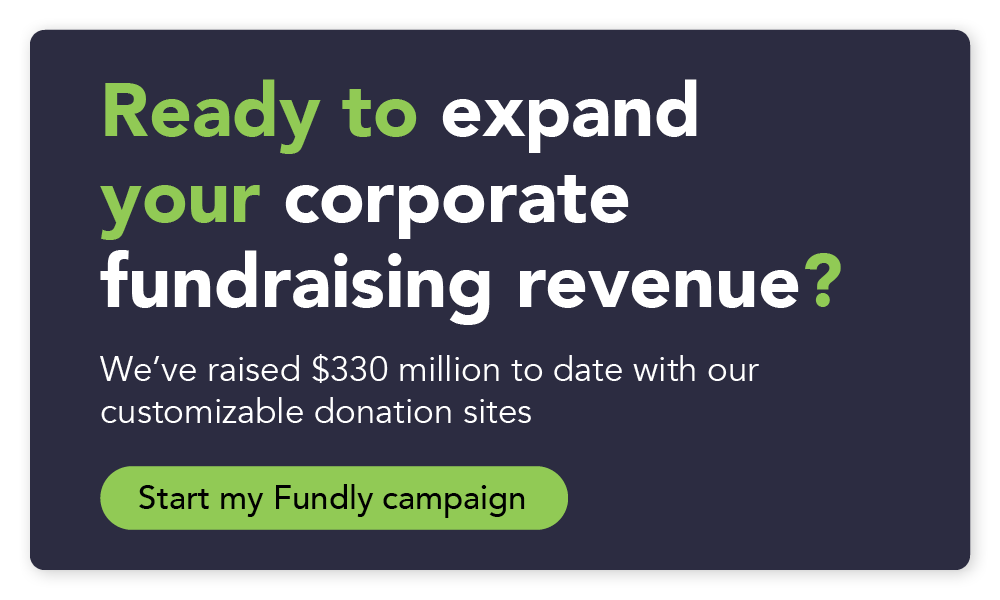
1. Event Sponsorship Letter
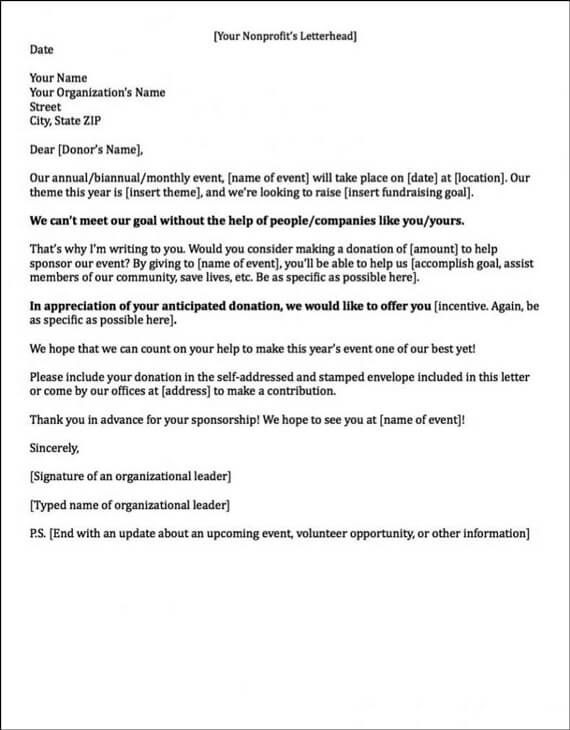
Follow these best practices when writing event sponsorship letters:
- Highlight the event. When asking for event sponsorship, your event needs to be the focal point. Start by detailing the kind of event it is, the theme, the date, and the location. Then, dive into what you’re looking to raise and why. Once you have your reader hooked, bring up how their event sponsorship fits in and what their gift could mean for your cause.
- Provide ample sponsorship opportunities. You’ll include a separate document with your cover letter that details your sponsorship levels. With each increase in gift level, the incentives should equally increase. If your event needs a range of sponsorship types from monetary to gifts-in-kind, make sure you are expressing the variety of opportunities to show support.
- Get to the point. Event sponsorship proposals should be succinct. The initial cover letter should be no longer than a page and simply provide a high-level overview of what you’re looking for. Be specific and direct. Once you have someone’s interest, you can always provide supplementary information as a next step.
- Start with your existing supporters. Make sure you reach out to past sponsors and tweak your letter template to acknowledge their prior support. If this event is new for your organization, reach out to sponsors of your other events or look to your closest supporters to see who has ties to a business that might be a good fit for sponsorship (i.e. a top donor who owns a local restaurant).
2. Corporate Sponsorship Letter
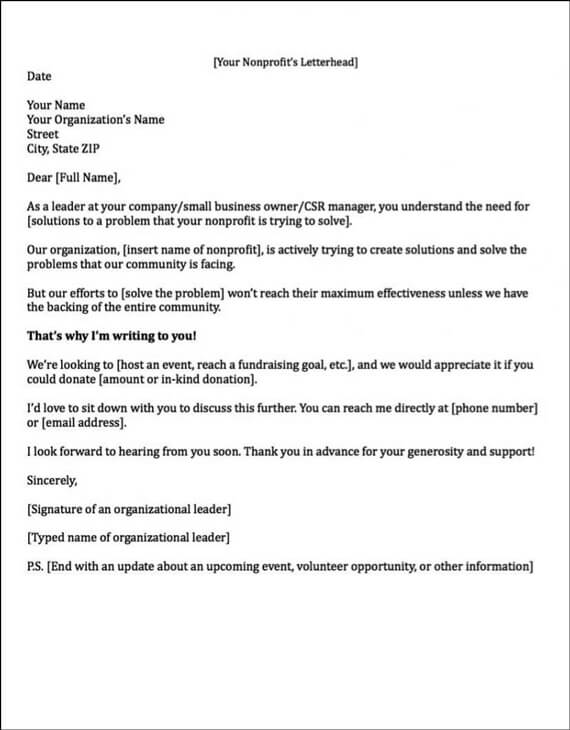
Follow these best practices when writing corporate sponsorship letters:
- Know your audience. When reaching out to a corporate sponsor, you need to know and demonstrate that you know exactly who you’re contacting, their role at the company, and how they fit into your sponsorship needs. Make sure to acknowledge past gifts and drill down on exactly what your organization needs from the sponsor.
- Mention common goals. As you ask for corporate sponsorship, be sure to highlight how support of your efforts intersects with the business’ larger philanthropic goals. Show that you both want to help your community and that everyone wins with their sponsorship of your organization, the community included.
- Include contact information. Your corporate sponsorship letter is your opening. Most businesses will want to discuss the sponsorship over the phone, in person, or both before agreeing. Provide a range of ways to get in touch so that potential sponsors can reach you easily.
- Attach a sponsorship level document. Interested corporate prospects will want to know exactly what their sponsorship options are. An attached sponsorship level document shows professionalism and makes the process easier for busy corporate sponsors.
3. Church Sponsorship Letter
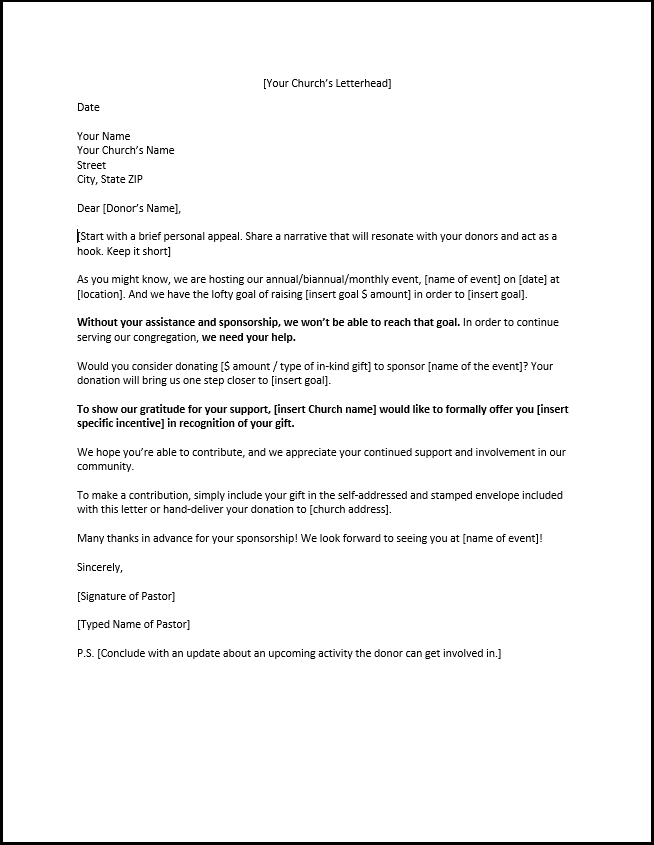
Follow these best practices when writing church sponsorship letters:
- Connect on a personal level. Sponsoring the financial needs of a church is a very personal decision for supporters. Your sponsorship proposal should reflect that in both its language and discussion of sponsorship incentives.
- Be specific. Make it clear in your letter that you’re asking for a sponsorship to fulfill a specific need and not to increase general funding. Provide the date or deadline, names of those who are involved, location (if relevant), and the desired outcome.
- Tell your story. Since donating to a church is such a personal decision, it is important that you highlight your church’s story within the letter. It can be brief, but you want to use your narrative to connect with sponsor prospects on an emotional level.
- Thank them for considering. Show your gratitude to your potential sponsors for taking time out of their day to read your letter. You want both those who choose to sponsor and those who do not to feel acknowledged and respected by your church.
4. Sponsorship Letter for Schools, PTAs, and Students
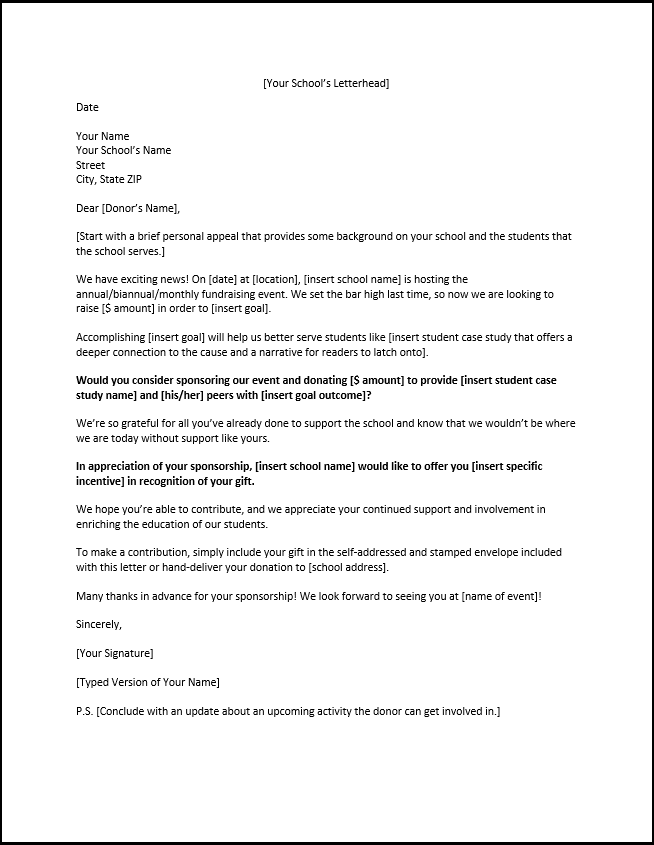
Follow these best practices when writing sponsorship letters for schools, PTAs, or students:
- Focus on the students. For any school-related fundraiser, the students are going to be the driving force behind a sponsor’s reason to donate. Your letter needs to recognize that fact by demonstrating how sponsorship will benefit the students.
- Know what you’re asking for. Don’t just send a generic sponsorship letter. Customize the letter to highlight exactly what you’re asking of your sponsor. Do you need them to supply the drinks for a school-wide field day? What about a big-ticket item for the auction? Include exactly what you need in your school sponsorship letter.
- Tweak your template based on your audience. For school fundraising, you’re going to have four main categories of potential sponsors: parents, alumni, faculty, and community members. Segment your outreach by category so that you can tweak your language to appeal directly to each of those groups.
- Cast a wide net. There are few causes as universally supported as education. Use that to your advantage and send sponsorship letters to a large selection of prospects. Look to local businesses, larger corporations, and even chain businesses within your town.
5. Sponsorship Letter for Sports Clubs

Follow these best practices when writing sponsorship letters for your sports club:
- Brag about the team. You only have one page to explain why sponsorship of your sports club is worthwhile, so take the opportunity to share your accomplishments. Highlight your wins, but make sure you also cover your big-picture benefit to the community, such as giving teenagers a healthy way to spend time after school.
- Feature an athlete. Pick an athlete from your organization whose experience exemplifies the core values of your club and tell their story. This shouldn’t be a lengthy section, but it will give your potential sponsors an anchor that connects them to your club.
- Explain exactly where the funds will go. When considering sponsoring your team, local businesses will want to know what their funds will accomplish. Is the money covering travel for one athlete for the season? Will the donations go to new uniforms? Be as specific as possible.
- Use advertising as an incentive. Sports clubs are perfectly positioned to offer advertising as a sponsorship incentive. You can place the sponsor’s sign on your scoreboard or even brand your uniforms. Then, during each game, your sponsor gets promotional benefits.
6. Sponsorship Letter for Food

Follow these best practices when writing sponsorship letters for food:
- Reach out strategically. Remember that you won’t need one restaurant or business to donate all the food for your event. You can increase your odds of success by dividing and conquering. You can go to one organization for the food and another for the beverages — just be sure to specify what you need in your request.
- Be complimentary. When reaching out for donated catering, it’s important to note that flattery is crucial. Be sure to include a few compliments about the food you’re requesting within your sponsorship letter. The more personalized you can make the proposal, the better.
- Space out requests. Unlike monetary donations, your event can only have so many food sponsors and vendors. You want to avoid a situation where you’re turning away the donations because too many restaurants want to provide catering. When you’re planning out your sponsorship requests, reach out to your first choice early enough that if it doesn’t pan out, you have time to continue the search.
- Include an estimated headcount. Potential food sponsors will want to know the headcount for two reasons. First, they need to assess if they have the capacity to cater for the number of people you’re expecting. And second, each meal they serve is an opportunity to potentially earn a new customer, which is highly valuable.
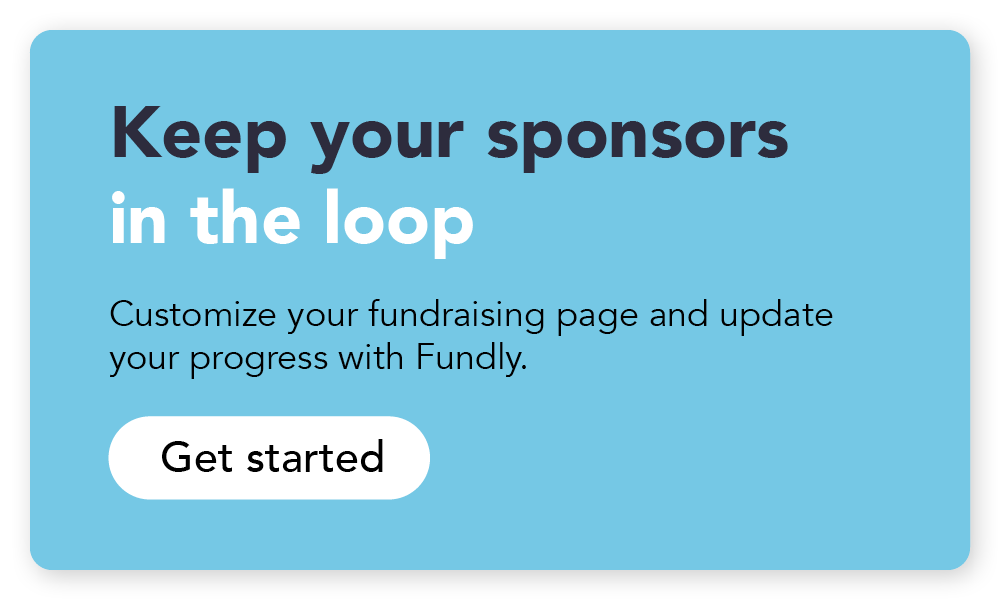
7. Sponsorship Letter for Auction Items
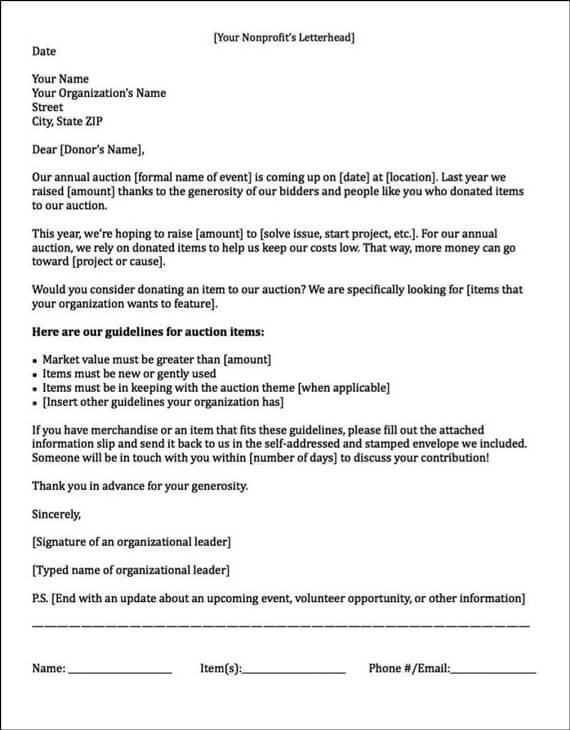
Follow these best practices when writing sponsorship letters for auction items:
- Talk about your last auction. Tell donors about the success of your last auction and what you raised. If this is your first auction, talk about your fundraising goal. In either case, talk about what the money will go toward.
- Include a form. Within your mailing, you should include a separate form that donors can attach to their sent-in item. The form should include a space for their name, type of item, and contact info. Ask them to mail the item directly if it’s small or to call in if the item needs to be picked up.
- Be specific with your request. Your auction theme needs to be included within the letter, as well as any items you’re hoping for and items you will not be accepting. Highlight examples where necessary, too. Being upfront will save everyone from a headache down the line.
- Include an event invitation. Be inclusive and polite and extend an invitation to everyone you’re asking for a gift-in-kind from. Include details about the time and date of the auction and how the potential sponsor can get involved besides donating an auction item.
8. Sponsorship Letter for Requesting Monetary Donations

Follow these best practices when writing sponsorship letters for requesting monetary donations:
- Address the right person. Large companies might have designated corporate social responsibility (CSR) departments and managers that handle all donation requests. Smaller companies might rely on the CEO or another leader to make charitable decisions. Before you write your cover letter, make sure you know who you’re talking to.
- Reference your past successes. Think of your cover letter as a chance to brag about your nonprofit. If you’re raising money for an annual event, use the facts and figures from last year’s event to show how effective your fundraising efforts were. If this is your first event, talk about other successful fundraising campaigns that you’ve launched.
- Highlight mutual benefits. While many companies are philanthropic, it’s important to remember that they are businesses , and as such, they will want to know what kind of return they can expect by donating to your nonprofit. While you can outline the details of the different incentive levels in your Sponsorship Levels Document, you can broadly highlight the mutual benefits that come with a donation.
- Offer ways to get in touch. Make sure that your potential corporate sponsor has a way to get in touch with you should they have any questions. Include all of your contact info (email address, direct phone number, mailing address) in your sponsorship proposal cover letter. Of course, with that, you have to be available! Return calls and emails promptly and answer questions as thoroughly as possible.
9. Sponsorship Letter for Requesting In-Kind Donations
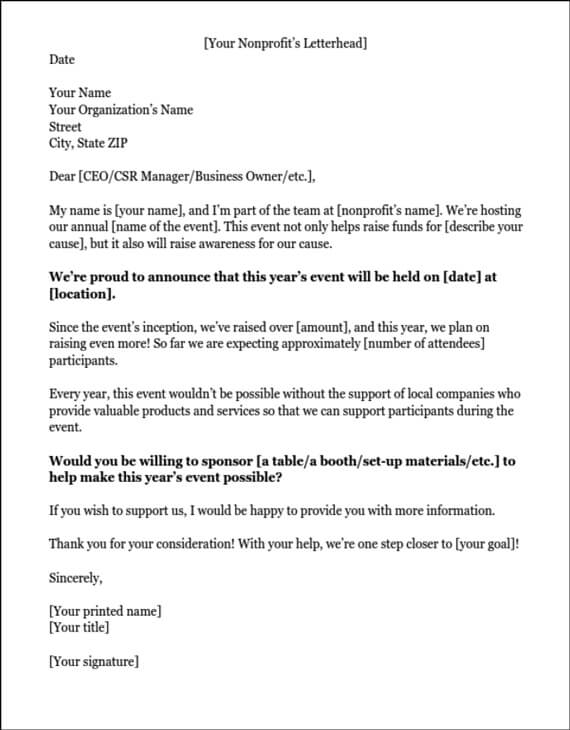
Follow these best practices when writing sponsorship letters for requesting in-kind donations:
- Elaborate on your fundraiser. It should be clear what event or campaign you’d like recipients to sponsor. Include the date and time of the event, as well as what cause the event will support. Companies you ask will see why obtaining sponsors is critical to furthering your cause.
- Highlight last year’s success. Illustrate your previous success so corporations can see the potential benefits of sponsoring your event. You can mention the average number of attendees, which will translate into more promotion for companies.
- Be specific. In your letter, you should be exact about what you expect. For instance, if you want businesses to sponsor a table at your gala or the supplies for a new facility, you should address that information directly.
- Thank sponsors in advance. Whether the company decides to sponsor your fundraiser or not, it’s good practice to thank all of your recipients in advance. It shows that you respect their time. Who knows? The same companies that decline might change their minds next year.
10. Sponsorship Letter Requesting Volunteers
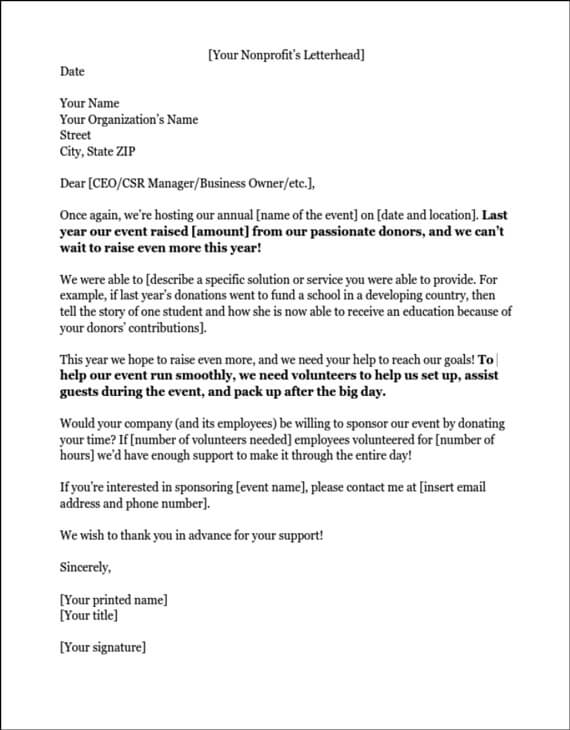
Follow these best practices when writing sponsorship letters for requesting volunteers:
- Tie the recipient to your cause. It’s important to connect with the reader right away. Speak to your recipients’ emotions with a story that explains how the funds will be used. When readers are connected to your cause, they’ll be more invested in what you have to say.
- Explain why you need volunteers. You should not only let companies know that you need volunteers but also explain how their support will impact the outcome of the event. Let your recipients know what tasks the volunteers will complete so that companies understand what to expect.
- Make your “ask” concrete. Just asking for volunteers is unclear, and the goal, as with any solicitation, should be to ask for exactly what you need. By providing the reader with the specifics (amount of volunteers and number of hours needed), recipients won’t have to guess.
- Include your email and phone number. Leave your contact information in the letter so that interested sponsors can contact you to hash out the details.
11. Sponsorship Levels Document
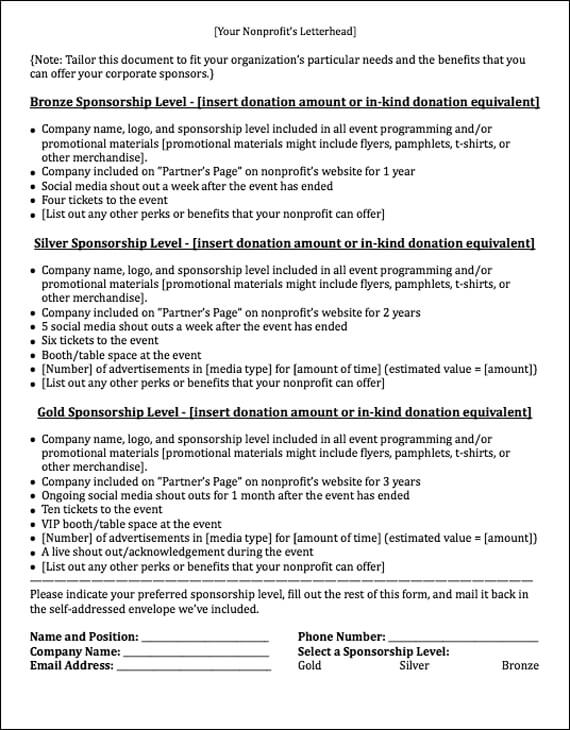
When creating a sponsorship levels document, follow these best practices:
- Be as specific as possible. It’s sometimes okay to be more general in your sponsorship proposal cover letter, but you can’t beat around the bush when it comes to your sponsorship levels document. List out a few different donation amounts ranging from a couple hundred to, potentially, tens of thousands of dollars. Then, list the benefits that come with each donation amount.
- List out incentives for in-kind donations. Many nonprofits forget about in-kind donations when it comes to their sponsorship level documents. They only list incentives for cash donations. However, many corporate donations come in the form of goods and services. While you can’t list out every possible in-kind contribution you could receive, you can delineate examples and include the incentives that come along with donations of that type.
- Create a hierarchy. To make it easier for your donors and your organization, it might be worthwhile to create a hierarchy of giving levels. The most common are Gold, Silver, and Bronze, but feel free to get creative with your giving hierarchy! You can make it tailored to your nonprofit as a whole or keep it on theme with your specific fundraising event.
- Include a place for donors to indicate their giving level. Once you’ve listed out all of your giving levels, make sure that you give your donors a way to indicate how much they’d like to give. The bottom of your sponsorship levels document should include a tear-off section that collects your donor’s name, contact information, and preferred giving level.
12. Sponsorship Acknowledgement Letter

Follow these best practices when writing sponsorship acknowledgement letters:
- Be sincere. Your sponsorship acknowledgement letter should come from the heart. Your corporate donors can make a huge impact on your fundraising efforts, and they deserve to know just how much your nonprofit appreciates them! Show your gratitude by writing a unique letter for each corporate donor.
- Tell them what the donation went toward. If you want to demonstrate the impact that your corporate donors had on your event (and you should!), let them know exactly what their donation went toward! While you may not be able to list out everything you were able to accomplish down to the last penny, you can give your donors a solid idea of how they contributed to your cause and mission.
- Offer other engagement opportunities. While an acknowledgement letter is never the place to ask for another donation, you can use your sponsorship acknowledgement letter to offer your donors other ways to get involved. Maybe you have an open seat on your board. Or perhaps there’s an upcoming volunteer event you think they’d be interested in. Whatever the case, let them know about the other ways they can get involved!
- Send the letter promptly. Don’t let too much time pass before you send out your sponsorship acknowledgement letter! You can send a quick note after you receive their response from your sponsorship levels document, but you should follow up with a detailed and well-written acknowledgement no later than a week after your event has concluded.
Additional Resources
- How to Ask for Donations: Your Top Questions Answered . This guide will take you through the best practices that will make you an expert on soliciting donations. You can even use these techniques in your other fundraising letters.
- Donation Request Letters: Fundraising Made Easy. Explore our top donation request letter templates to start raising more from individuals and local businesses.
- Fundraising Letters: Free Examples to Successfully Ask for Donations . Take a look at our favorite fundraising letters and download your very own templates. Start raising more money with these fundraising letters!
Crowdfunding Resources
- Crowdfunding (Beginner’s Guide)
- 30+ Standout Crowdfunding Websites
- Success Stories
- Tell Your Story
Fundraising Resources:
- 150+ Fundraising Ideas
- 45+ Youth Fundraising Ideas
- How to Ask for Donations
- Peer-to-Peer Fundraising Guide
Popular Resources
- GoFundMe Alternatives
- Top Companies That Donate to Nonprofits
- How to Write a Fundraising Letter

Fundly is dedicated to providing you with the tools you need to raise money for whatever your cause may be.

Your Name (required)
Your Email (required)
Your Message
How to Write a Sponsorship Letter (With Free Template and Examples)
Susanna fleming.

After using Anedot:
Table of contents.

I recently had a conversation with a young nonprofit founder who was new to the fundraising world.
As I shared a few of my favorite tips and tricks for the fundraising process, she offered up a question that I'm sure many of us have asked before.
How do I establish long-term relationships with financial partners and investors?
This, my friends, is at the very heart of nonprofit fundraising .
While an aggregate of one-time donations can certainly sustain a nonprofit for some time, long-term relationships with key partners are essential to your nonprofit's financial stability, growth, and ability to make a lasting impact.
With this goal in mind, I introduced my friend to one of my favorite tools for connecting with new prospects: the sponsorship letter.
What is a sponsorship letter?

While standard donation letters are written to request financial support, sponsorship letters request strategic partnerships with businesses and individuals.
These strategic partnerships usually include financial support in exchange for incentives, creating a win-win situation for both your nonprofit and the supporting brand or organization.
Importantly, sponsorship letters are not typically effective when we view them as a complete proposal.
The sponsorship letter's goal should be to pique potential partners' interest , hopefully leading to a meeting or follow-up phone call in which you can present a full proposal.
Think back to your days in an elementary school cafeteria. Perhaps your parents always packed Gushers fruit snacks in your paper bag lunch when you actually wanted Cool Ranch Doritos.
You could ask a different friend to share their Cool Ranch Doritos with you each day, or you could get strategic.
You could find a classmate who would rather have Gushers every day than their daily bag of Doritos, pass them a note in class suggesting a deal, and initiate a long-term, mutually beneficial relationship.
This is a rather simplistic example, of course, but it helps paint a picture of the kind of long-term relationships that sponsorship letters seek to create.
What kind of incentives can you offer?

What kind of incentives should you offer potential sponsors?
To answer this question, you have to begin by asking how you can provide value to their brand or organization.
If you want to pitch incentives that sponsors want, you must think beyond logo representation. Ninety percent of the time, the best incentive you can offer is a shared target audience.
Let's say you are hosting a 5k fundraising run to help raise money for your nonprofit's animal shelter, and participants are invited to register their dogs as running buddies.
As you consider which sponsors may be willing to provide post-race treats, take a moment to think about organizations that would benefit from sharing your marketing real estate.
Perhaps a local pet store would like to promote its products with the dog community by offering dog water dishes at the finish line.
Maybe a peanut butter brand (a favorite of both dogs and humans) would see an increase in sales if they gave out free samples to participants.
Other marketing opportunities for your sponsors may include:
- An opportunity to speak at an event, or a fundraising gala
- Social media shout-outs
- Including the sponsor's name on all event communications
- Podcast advertising space
- Advertising space in an event program
- VIP experiences (reserved seating or special treatment)
- Employee engagement (volunteer days or team-building events)
As you can see, a shared target audience can be a powerful incentive for potential sponsors!
→ Learn the ins and out of optimum fiscal sponsorship for nonprofits - how it works, what the best practices and potential risks are, and more!
Sponsorship letter template

Once you have determined which kind of incentives you can offer potential sponsors, it's time to get writing!
Because the most effective sponsorship letters offer specific incentive examples that include a shared target audience, it is best to avoid sending a copy-and-paste email to a mass list of businesses.
Instead, carefully select which businesses you would like to approach and begin crafting letters for each one. This can be time-consuming, of course, but it is worth it!
There are several templates you can use to write a sponsorship letter, but you will want to follow these basic principles.
- Begin your letter by addressing your potential sponsor personally. Avoid pleasantries such as "To whom it may concern," and try to use first names and titles. This may require research, but it will increase the likelihood that your letter will be read.
- Take time to explain your nonprofit's mission , history, and unique contribution to the world, but keep this section brief. You want the main portion of your letter to focus on the incentives you can offer your sponsor.
- Show your potential sponsor that you have done your homework. Offer research about your target audience and explain why your potential sponsor would benefit from having access to this audience.
- Give examples of creative marketing incentives you can offer or have offered sponsors in the past. This will help your potential sponsor feel more confident in moving forward.
- Finish the letter with information about how and when you will follow up. This letter is meant to serve as an introduction to your proposal for sponsorship, so the ball is still in your court.
→ Learn about the importance of nonprofit innovation , how nonprofits can begin to innovate, and more from our conversation with Nathan Hill of NextAfter!
Example of a sponsorship letter for an event

Now that you understand the general flow of sponsorship letters, here is an example of a letter that you can send when you are looking for event sponsors.
Sponsorship letter for event:
Dear Jessica,
I hope you are doing well. My name is Susanna, and I am the Philanthropy Coordinator at Paws for a Cause. We are dedicated to improving the lives of dogs through rescue and rehabilitation and by promoting responsible dog ownership. In July, we will be hosting our "Tails on the Trail 5k," and we are looking for potential partners to sponsor this event.
The majority of runners who will be participating in this 5k are environmentally conscious individuals who are highly committed to the health of their dogs. Many of our supporters are also passionate about shopping locally. I believe that they would be highly interested in the variety of organic dog food options that The Green Pet Pantry offers. At our past 5k events, we have offered sponsors an advertising booth and a speaking opportunity during the post-race festivities to promote awareness for their organizations.
This year, we are in need of sponsors who would be willing to provide post-race snacks. I think your organic dog treats could be a perfect fit, and you would have an opportunity for exposure with many potential new clients.
I plan to follow up within two weeks via phone call. Until then, feel free to reach out if you have any questions! I'm looking forward to connecting.
Susanna Philanthropy Coordinator
Example of a follow-up letter

If you called your potential sponsor and did not hear back, you may want to send one additional follow-up letter. Here is an example letter.
Sponsorship letter follow-up:
I hope you are having a great week. I wanted to follow up about the letter I sent you a few weeks ago regarding our "Tails on the Trail 5k" in July. As you know, The Green Pet Pantry is a favorite destination for environmentally conscious customers who love to feed their dogs healthy food, and this is precisely the kind of person who will be running our 5k.
Since I last reached out, we have secured sponsors for three finish-line booths, but we are still looking to partner with organizations that align with our mission and cause. We are hoping to gather dog treats or other goodies to hand out to finishers, and we think your organic dog treats would be perfect! In exchange, The Green Pet Pantry will receive a booth and a brief speaking opportunity during the post-race party.
It would be wonderful to receive your support as we take action to improve the lives of dogs in need! I would love to chat about this opportunity. Please feel free to reach out at [phone number].
→ Discover ten strategies to bring in major gift fundraising that you can implement today!
Write a standout sponsorship letter

Sponsorship letters may feel intimidating at first, but they are powerful fundraising tools that help you develop long-term, mutually beneficial relationships.
By doing your research, offering the right incentives, and helping future sponsors understand the benefit of a partnership, you will create strategic relationships that help your nonprofit accomplish its mission.
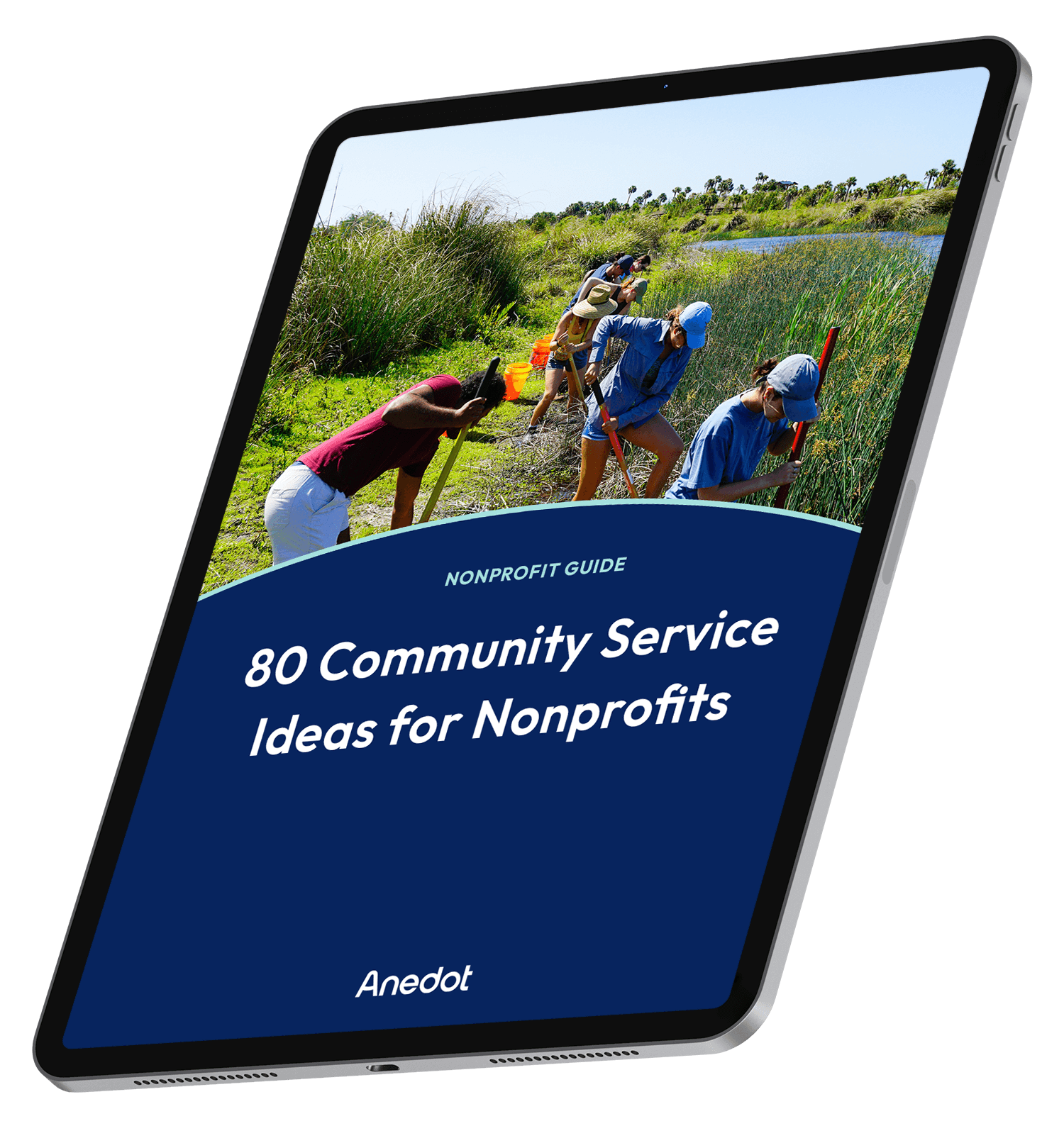
80 Community Service Ideas for Nonprofits

Show notes:
How to attract a new corporate partner in less than 30 days.

How to Listen and Capture Powerful Stories to Grow Your Nonprofit

10 Things You Can Do For Your Ministry Staff (When You Can’t Give A Raise)
Church giving checklist (best practices to grow church giving).

7 Ways to Recession-proof Your Church
Related posts.

6 Social Media Marketing Tips for Nonprofits
Here are 6 tips to jumpstart your nonprofit organization’s social media marketing strategy!

LinkedIn for Nonprofits: How Your Nonprofit Can Leverage LinkedIn for Impact
Learn how to leverage LinkedIn for nonprofits to help build your brand, promote your culture, engage donors, and more from our conversation with Anthony Jones!

Donation Receipt Template Best Practices
Here are some best practices to create the perfect donation receipt template for your next fundraising initiative.
Get updates on Anedot's best content
Drop your email and get tips delivered to your inbox every month!
Save time and money with Anedot

How To Write A Sponsorship Request Letter (+ Sample)
Author: adie m..

Mastering sponsorship request letter writing is an essential skill to have in your nonprofit toolbox. Acquiring sponsorships can help you reach your company goals quickly while creating strong business relationships. Having great sponsors to partner with can also increase trust in your organization and expand future opportunities for collaboration.
A well-crafted sponsorship letter is one of the basic keys to opening up this fundraising avenue.
What Is A Sponsorship Request Letter?
A sponsorship letter is a request for partnership and collaboration, primarily focused on nurturing a relationship with a business counterpart. Although you can use it to ask for financial contributions for a fundraising program or effort, it is an opportunity for other forms of partnership, too.
You can ask a business or donor to assist you with your resources, work with you long-term, volunteer, and more. For example, if you’re hosting an event, you may ask for event sponsorship for a venue or other logistical resources. Your ask may also be non-tangible like ambassadorship, airtime, backing, etc.
One of the fundamental ways that a sponsorship request letter differs from a donation or fundraising request letter is incentive. As with any other relationship, this letter should outline an offering from your NPO.
How To Write A Sponsorship Request Letter
1. note your goals.
Reflect on what you would like out of this partnership. What do you need from them? How would you like them to help you? Knowing your goals will help you craft a sponsorship request letter that makes it clear what you’re asking for and why them . This is also a chance to tell them about you and what your company vision and cause is.
2. Know The Recipient
Next, look into your recipients. Maybe make a list of potential sponsors and why you would like to work with them. Do research into each business and know its values, mission, audience, and other information.
The letter you write is about connecting with them so you should place them as your focus and show why your organizations can work well together.
3. Personalize The Details
Nothing will put your letter’s recipient off faster than feeling like you’ve sent them a generic template. Use the research you’ve conducted to write a tailored letter that aims to connect to the reader.
To do this, remember the small details like using a name rather than stating “To Whom It May Concern”. Ensure you get spelling and specific business terms right. And weave in elements that show that you know their business (like their business values, ethos, mission, etc.) and link them to your work.
4. Use Past Or Existing Connections
If there is someone in your organization with a connection with the potential sponsor, ask them to write the letter. The recipient may be more open to getting and reading a letter from someone they know. It gives a face to your organization and helps them connect to your request. It is also another way to create a personal link to the reader.
Should there be no such connection, have your letter signed by your NPO’s leadership (i.e.: the company president or exec). This gives legitimacy to your request and emphasizes its importance.

5. Consider What You Can Offer
Think about what you can give to the business in exchange. Many businesses work on a benefits attitude, investing in things that bring them some gain. So, what will you offer them? Make this a central point in your letter, remembering to see your request from their perspective. Try to consider what would benefit them.
Some of the things you can offer include:
- Advertising space (like logo inclusion) on all your public communications
- A public acknowledgment letter for their support
- Speaking time at your NPO event
- Advertising space or booths at your events
- Product placement on your social media
- Listing as an official supporter on your website
- Collaborative merchandise like tote bags
- Including their products in event swag bags
6. Offer Them A Choice
Depending on the organization, you can offer them one or more of the benefit options above to choose from. This is the beginning of your collaboration as they get to play an active role rather than passively receiving your letter.
Another choice you can offer is to give them the other participation options and make it known you’re open to various types of collaborations.
7. Stay Concise
Try to consider how much work the person reading your letter may have. Do not take up too much of their time and prioritize clarity. Use short sentences and brief paragraphs. Aim to keep your letter shorter than a page or one and a half pages max. They’re more likely to remember a clearly-stated, concise read than a convoluted three-page letter.
8. Outline Next Steps
At the end of your letter, outline clear next steps telling them where you will go from here. These should be easy and inform them what they should do after reading. Let them know how they can approve the request and how they can respond. Include a call to action that bolsters them to take action.
Sponsorship Request Letter Sample
Subject: Sponsorship opportunity | Business Name x Your Nonprofit’s Name
Hi [Recipient’s Name],
We at [Your NPO] have been following the work of your business. [Business Name]’s mission and vision of [include vision and/or mission] are in line with the values we hold as a team. We see a wonderful opportunity to collaborate and were wondering if you’d be interested in sponsoring our [event, auction items, fundraising initiative].
Our cause supports [insert your mission and aims]. With this collaboration, your customers can see you take action and work with us to [insert your mission/cause].
This partnership would entail:
[Financial/product/space contributions]
[Resource/time commitments]
[Incentive for their business]
I look forward to speaking more about this partnership and to potentially working with you. You are welcome to ask any questions if you need to and I will follow up within the week.
Best regards,
[Your name]
[Leadership signature]
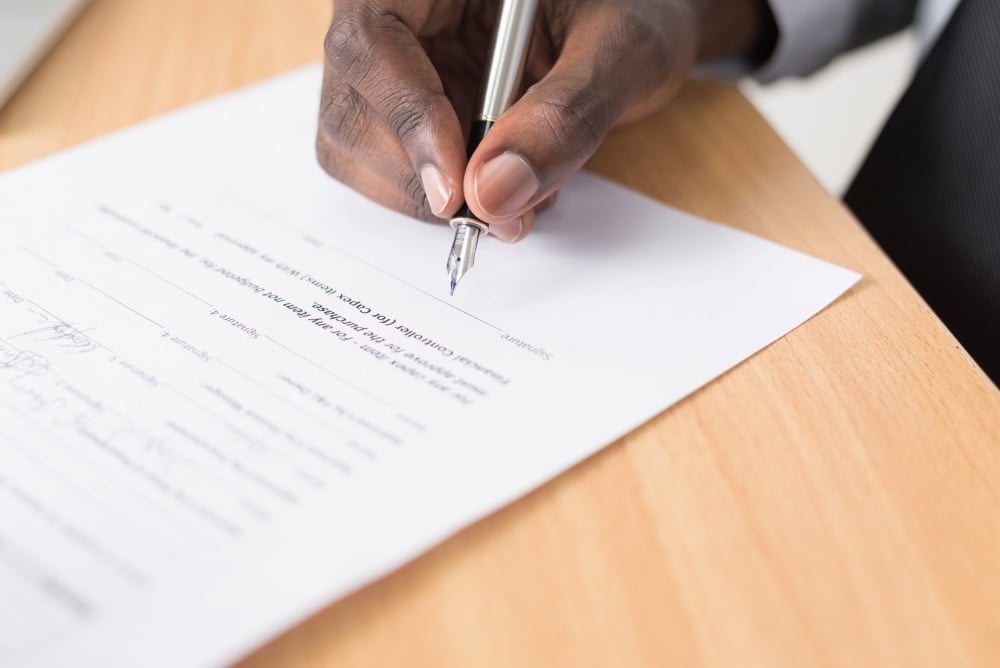
Final Thoughts
Now, you’re ready to delve into the world of NPO partnerships and sponsorships! Just keep this guide handy and you’re sure to wow with your writing.

Mo-Fri 9 am to 5 pm Eastern Time 24/7 critical emergency support All currencies supported
Quick Links
- Payment Integration
- Riskfreeitemshop.com
- Learning Center
- FAQ and Knowledge Base
- Terms and Condition
- Privacy Policy
Contact Info
- Address: PO Box 1531 Gaylord, MI 49734
- Phone: 1.989.448.2189 ET
- Email: [email protected]
Published In: Letters
Writing a Useful Sponsorship Letter (Free Samples)
If you are looking to get a sponsor for your event or anything else you are doing, you should know how to draft a great sponsorship letter to convince them to offer their support. Basically, a sponsorship letter is a letter written to a business or an individual asking them to contribute to an event, provide long-term support or fundraising initiative. A sponsorship letter, also referred to as a sponsorship proposal, is a chance for you to secure funding from your sponsor of choice.
The letter is written to convince the potential sponsor that what you are planning to do is worth supporting and should clearly outline the benefits that they stand to get from offering their support. Remember that you are not only asking them for money, of course but also telling them how their contributions would be used while incentive’s them to consider offering you their support. Drafting a great sponsorship letter can make all the difference between being ignored or securing the sponsorship.
What is a Sponsorship Letter
A sponsorship letter also referred to as a sponsorship proposal, is a letter written to prospective sponsors to secure funding for an event or anything else that one is planning to do. A sponsorship letter is not all about asking for money, but it is a way of explaining to the potential sponsors how their money will be used while incentivizing them to consider giving.
How to Write a Sponsorship Letter
The key elements of a sponsorship letter include:
An introduction about yourself and your opportunity
When writing your sponsorship letter, this is not the time for you to write all the details about your organization, what you do, your history, and how much money you are looking to get to accomplish your goals. Instead, you should use the introduction part of your sponsorship letter to describe who you are with a brief introduction about your organization.
The reason for your writing
Inform the potential sponsor of your reason for writing. Inform them of their corporate goals that are in line with yours. Do they have a history of sponsoring events like yours? Is your audience important to them? Is your main contact involved in organizations like yours?
This is your chance to show the potential sponsor that you have done your homework and that you are not just sending thousands of letters to any organization that you come across.
Information about your audience
This is a chance for you to stand out! Sponsorship is all about sales and marketing, and both require one to have a target customer to work with. Do you know your potential sponsors’ target audience? This is your chance to prove it to them.
Your sponsorship opportunities and your activation
Rather than focusing on the amount of money you are looking to get from the sponsor, you should use your sponsorship letter to show your potential employer that you understand how sponsorship works. Give them some examples of activation ideas that they and their audience would love.
Show them some of the things you can offer them, such as branding, product placements, sampling, contests, etc. Be clear and specific about the way you work with sponsors and how they can add value to your audience.
A mention of when you will follow up
Let your potential sponsors know that you will be following up on the letter and be specific on when you will do so. Inform them that you will be calling them on a specific day or when you will be visiting their office to discuss the sponsorship more.
When Not to Send a Sponsorship Letter
There are some instances where a sponsorship letter can do you no good; these include:
When you have no prior connection with the potential sponsor: Every day, organizations are looking for sponsors for their events. Maybe they won’t be sending their letters to the same sponsor, but the story is almost the same in all the applicants.
Any sponsor who is well known to sponsor organizations will, in most cases, have piles upon piles of letters and endless emails. Having a prior connection with the sponsor or with someone that they already know will help set you apart from the rest.
When you don’t know much or if you have forgotten about your audience data : When you are looking for a sponsor, it is advisable to choose one that at least you have some common areas with – be it a similar goal or the same audience. You may know your audience well enough, but the sponsor has no way of getting the same information if you leave out your audience data.
When you have a tight timeline : If your event is almost due, then you might as well forget trying to get a sponsor at this point. By the time the letter reaches them, it would probably be too late for them to do anything. They could want to help you, but a tight timeline might hinder them from doing so.
What Can you Offer the Sponsor in Return for their Sponsorship?
There are several things that one can choose from to offer their sponsor in return for their sponsorship.
These include:
- A booth at the event
- Social media shout-outs
- Advertising space in the event’s program
- Public acknowledgment of their support
- A chance for them to speak at the event
- Promotional materials
- Including them in the online “Supporters’ list.”
Free Sponsorship Letter Templates & Examples
If you need some help drafting our sponsorship letter, don’t worry, we’ve got you! We have compiled some of the best templates that you can download and use at your convenience. Simply choose one that fits your specific situation, change a few things, make sure that the details are all correct, and you are good to go.
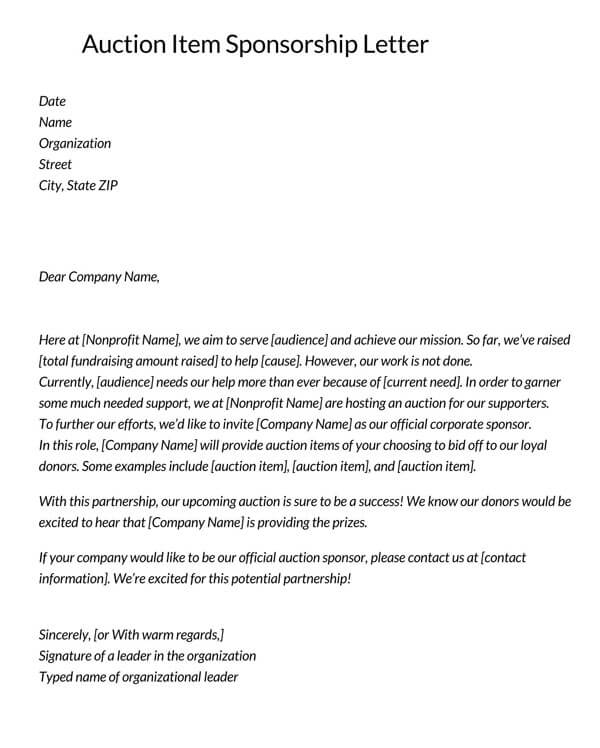
Tips for Writing a Great Sponsorship Letter
- Lead in with your connection: If you know, someone that is connected to the sponsor or you have already met with the sponsor at an event, start with that, then proceed with the money request.
- Personalize letter: In as much as it takes more time and effort to draft a personalized letter, it is important than simply inserting some names into a generic template as it will sound more appealing to the sponsor.
- Remember the letter is about the sponsor: Another key reason to personalize your letter is to keep the focus where it is supposed to be- on the sponsor. A sentence or two about who you are is important, but it should be all about the sponsor for most of the letter.
- Keep it short: sponsors get a lot of letters and emails every day. It is therefore important that you make the letter fit on a single page of printed paper. In as much as there is no hard and fast word count rule in writing sponsorship letters, a few paragraphs should do.
- Ask for their opinion: Asking for the sponsor’s opinion is a great way of piquing the sponsor’s interest; try asking for something from them. In doing so, you are conceding that they are an expert in that field. You are also showing them that you value what they have to say, something that could onset your relationship with them.
- Set a time for a phone call or a meeting with them: Do not leave it up to the sponsors to determine when to contact you – propose for them a day and time when you will contact them to expound more on your request.
Things to Avoid in your Sponsorship Letter
Here are a few things that you should avoid including in your sponsorship letter:
- Sponsorship contracts/agreements the first time you reach out to them
- Focusing on need
- Specific financial requests
- Leaflets, samples, proposals, or pamphlets
- An assumption about their key demographics
- Sponsorship levels and grids
- Pictures of your stakeholders and your audience
- An assumption about their demographic and their target audience
Whereas a well-drafted sponsorship letter can be valuable to get an in with a prospective sponsor, one cannot just ask for money right off the bat. There is an art to drafting a great sponsorship letter. With the templates provided, info-graphics, writing tips, what to avoid in your letter highlighted in this article, you are well on your way to nailing your sponsorship letter.
Related Documents
Table of Contents
How to ask for sponsorship for an event, how to write a sponsorship letter: a step-by-step guide, template: sample sponsorship request letter for event, chatgpt prompts to help write an event sponsorship letter, hold that thought: when not to send a sponsorship request, how to write a sponsorship request letter (with template and chatgpt prompts).

Are you planning an event and need sponsors to support your vision? Securing sponsorships can be a critical aspect of event planning, as it provides financial resources and brand exposure to make your event successful. But how do you effectively approach potential sponsors and get them to respond positively to your sponsorship request letter?
Knowing how to write a sponsorship letter that will get the right responses is clutch in today’s market. With in-person events regaining dominance, the global event sponsorship market size is projected to reach $127.1 billion by 2027, growing at a CAGR of 3.5% from 2023 to 2027! Plus, with a constant uncertainty looming over the economy, the competition for event sponsorship is stiff these days.
In this article, we’ll guide you through emailing potential event sponsors and provide a sponsorship email template too. So let’s dive in and learn how to craft an impactful sponsorship email and elicit a positive response to get you the event sponsorship support you need in these challenging economic times.
Before you start drafting your sponsorship email, it’s essential to have a clear strategy in mind. Here are some key steps to follow when asking for sponsorship for an event :
- Identify potential sponsors: Conduct thorough research to identify companies or organizations that align with your event’s theme, purpose, or target audience. Consider local businesses and larger corporations with a history of sponsoring events.
- Understand the benefits of sponsoring an event: Put yourself in the shoes of potential sponsors and think about what they would gain by supporting your event. Consider the exposure, brand visibility, networking opportunities, and positive public image associated with sponsoring an event.
- Add sponsorship package information to your event website: Be sure to create a page on your website that outlines the sponsorship packages available to potential sponsors. You can also create PDF that outlines each of the opportunities available to sponsors. A great example of an event site with an outstanding and thorough sponsorship page is AWS re:Invent. This page features sponsor testimonials, a video, package information, and more.
- Determine the appropriate contact person: Find out who handles sponsorship in the company you’re targeting. Look for contact information on their website, or call to inquire about the correct person to address your sponsorship request letter. This will help personalize your email and increase the chances of receiving a response.
- Tailor your email to the recipient: Craft a personalized email communicating why you contacted the specific company and how their sponsorship would align with their goals. Highlight the benefits they would receive from sponsoring your events, such as increased brand visibility, access to a targeted audience, or networking opportunities.
- Follow-up: If you are still waiting for a response after a reasonable time, please send a follow-up email. Sometimes, your initial email may get overlooked because of busy schedules. A polite and professional follow-up can remind the recipient and show your dedication to making the sponsorship opportunity successful.
Now that you have a clear idea of approaching potential sponsors let’s explore the step-by-step process of writing a sponsorship letter.

Photo by Christina Morillo
Writing an effective sponsorship letter is crucial to convey your message, outlining the benefits of sponsoring your event, and generating interest from potential sponsors. Here is a step-by-step guide to help you craft a compelling sponsorship letter:
1. Start with a professional but approachable greeting
Address the recipient by their name or job title, such as “Dear [Sponsorship Manager]” or “Dear [Company Name] Sponsorship Team.” Be sure you don’t sound robotic, but don’t greet them like drinking buddies.
2. Introduce yourself and your event
Introduce yourself, your organization, and the event you are planning. Clearly state the purpose and goals of the event, emphasizing its relevance to the potential sponsor.
3. Highlight the benefits
Explain the benefits the sponsor would gain by supporting your event. Focus on how sponsoring your event can enhance their brand visibility, connect them with their target audience, or contribute to their corporate social responsibility initiatives.
4. Provide sponsorship options
Present different sponsorship levels or packages to cater to various budgets and objectives. Clearly outline each sponsorship level’s specific benefits and exposure, including logo placement, speaking opportunities, or exclusive access to event attendees.
5. Include testimonials or success stories
If you have hosted similar events or have testimonials from previous sponsors, include them in your letter to build credibility and demonstrate the positive impact of sponsoring your events.
6. Call to action
Clearly state the next steps you want the potential sponsor to take. Whether scheduling a meeting, requesting additional information, or submitting a sponsorship commitment form, make it easy for them to respond and engage with you.
7. Express gratitude and follow-up
Close your letter by expressing gratitude for their consideration and emphasizing your willingness to answer any questions or provide further details. Include your contact information and invite them to contact you with any inquiries or discuss sponsorship opportunities.
Now that you have a framework for crafting your sponsorship letter, here is a sponsorship email template to get you started. But don’t hesitate to use AI content tools like ChatGPT to help you craft the perfect sponsorship request letter!

The great thing about a solid sponsorship request letter template is that it will work for any sponsorship letter: a corporate sponsorship letter, nonprofit sponsorship letter, business sponsorship letter — you name it.
Subject: Opportunity for Partnership: Sponsorship for [Event Name] Dear [Recipient’s Name], I hope this email finds you well. My name is [Your Name], and I’m contacting you on behalf of [Organization]. We’re excited to present our upcoming [Event Name] on [Event Date] at [Event Venue]. At [Your Organization], we are dedicated to [Briefly describe your organization’s mission or purpose]. Our [Event Name] aims to [Briefly describe the purpose and goals of the event]. We believe that [Company Name] would be an ideal partner for this event. Your support would provide exceptional brand visibility, networking opportunities, and the chance to showcase your commitment to corporate social responsibility. We have created various sponsorship opportunities to suit various budgets and objectives. By becoming a sponsor for [Event Name], [Company Name] would receive benefits such as: 1) Logo placement on event promotional materials, signage, and mobile event app 2) Recognition in press releases and media coverage 3) Exclusive access to our event attendees and networking opportunities 4) Verbal acknowledgment during the event’s opening and closing remarks 5) Opportunity to distribute marketing materials or promotional items to event participants I have attached our comprehensive sponsorship package that provides detailed information about each sponsorship level and the associated benefits. I would be thrilled to discuss these sponsorship opportunities further and explore how our partnership can yield mutual benefits. I am available at your convenience to schedule a meeting or have a phone call to address any questions you may have. Thank you for considering this opportunity to support [Event Name]. Your sponsorship would contribute to our event’s success and demonstrate your commitment to our community and its initiatives. I look forward to collaborating with [Company Name] and making [Event Name] a memorable and successful event. Please reply to this email or call me at [Your Phone Number] if you’d like to discuss further. Thank you for your time and consideration. Sincerely, [Your Name] [Your Title/Position] [Your Organization]
Whether you use ChatGPT or the many alternatives to ChatGPT, here are some prompts to get you inspired and started as you refine how to ask for sponsorship for an event.
- Suggest 15 companies that would be interested in sponsoring an event focused on database technology.
- We’re hosting a conference for women in food technology. Can you write an email letter to Jubilee Roasting Company in Denver, Colorado, asking them to sponsor our event? We think our “Chef” sponsorship package would be the best for them.
- Our company is holding a conference for EdTech startups in St. Louis on March 5, 2024. We want to send out sponsorship requests to some nonprofits in the education space. Can you write an email asking them to sponsor our event?
- Act like the University of Arizona CMO and write a short, fun email to local Arizona businesses asking them to sponsor our summer series of micro-events for incoming students. Talk about how it will expose new students to their brand and boost awareness.
ChatGPT Event Sponsorship Email Examples
Curious what ChatGPT output looks like for one of those prompts? Here’s the output for the University of Arizona prompt:
Subject: Exciting Sponsorship Opportunity for Arizona Businesses: Connect with Future Wildcats! Dear [Business Name], Greetings from the University of Arizona! As the Chief Marketing Officer of our esteemed institution, I am thrilled to reach out to you with an incredible sponsorship opportunity that will make your summer sizzle with excitement. At the University of Arizona, we are known for our vibrant campus life and commitment to providing an exceptional student experience. As part of our ongoing efforts to welcome and engage our incoming students, we are organizing a series of epic micro-events throughout the summer. These events will introduce our future Wildcats to the amazing local businesses that make Arizona shine. Why should you get involved, you ask? Well, let me tell you! Expose Your Brand to a Captive Audience: Picture this: a throng of eager students, fresh-faced and ready to embark on their college journey. By sponsoring our summer micro-events, your brand will have the undivided attention of these curious minds. It’s the perfect chance to make a lasting impression, creating a connection that could lead to lifelong brand loyalty. Boost Awareness Among the Next Generation of Consumers: Our incoming students are a dynamic bunch, always on the lookout for new experiences and exciting brands. By aligning your business with our summer series, you’ll tap into the enthusiasm and energy of this demographic. Think of it as a fast track to boosting awareness and expanding your reach among a key consumer group. Stand Out from the Competition: In a world of advertising clutter, it’s essential to find unique ways to make your brand shine. Our micro-events provide a fun, engaging platform for you to showcase your products or services in an environment that’s not just another ad space. Stand out from the crowd and leave a memorable impression on the minds (and taste buds!) of our incoming students. Join the Wildcat Family: By partnering with the University of Arizona, you become part of our Wildcat family. This means you’ll have access to a network of engaged alumni, loyal fans, and passionate supporters. Our community is known for its unwavering support of local businesses, and as a sponsor, you’ll tap into this incredible support system. So, are you ready to embark on this wild adventure with us? Let’s collaborate to create an unforgettable summer series that will captivate our incoming students and put your brand in the spotlight. If you’re curious to learn more about the available sponsorship opportunities or discuss how we can customize a package to suit your business goals, simply reply to this email or give me a call at [Your Phone Number]. I’ll be delighted to provide you with all the details and answer any questions you may have. Thank you for considering this electrifying opportunity to connect with our future Wildcats. Together, we can create an extraordinary experience that will shape the memories of our students and showcase the best of what Arizona has to offer. Bear Down and Go Wildcats! Sincerely, [Your Name] Chief Marketing Officer University of Arizona
Although sponsorship letters can be an effective way to reach potential sponsors, there are certain situations where sending a sponsorship email might not be advisable. Here are a few scenarios in which it might be a bad idea to send a sponsorship letter:
- Lack of research: If you haven’t done thorough research on the potential sponsor, including their values, target audience, and previous sponsorship activities, it may not be the right time to send a sponsorship letter. Without this information, your letter may not resonate with the sponsor and could be generic or irrelevant.
- Poor timing: Timing is crucial when sending a sponsorship letter. If the potential sponsor faces financial challenges, restructuring, or other business issues, there may be a better time to approach them for sponsorship. Sending a sponsorship letter during such times may be perceived as insensitive or inconsiderate.
- Incomplete event planning: If your event plans are still in the early stages, and you don’t have a clear vision, objectives, or specific benefits to offer sponsors, it may be premature to send a sponsorship letter. Sponsors want to see a well-defined event concept and a compelling value proposition before committing resources.
- Lack of alignment: If there is a significant mismatch between your event and the potential sponsor’s industry, values, or target audience, it may not be advisable to send an event sponsorship letter. Sponsors are more likely to engage when there is a strong alignment between their brand and the event’s purpose.
- Previous negative experiences: If you have had negative interactions or experiences with the potential sponsor, it might be best to reconsider sending a sponsorship letter. Maintaining a positive and professional relationship with potential sponsors is essential, and sending a letter when there are unresolved issues may yield a different response.
- Overly generic approach: If your sponsorship letter feels impersonal or needs more customization, it may not be well-received. Potential sponsors want to see that you have taken the time to understand their organization and how they can benefit from sponsoring your event. Sending a generic sponsorship letter without tailoring it to the specific recipient can diminish your chances of receiving a positive response.
Before sending a sponsorship letter, it’s essential to consider research, timing, event planning, alignment, previous experiences, and personalization. Considering these aspects will increase the likelihood of a favorable response and pave the way for a successful sponsorship partnership.
By following these guidelines and using the provided templates, you can create persuasive sponsorship emails that increase your chances of securing support for your event. Remember to personalize each email, clearly communicate the benefits to potential sponsors, and follow up as necessary. Good luck with your sponsorship requests, and may your event be a resounding success!

You may also be interested in

Continuing the Leadership Streak: Bizzabo Secures 19 G2 Leader Awards for Spring 2024

How To Craft Enticing Event Sponsorship Packages

Tackling Event Email Marketing Challenges: Key Insights from Experts
Enjoying this article.
- Event Software Overview
- Klik Experiential & SmartBadge
- Product Integrations
- Security & Compliance
- Enterprise Event Software
- Insights & Reporting
- Capabilities
- Room Block Management
- Event Content
- Event Management
- Event Networking
- Event Marketing
- Audience Engagement
- Onsite Software & Wearables
- Event Live Streaming
- Sponsors & Exhibitors
- Mobile Event App
- Event Registration Software
- By Event Format
- In-person Events
- Virtual Events
- Hybrid Events
- By Use Case
- Conferences
- Field Marketing
- Internal Events
- By Who You Are
- Corporations
- Higher Education
- Associations
- Customer Stories
- Knowledge Center
- Professional Services
- Bizzabo Studios
- Hopin vs. Bizzabo
- Cvent vs. Bizzabo
- Stova vs. Bizzabo
- Resource Library
- Event Success Book
- Event Experience Podcast
- Conference Planning Guide
- AI-assisted Events Guide
- Event Management FAQs
- Become a Partner
- Press & Awards
- Help Us Grow
Maximize your event ROI with Bizzabo

Dear Nonprofit, Here's How to Write a Sponsorship Letter (with Templates, Examples, and Tips)

To pull off a successful fundraising event, many pieces need to fall into place. You need the programming, the buzz, the food, the music, and the mood lighting. But perhaps nothing is as important as the sponsors.
Sponsors are the monetary wind beneath your event’s wings. And if you want to reel them in, you need some special tools—and we’re here to equip you with the best of the best. From initial outreach to cultivating long-term relationships, here’s everything you need to know to get those sponsorship dollars and make every fundraising event a huge success.
What is a sponsorship letter?
Back to basics—we love it! A sponsorship letter is a formal letter asking for financial or in-kind support from a company or an individual. While it can come from anyone, be it an enterprising solopreneur or a local business, here, we’re focused solely on nonprofit sponsorship requests. Every letter is unique, but the goal is always the same: convince the recipient that their support will have a huge impact and that it’s worth their investment. Most sponsor letters include information about the nonprofit mission, the event itself, and the potential benefits for the sponsor.
Why is a sponsorship letter important?
With a well-crafted, extremely persuasive sponsorship letter, nonprofit organizations can woo the sponsors of their dreams, cultivate long-term relationships, and hit their fundraising goal. Think of every sponsorship opportunity as a partnership opportunity. Yes, a great letter means financial support, but it’s also an opportunity to connect with the community and form a mutually beneficial partnership that lasts for years to come.
How do you ask for a sponsorship?
Now that we’re in agreement that event sponsorships are key to your fundraising efforts, how do you go about navigating the twisting, turning sponsorship process? Well, good news—it’s not all that twisty-turny!
1. Identify your goals.
Before you craft a sponsorship proposal of any type, you need to know what, exactly, your sponsors are sponsoring. What’s your fundraising goal? What are the mutual benefits? Are you only looking for financial sponsorship or are in-kind gifts and auction items fair game as well?
2. Research potential sponsors.
You know your goal; now, do your research. Consider what’s out there in terms of sponsorship options by identifying prospective sponsors whose values align with your mission. Look at individual and corporate sponsorships as well as foundations.
3. Set a timeline.
If you’re looking for event sponsorships, you need to work backwards to determine your deadlines. Start with when you’ll need each sponsor’s logo to get the event program to the printer in time. From there, figure out when to send out letters, when to follow up, when to post about your sponsors on social media, and when to send thank you letters.
4. Write that letter!
You know the why, what, who, and when, so you’re ready to write. Include an organizational intro, explain the upcoming event, highlight the impact of those generous donations, and detail the sponsorship benefits. Then, personalize the whole shebang based on who you’re writing.
5. Put together sponsorship packages.
The sponsorship letter is but one component in a sponsorship package. The package can also include additional information on your charitable organization, details on the potential audience, an event schedule with program activities, a list of sponsor benefits, and a sponsorship levels document.
6. Always follow up.
After you’ve sent your sponsorship proposal out, be sure to follow up. Answer questions, address concerns, and stay in touch. Whether they agree to be a sponsor or not, this could be the beginning of something big!
13 spiffy sponsorship tips
So, asking for a sponsorship sounds totally doable, but you want your sponsorship request to be can’t-miss, must-say-yes. To up your chances of success, here are our top tips for sponsoriffic success.
- Start early
- Personalize your request
- Personalize the medium
- Introduce the event
- Highlight the benefits
- Get your board involved
- Put together a Sponsorship Committee
- Offer sponsorship levels
- Be transparent with expectations
- Stay in touch
- Make it a conversation
- Keep in touch
1. Don’t wait.
By starting your sponsorship search early, you’ll up your odds of securing support. Sponsors often plan their budgets and event commitments well ahead of time, so reach out ASAP.
2. Personalize the request.
Potential sponsors are potential long-term relationships, so Personalize. That. Letter! Just like a fundraising letter, your letter of sponsorship must be tailored to the recipient, addressing [person at sponsor company] by name and highlighting their unique connection to your organization and/or cause.
3. And maybe personalize the medium.
Is the CEO of your local hotel BFFs with a board member? Skip the corporate sponsorship letter and send in that board member instead! Does the engineering firm down the road shred their snail mail? Email your outreach! When it comes to getting sponsors, personal connections and preferences trump processes any day of the week.
4. Talk about the event.
For event sponsorship letters, the event itself is important, so share the deets! Clearly explain the purpose, goals, and impact of your event, and give an overview of the night’s programming. Then, highlight the target audience and expected attendance, so potential sponsors know who they’ll be reaching.
5. Be clear about the potential benefits.
Sponsorship is a two-way street, so emphasize those mutual benefits. As an official sponsor for your upcoming event, what can the sponsor expect in exchange for their monetary contributions? Perhaps they get a speaking opportunity, logo placement in the event program, social media mentions, or exclusive perks. And don’t forget: making a positive impact is a benefit, too!
6. Turn to your board.
Your board of directors are key players when it comes to securing sponsorships. They love what you do, and they have friends in high places. Now, it’s time to put two and two together and get some sponsors!
7. Consider a sponsorship committee.
Identifying sponsorship opportunities and soliciting sponsorships is a big job with big time commitments, but a committee can make it much more doable. Gather some generous, personable supporters or board members to develop sponsorship packages, manage relationships, and set timelines.
8. Don’t be afraid to dream big.
When you consider potential sponsors for an upcoming event, don’t be afraid to reach out to the big names. Banks, hotels, grocery chains, and airlines often have community development arms with budgets specifically allocated to supporting nonprofit organizations. Plus, they love getting their names up in lights at nonprofit events.
9. Offer unique sponsorship levels and benefits.
As part of your sponsorship proposal, offer several sponsorship levels to meet the varying needs and budgets of different organizations. Then, make it fun. Give each level an on-theme name, throw in some VIP experiences for preferred sponsorship levels (a pre-gala martini tasting? Please and thank you!), and offer some truly unique benefits, like branded photobooth props.
10. Be clear about expectations.
Being a sponsor requires more than just writing a check, so clearly outline all your sponsorship requirements. List any deliverables, such as ads or logos, as well as other time commitments, such as event planning sessions or event attendance.
11. Stay in touch.
When someone signs on to be an official sponsor, don’t say thanks and drop off the face of the planet. Reach out regularly to provide updates, answer questions, check in, and just say hi. Authentic interest and communication are the foundation of a strong relationship. If you start now, you might have one less sponsorship letter to write next year.
12. Make it a dialogue.
If a potential sponsor wants to sing a delightful parody of “Rocketman” at your event but that isn’t part of a sponsorship package, consider the possibilities! If they just want to chat about why chocolate chip cookies should always be underbaked, go for it! You’ll build stronger connections if you engage in meaningful, personalized conversations rather than focusing solely on monetary contributions.
13. Keep staying in touch.
Once your event has wrapped, you’ll want to take a breather. But first, thank your sponsors and give them a reason to keep the partnership going. You can provide post-event updates, share media coverage, and highlight success stories. Show them that they made a difference—and remind them that this isn’t goodbye.
How to find sponsors for your event
“That’s all well and good,” you may be thinking, “but how do I actually find the sponsors on whom I’ll work my sponsorship magic?” An excellent question! Here are a few ideas.
- Connect to your network. Start by reaching out to the folks that already know and love ya. Speak to board members, volunteers, and donors; they may have connections or recommendations for potential sponsors. Then, reach out to past corporate sponsors and get referrals from them.
- Go local. Take a walk during your lunch break and identify local businesses that align with your nonprofit's mission and target audience. Make the connection IRL first, then follow up with official details.
- Try a networking event. Networking events aren’t just for recent college graduates! Attend an industry conference, local business meeting, or community event to meet potential sponsors.
- Check out sponsorship directories. The internet is vast, and among its many resources are sponsorship directories and databases that connect nonprofits with potential sponsors. Woohoo!
- Put the call out on social media. Leverage that social media influence by letting everyone know that you’re looking for sponsors. Be sure to share impact stories and highlight the ROI for sponsors.
AI prompts for nonprofit sponsorship letters
Your sponsorship letters need to be sparkling, informative, targeted, and clear—that’s a tall order for any nonprofit. But you know what can fulfill every single one of those requirements and more? AI.
Here are 4 prompts to get you the potential sponsors and communications you need to get that sponsorship program started. You’ll still need to do the research, find specific contacts, control the timing, manage the sponsorship levels, and maintain the relationships, but these should get your favorite generative AI writing tool started.
- Recommend companies local to [your location] that would be interested in sponsoring an event focused on [your mission].
- Recommend American companies that would be interested in sponsoring an event focused on [your mission].
- Write an email to [company name] asking them to sponsor [your org’s name]’s race to [achieve your goal]. Suggest the [appropriate sponsorship level] sponsorship level would be the best fit for them.
- Write an email asking for corporate sponsorship of [your org’s name]’s work in the area of [what your org does]. Explain that their support will ensure that [what your programs do]. Include a sentence about sponsorship levels that they can take advantage of.
- Write an email asking for in-kind donations for [your org’s name]. Provide examples of in-kind donations that would be helpful in supporting [the work you do].
3 Key sponsorship letter templates
Finally, it’s time for all you sponsorship seekers to write those all-important letters! No matter which sponsorship you’re looking for, we’ve got the nonprofit sponsorship letter template you need.
Event sponsorship letter template
Dear {Individual Name/Person at Sponsorship Company},
This {season}, {Nonprofit Name} is thrilled to host the upcoming {Event Name}. On {date}, we would love to have you join us for this festive and fulfilling celebration as an event sponsor. We'll enjoy an evening at {venue}, {program details}. We expect over {number of attendees} from the local community to attend.
Our sponsors make our work possible, allowing us to {organizational mission/goal}. We know that {you/Organization Name} also wants {rephrase organizational mission/goal}, and we’d be honored to partner with you.
Thanks to the generous support of donors and partners like you, {Nonprofit Name} has been able to {impact statement}. In the year ahead, we plan to continue this work, fighting for {vision statement}. As an event sponsor, you can play a vital role in making this possible.
On the following pages, you can find detailed sponsorship levels and benefits for your review. If you or your organization is interested in becoming a sponsor, please contact me at {email contact} or at {phone contact}.
Thank you so much for your time and consideration, and I look forward to partnering with you in the weeks and years to come.
Best regards,
{Name}, {Title}
Corporate sponsorship letter template
Dear {Person at Sponsorship Company},
Every year, {Nonprofit Name} {impressive impact statistic}. Our sponsors make work like this possible, allowing us to {organizational mission/goal}. We know that {Organization Name} also wants {rephrase organizational mission/goal}, and we’d be honored if you’d be a sponsor for our upcoming {fundraising campaign}.
On the following pages, you can find detailed sponsorship levels and benefits for your review. If your organization is interested in becoming a sponsor, please contact me at {email contact} or at {phone contact}.
Sponsorship letter for an in-kind donation
This {season}, {Nonprofit Name} is thrilled to host the upcoming {Event Name}. On {date}, we would love to have you join us for this festive and fulfilling celebration as an in-kind sponsor. We'll enjoy an evening at {venue}, {program details with an emphasis on the auction}. We expect over {number of attendees} from the local community to attend.
In the past, popular in-kind donations have included {sample items, events, and experiences}.
Thanks to the generous support of donors and partners like you, {Nonprofit Name} has been able to {impact statement}. In the year ahead, we plan to continue this work, fighting for {vision statement}. With an in-kind donation, you can play a vital role in making this possible.
As an official sponsor for {Event Name}, you will {benefit for in-kind donors}. If you or your organization is interested, please contact me at {email contact} or at {phone contact}.
Sample sponsorship levels for a fundraising event
Along with your fabulously convincing and compelling sponsorship letter, you’ll want to provide a document with sponsorship levels. The example below will give you a jumping-off point, but you’ll want to come up with creative levels based on your cause and event theme as well as unique benefits.
Presenting Sponsor ($X)
- Podium speaking opportunity
- VIP table with reserved seating for {number} guests
- Company profile slide and exclusive logo placement in digital presentation
- Full-page ad in printed event program
- Three Presenting Sponsor social media posts
- Recognition in post-event email newsletter
- Company logo on all promotional materials and event website
- Company mention in annual report
Platinum Sponsor ($X)
- Three Platinum Sponsor social media posts
Gold Sponsor ($X)
- Half-page ad in printed event program
- Two Gold Sponsor social media posts
Silver Sponsor ($X)
- 1/4-page ad in printed event program
- Two Silver Sponsor social media posts
Bronze Sponsor ($X)
- One Bronze Sponsor social media post
Program Book Sponsorships
- Full-Page Ad ($X)
- Half-Page Ad ($X)
- Quarter Page Ad ($X)
- Individual Tickets ($X)
Writing a sponsorship letter is a key part of the epic quest for sponsorship. With a little elbow grease, a dash of charisma, and Funraise’s many resources, you’ll gather a fellowship of worthy sponsors to make your next nonprofit event a rousing success.
Sponsorship letters: Key takeaways
- A sponsorship letter is a formal request for financial sponsorship or in-kind support, aimed at convincing recipients of the impact and value of their investment. For nonprofits, it’s the cornerstone of a successful event.
- Sponsorship letters are crucial for nonprofit organizations to secure funding, foster long-term relationships, and meet their fundraising goals.
- Asking for a sponsorship is a process that starts with identifying your goals, researching potential sponsors, and setting a timeline. Then, it’s all about crafting great letters and sponsorship packages while nurturing each relationship.
- A letter of sponsorship should include information about your organization, the event itself, and benefits for the sponsor. Don’t forget to personalize every letter.
- If you’re having trouble finding sponsors, try tapping into your network, connecting with local businesses, and attending networking events.

First, find your nonprofit...
If you are not a US based organization or you cannot find your nonprofit in the list above, no worries! Talk to Sales.
Next, create your account
By creating an account, you agree to our Privacy Policy and Terms & Conditions . You may receive communications from us and can opt out at any time.

Share the love

- All Features
- Integrations
- Knowledge Base
- Funraise University
- Community Forum
- For Developers
- For Salesforce
- Case Studies
- Growth Stats
- Nonprofit Causes
- Nonprofit Podcast
- Nonprofit News
- Downloads & Webinars
- Fundraising Ideas
- Why We're Different
- Refer a Friend

7 Sports Sponsorship Letter Examples (+Templates)

What is a sponsorship letter?
Best sponsorship letter examples (+ templates), 1. sports sponsorship letter.
- Purchasing equipment and jerseys
- Field and facility maintenance
- Helping to keep sports affordable for families and providing opportunities to low-income families
- Paying our local referees and officials (typically high school students getting their first work opportunity)
- Funding a $5,000 annual college scholarship for one graduating senior per year that played with during their childhood
- Field signage at [your facility]
- Recognition in our monthly email newsletter
- Ad space in our promotional materials
- Logo and website link recognition on [insert website URL]
- Tax deductions
2. Event sponsorship letter
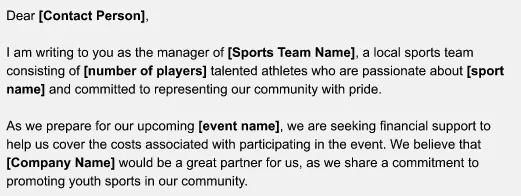
3. Sponsorship letter for auction items/in-kind donations

4. Sponsorship letter for acknowledgment

5. Sponsorship letter for requesting volunteers
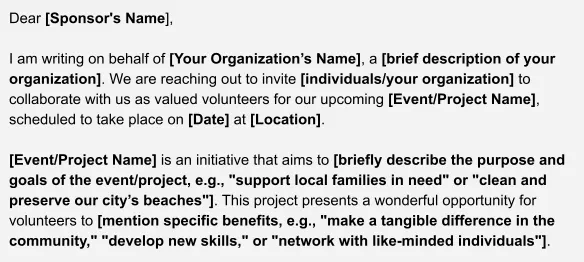
6. Food donation sponsorship letter
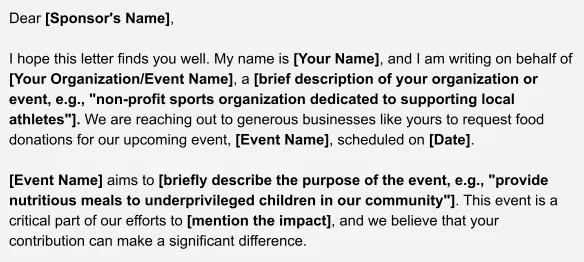
7. Follow up letter
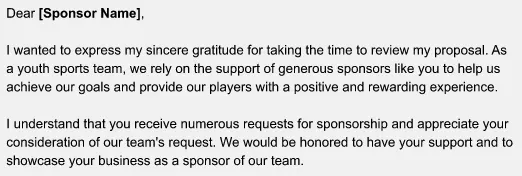
Tips for writing your sponsorship proposal
Personalize the sponsor letter, keep it concise, highlight the benefits.

Why send a sponsorship request letter?
Get the funding you need today .
- Community Company Press Careers Legal
- Checking account
- MAJORITY Pay
- Money transfers
- Mobile top-ups
- International calling
- Help center
- Migrant Handbook
SELECT COUNTRY
Where are you from? We’ll tailor your experience to your home country.
SELECT LANGUAGE
Migrant resources, quick tips on how to write a sponsorship letter for a us visa [with samples].
![how to write letter of sponsorship Quick Tips on How to Write a Sponsorship Letter for a US Visa [with Samples]](https://www.datocms-assets.com/20859/1597733794-shutterstock272670137.jpg?auto=compress&auto=format%2Ccompress&fit=crop&fm=webp&w=870)
Plus, common sponsorship letter mistakes to avoid
Let’s face it, writing doesn’t get any easier when it’s an official letter to the US government. It’s a lot of pressure.
That’s why we’ve come up with these tips and tricks to make sure your sponsorship letter ticks all the necessary boxes.
Read on to find out everything you need to include in your sponsorship letter and how to avoid common mistakes. Plus, we’ve also added two sample sponsorship letters to inspire you!
What is a US visa sponsorship letter?
Although it is not a requirement, a US visitor visa (B-1/B-2) often includes a visa sponsorship letter to strengthen the nonimmigrant visa application. The US visa sponsorship letter is formally known as the letter of invitation.
Not including a sponsorship letter may not be grounds to reject a visa, but we strongly recommend including one.
Who can write a visa sponsorship letter?
Any US citizen or legal permanent resident can write a letter of invitation. The person must be able to prove their citizenship or legal status and also have some kind of relationship to you, whether that be friend, relative, or representative from a relevant institution. If a family member writes the letter, they will also be asked to prove their relationship to you.
By writing a visa sponsorship letter, the author shows their trust in you and also assumes some legal and financial responsibilities.
The do’s and don’t of writing a visa sponsorship letter
- DO write the letter in English. Other languages will not be accepted.
- DO state whether you are a US citizen or legal resident.
- DO state your relationship to the applicant.
- DO write the reason for the applicant’s visit, including the duration of their stay.
- DO have someone proofread your letter to make sure there are no errors.
- DON’T forget to include your contact details including full name, address, phone number, and email address.
- DON’T forget to include documentation regarding your residency status and/or your relationship to the applicant.
- DON’T submit a handwritten letter. It should be typed.
- DON’T forget to sign the letter at the end.
- DON’T forget to double check all the information is accurate including names and contact details.

Common sponsorship letter mistakes
The biggest mistake people make when writing a visa sponsorship letter or letter of invitation is forgetting to include all of the relevant information.
The second biggest mistake is including inaccurate or incomplete information. For example, writing someone’s nickname rather than their official legal name.
The easiest way to avoid these mistakes is to proofread the letter yourself but also have someone else take another look at it too. Share your letter with the applicant so they can verify all the information about them is correct, including their full name and contact details.
Another common mistake is writing the letter in the applicant’s native language. However, don’t forget the letter needs to be in English. If the applicant does not speak English, it’s a good idea to give them an overview of the contents beforehand in case they are asked about it in their interview.
Finally, don’t try to make the letter overly formal. Although the letter is going to the US government, its primary function is to provide general information and assurance that you are willing to take responsibility for the applicant during their trip to the US. Just focus on keeping your sentences short and to the point. Resist the urge to over-explain or go into unnecessary detail.

Sample sponsorship letters for visa
Need some inspiration. Check out our sample invite letters for US visas–one addressed to the consular officer and one to the applicant.
Visa sponsorship letter sample to the consular
United States Consulate General
[Address of the Consulate]
Dear Honorable Consul,
[Visitor’s Name] – PASSPORT NO XXXXXXXX – Born on [Visitor’s Date of Birth]
My name is [Host’s full name], residing at [Host’s address] and I am a [United States citizen/legal permanent resident], as proven by the attached documentation.
I am writing on behalf of [Applicant’s full name] who resides at [Applicant’s address] requesting that you issue him/her a tourist (B-2) visa. [Applicant’s name] is my [Describe relationship; i.e. father, sister, friend] and I would like for him/her to visit me in the United States.
[Applicant’s name] intends to visit me from [Date of entry] to [Date of exit]. During his/her stay in the United States, he/she will stay with me at my home at the address stated above. I will be responsible for [Applicant’s name] during his/her stay in the United States, after which he/she will return to [Applicant’s hometown, country].
[Applicant’s name] will be presenting this letter to you during his/her interview, together with evidence to establish his/her close ties with [Applicant’s home country], assuring you that he/she will return after the expiration of his/her stay in the United States.
Your time and consideration for this request is greatly appreciated.
Kind regards,
[Host’s name]
[Host’s address]
[Host’s phone number]
[Host’s email address]
[Host’s signature]
Visa sponsorship letter sample to the applicant
[Host’s full name]
[Full address]
[Applicant’s full name]
[Applicant’s address]
Dear [Applicant],
I happily invite you to visit me in [City], USA. This will be a great opportunity for you to see the United States and experience both the culture and lifestyle firsthand. We have several trips planned to visit famous tourist attractions such as [name of tourist place to visit near you].
I will be taking care of you during your entire trip to the US, including expenses such as food, housing, medical costs and all your other personal expenses.
Attached, I am also including all the required documentation for getting the necessary tourist visa from the US Consulate in [Location of US Consulate]
[Host ‘s full name]
Related articles
The MAJORITY app facilitates banking services through Axiom Bank, N.A. Member FDIC.
The MAJORITY card is issued by Axiom Bank, N.A. Member FDIC, pursuant to a license from Visa U.S.A. Inc.
Transactions may be subject to limitations under applicable law, including the Bank Secrecy Act and anti-money laundering laws. Please refer to our terms and conditions for more information.
© 2019–2024 MAJORITY USA, LLC. All rights reserved.
MAJORITY, 2509 N. Miami Avenue #101, Miami, Florida 33127
Small Business Resources is now the Center for Business Empowerment.
Suggested Keywords
Center for Business Empowerment
How to get sponsorships for your business
January 24, 2024 | 6 minute read

Written by Steve Strauss Founder MrAllBiz
The senior small business columnist for USA Today, Steve is also a brand ambassador with 20 years of experience and the author of 18 books, including his latest, Your Small Business Boom.
If you are like a lot of small business owners, you are often trying to figure out new and unique ways to grow your business . Should you upsell more to current clients or offer new, better, cheaper, or more expensive products or services?
One option to consider is corporate sponsorship.
For a small business, it makes a lot of sense to target corporate sponsors because such sponsors are on the lookout for programs, events, contests, and other opportunities to build their brand and spread their message. Additionally, corporate clients have bigger budgets than individuals or other small businesses, and that in turn means they have money to spend hiring or buying from you. Accordingly, if your business has a customer base that dovetails with a specific corporate need or interest, then a sponsorship can be yours.
What is a sponsorship?
Simply put, a sponsorship is when a corporation gives money or resources to a business or non-profit in exchange for promotion to that other entity’s customers.
For example, when a sports team sells the naming rights to a stadium, that is a sponsorship. The corporation get its name on the stadium (and all related events), the sports team gets a sizable fee, and both get exposure to each other’s customers.
Sponsorship may look different for a small business. A corporation might want to sponsor your website or social media contest. A bar or restaurant may have a special night or event that might fit a corporate sponsor. A shoe store could team up with a sports show company for an annual hike or marathon. The key is to find a sponsor whose target market matches your customer base.
As such, a sponsorship is (or should be) a win-win. The corporation gets in front of a new audience, and the small business gets corporate dollars and the opportunity to co-brand with a better-known entity.
Types of sponsorships
The first thing to understand is that there are a variety of ways that a sponsorship deal can be structured.
- Financial sponsorships: funding is given by the corporate sponsor to the small business in exchange for publicity, exposure, or other similar perks.
- In-kind sponsorships: occur when, like a financial sponsorship, the sponsor donates goods, expertise, and other products or services. The in-kind goods could really be almost anything: Contest prizes, a venue, food, etc.
- Media and promotional sponsorships: the sponsor might give the small business free or discounted advertising or other similar media exposure.
How to get a sponsorship in 5 steps
Corporate sponsorships take effort and forethought. Getting one, the right one, is a step-by-step process.
1. Figure out what the sponsor will sponsor
Before you can approach a potential sponsor, and before deciding whom to approach, you need to know what the sponsorship will entail. Is it an event, a program, or something else?
2. Connect with sponsors
Begin by brainstorming. What you are looking for is a company that is “like” yours in terms of customer demographics, values, outlook, and so on. The obvious place to begin therefore is with your own suppliers and wholesalers. After all, you sell their products, they (presumably) like working with you, and your audiences similar.
By the same token, however, look at your competitors. Do they have companies with whom they work with that might be a good fit?
And beyond the low-hanging fruit of your own sphere, there are also several other places to look in your sponsor quest, including:
Online search
One of the best ways to find a sponsor is to find similar events or programs to the one you want to host that have already occurred. What corporate sponsors helped with that event? Bingo. You just found likely sponsors for your program too.
Social media
Almost all sponsorships are run through a corporation’s marketing department. As such, once you have identified the companies most likely to be receptive to your pitch, it is then just a matter of using LinkedIn to locate the right folks within those departments.
Online sponsorship platforms
A quick Google search will uncover several online platforms that can help you get connected to sponsors. Try starting with SponsorPitch.com .
Live events
Now that people are back to attending trade shows, conferences, and other similar business events, it would behoove you to attend a few in your industry. Nothing beats the one-on-one interaction and relationship building that can come from these sorts of events.
3. Understand your “unique selling proposition”
The questions you must first answer for yourself is why a corporation would:
- Want to team up with your business, and
- Sponsor this particular event
As you will see below, you will need to put together a sponsorship proposal. That proposal is your selling tool and it must answer these same two questions. You need to be able to succinctly explain what makes your business unique, different, and special, and why this event will help the corporation.
That last point is critical to understand. A sponsorship is a business deal. It has to make sense for the sponsor. What do they want? The answer is the same thing as what you want: to sell more and grow their business. So, you must give your pitch in that sort of language. You need to be able to show why doing business with you helps their business.
4. Develop your sponsorship package
Once you have identified the right company or companies to pitch, you will then begin the real work. You will need to sell them on the idea of sponsoring your event or program and begin to do that by having a great sponsorship proposal. That proposal should include the following:
- Business overview : An overview of your business and why they would want to do business with you.
- Event or program overview: An overview of the event or program and why it makes sense for them to sponsor it. This should include hard data and analytics of the event, the people it will attract, how many people it will attract, how it will be promoted, and so on.
- Sponsorship benefits : This should include the various ways the sponsor will be able to interact with your audience – signage, advertising and marketing, access to mailing lists, etc. Additionally, consider other ways to help the sponsor such as giving them tickets, discounts and so forth.
Lastly, you need to find the right people within the organization to send your pitch to. It is usually the Marketing Department, but searching on LinkedIn, or even calling the company directly to verify who managers sponsorships and their contact information is recommended. Next, you will need to speak with those people and then send them your sponsorship proposal.
Then it is a matter of doing what you know how to do: Sell. Sell them on you, your business, the event, and the sponsorship.
In the end, while getting a sponsorship is a lot of work, it is well worth it as it can take your business to the next level.
Explore more

How to generate sales leads for your business

11 strategies to grow your business
Important Disclosures and Information
Bank of America engages with Steve Strauss to provide materials for informational purposes only, and is not responsible for, and does not guarantee or endorse any of the third-party products or services mentioned. All third-party logos and company names mentioned herein are the property of their respective owners and are used under license from Steve Strauss.
Bank of America, Merrill, their affiliates and advisors do not provide legal, tax or accounting advice. Consult your own legal and/or tax advisors before making any financial decisions. Any informational materials provided are for your discussion or review purposes only. The content on the Center for Business Empowerment (including, without limitations, third party and any Bank of America content) is provided “as is” and carries no express or implied warranties, or promise or guaranty of success. Bank of America does not warrant or guarantee the accuracy, reliability, completeness, usefulness, non-infringement of intellectual property rights, or quality of any content, regardless of who originates that content, and disclaims the same to the extent allowable by law. All third party trademarks, service marks, trade names and logos referenced in this material are the property of their respective owners. Bank of America does not deliver and is not responsible for the products, services or performance of any third party.
Not all materials on the Center for Business Empowerment will be available in Spanish.
Certain links may direct you away from Bank of America to unaffiliated sites. Bank of America has not been involved in the preparation of the content supplied at unaffiliated sites and does not guarantee or assume any responsibility for their content. When you visit these sites, you are agreeing to all of their terms of use, including their privacy and security policies.
Credit cards, credit lines and loans are subject to credit approval and creditworthiness. Some restrictions may apply.
Merrill Lynch, Pierce, Fenner & Smith Incorporated (also referred to as “MLPF&S" or “Merrill") makes available certain investment products sponsored, managed, distributed or provided by companies that are affiliates of Bank of America Corporation (“BofA Corp."). MLPF&S is a registered broker-dealer, registered investment adviser, Member SIPC , and a wholly owned subsidiary of BofA Corp.
Banking products are provided by Bank of America, N.A., and affiliated banks, Members FDIC, and wholly owned subsidiaries of BofA Corp.
“Bank of America” and “BofA Securities” are the marketing names used by the Global Banking and Global Markets division of Bank of America Corporation. Lending, derivatives, other commercial banking activities, and trading in certain financial instruments are performed globally by banking affiliates of Bank of America Corporation, including Bank of America, N.A., Member FDIC. Trading in securities and financial instruments, and strategic advisory, and other investment banking activities, are performed globally by investment banking affiliates of Bank of America Corporation (“Investment Banking Affiliates”), including, in the United States, BofA Securities, Inc., which is a registered broker-dealer and Member of SIPC , and, in other jurisdictions, by locally registered entities. BofA Securities, Inc. is a registered futures commission merchant with the CFTC and a member of the NFA.
Investment products:

IMAGES
VIDEO
COMMENTS
Make sure the letter is signed by the president or an executive of your non-profit so your recipient can feel assured that it's professional and legitimate. Include your charitable registration number too. 7. Get someone your sponsor knows to write the letter.
5. Follow-up. You've heard it before: the money is in the follow-up. While your initial letter is important, following up can be just as impactful. Be respectful but persistent in maintaining contact, pointing to the clear benefits of what's in it for them with every touch. This goes for after your event, too.
Final paragraph — Finish your letter by letting your prospect sponsor know how you are planning to follow. For example, you could say that you plan on calling up within the week to hear their thoughts. Closing — Finish off as you started with a professional "Kind regards" or "Yours sincerely". Your name and signature — A letter ...
In short, a sponsorship letter is a type of letter you write to ask someone or a company to support an event, activity, or project. The support can come in different forms, like money, products, or services. Sponsorship letters are not just about asking for help. They play a big role in creating strong connections between people or groups.
A sponsorship letter is a donation request that asks a company or individual to sponsor an upcoming event, project, or activity. The purpose of this kind of fundraising letter is to convince the benefactor that your fundraising event or project deserves their support.
Dear [sponsor's name], My name is [name] and I'm the [position] of [name of team/club]. [Talk about your team/club/group and its members. For instance, if you're the head of a little league soccer team, you should mention that your team is for girls under 15 years old. Don't forget to mention your accomplishments!]
Why you can trust Sponsorship Collective. The Sponsorship Collective has worked with over 1000 clients from every property type all over North America and Europe, working with properties at the $50,000 level to multi-million dollar campaigns, events and multi-year naming rights deals; We have published over 300 YouTube videos, written over 500,000 words on the topic and published dozens of ...
People who give more should get more. An advertising banner, a public announcement about the company or sponsorship, and the company's logo appearing on a website or in promotional materials or programs are all examples of benefits you could offer. 5. Determine the name of the specific person who should get the letter.
Best Practices for Writing Monetary Sponsorship Letters. Address the Right Person. Large companies might have designated corporate social responsibility (CSR) departments and managers that handle all donation requests. Smaller companies might rely on the CEO or other leader to make charitable decisions.
The sponsorship level is categorized primarily: the silver sponsorship level, the bronze sponsorship level, and the Gold sponsorship letter. While writing this letter, you can mention a few king-don donations incentives. Make sure you create a hierarchy of giving levels and entail a place for donors to state their giving level.
Sponsorship letter for event: Dear Jessica, I hope you are doing well. My name is Susanna, and I am the Philanthropy Coordinator at Paws for a Cause. We are dedicated to improving the lives of dogs through rescue and rehabilitation and by promoting responsible dog ownership.
Sponsorship Request Letter Sample. Subject: Sponsorship opportunity | Business Name x Your Nonprofit's Name. Hi [Recipient's Name], We at [Your NPO] have been following the work of your business. [Business Name]'s mission and vision of [include vision and/or mission] are in line with the values we hold as a team.
Tips for Writing a Great Sponsorship Letter . Lead in with your connection: If you know, someone that is connected to the sponsor or you have already met with the sponsor at an event, start with that, then proceed with the money request. Personalize letter: In as much as it takes more time and effort to draft a personalized letter, it is important than simply inserting some names into a ...
Include the sponsor's address, full name, and proper title. Use the appropriate salutation. Mention your reason for writing in the first paragraph. Lead with your connection to the sponsor. Familiarize the sponsor with your company or organization. Personalize your letter. Keep your letter short and to the point.
How To Write a Sponsorship Letter: A Step-by-Step Guide. Writing an effective sponsorship letter is crucial to convey your message, outlining the benefits of sponsoring your event, and generating interest from potential sponsors. Here is a step-by-step guide to help you craft a compelling sponsorship letter: 1. Start with a professional but ...
Step 2: Write a two to three paragraph of your opportunity. This will re-iterate facts about the event benefits, and features. Step 3: Give a detailed overview of the audience, markets and overall media reach of the event. Let them know what kind of public relations support will be included in their sponsorship.
4. Write that letter! You know the why, what, who, and when, so you're ready to write. Include an organizational intro, explain the upcoming event, highlight the impact of those generous donations, and detail the sponsorship benefits. Then, personalize the whole shebang based on who you're writing. 5.
Here is a template you can use to create a sponsorship letter for an event. [Date] [Recipient's name] [Recipient's title] [Name of organization] [Street address of organization] [City, state and postal code of organization] Dear [applicable honorific and surname of recipient], [Write a hook to engage the recipient.
We've written a free sample to help you write your next team sponsorship letter. Click here to download the full sample now! 4. Sponsorship letter for auction items/in-kind donations. Requests for auction items or other in-kind gifts get the best response rates.
Let's look at the different types of sponsorship letters available to improve your fundraising efforts. 1. Sports sponsorship letter. Copy and paste the following letter into a Google Doc and tweak it for your team. Or, download it here . You can adjust the letter to match your league and fundraising goals. [Date]
Enclosed with this letter, you will find a detailed sponsorship proposal, outlining the various levels of sponsorship and the corresponding benefits. We would be happy to discuss this proposal in more detail at your earliest convenience and explore how we can form a fruitful partnership. Thank you for considering our request.
Write methods to contact you. In the top left corner of the letter, include a heading of your first and last name, phone number and email address. Your contact information can assure that the prospect knows how to reach out to you if they're interested in sponsoring your cause. Address the prospect by name.
By writing a visa sponsorship letter, the author shows their trust in you and also assumes some legal and financial responsibilities. The do's and don't of writing a visa sponsorship letter. DO write the letter in English. Other languages will not be accepted. DO state whether you are a US citizen or legal resident.
How to get a sponsorship in 5 steps. Corporate sponsorships take effort and forethought. Getting one, the right one, is a step-by-step process. 1. Figure out what the sponsor will sponsor. Before you can approach a potential sponsor, and before deciding whom to approach, you need to know what the sponsorship will entail.